Attention Desert Rat, your interior doors are ready!
In 2022 we were contacted by B-17E Desert Rat Restoration Project, asking about interior doors. We provided a quote based on the materials and labor and, come December, we were able to get started.
The setup of her interior doors was very much the same as those on Lucky Thirteen. The aircraft was fitted with a total of four interior doors. These were located at Sta. 4 (at the back of the cockpit), Sta. 5 (front wall of the radio room), Sta. 6 (back wall of the radio room), and Sta. 9 (behind the tail wheel).
The first three were hollow-core types, measuring .75” thick and being composed of spruce stiffeners between Douglas fir veneers. The last was a 5/16” thick fir sheet of plywood braced with an X-stiffener made of spruce.
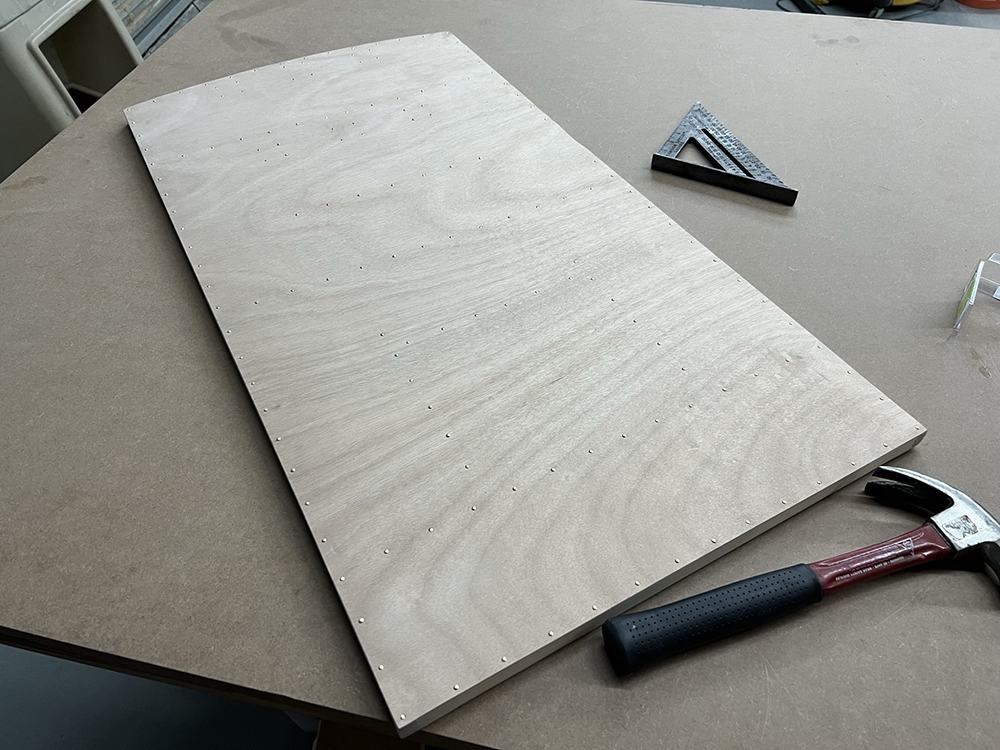
The cockpit door for Desert Rat.
The blueprints call for staples or brad nails to reinforce the wood glue, which at that time, was not as strong as it is today. Each brad is spaced 1.5 inch apart.
Photo taken 26 December 2022.

The interior of the cockpit door for Desert Rat.
The only changes from the original blueprint was the addition of reinforcements for the arch and hinges. This will ensure the door is slightly stronger than the original design.
The cockpit door is one of the more complex pieces of carpentry on the B-17. Deadwood is installed for the fuel system and data charts (which were framed on older B-17s), for the armor door plate, and for the Flight Reports Folder.
Photo taken 22 December 2022.
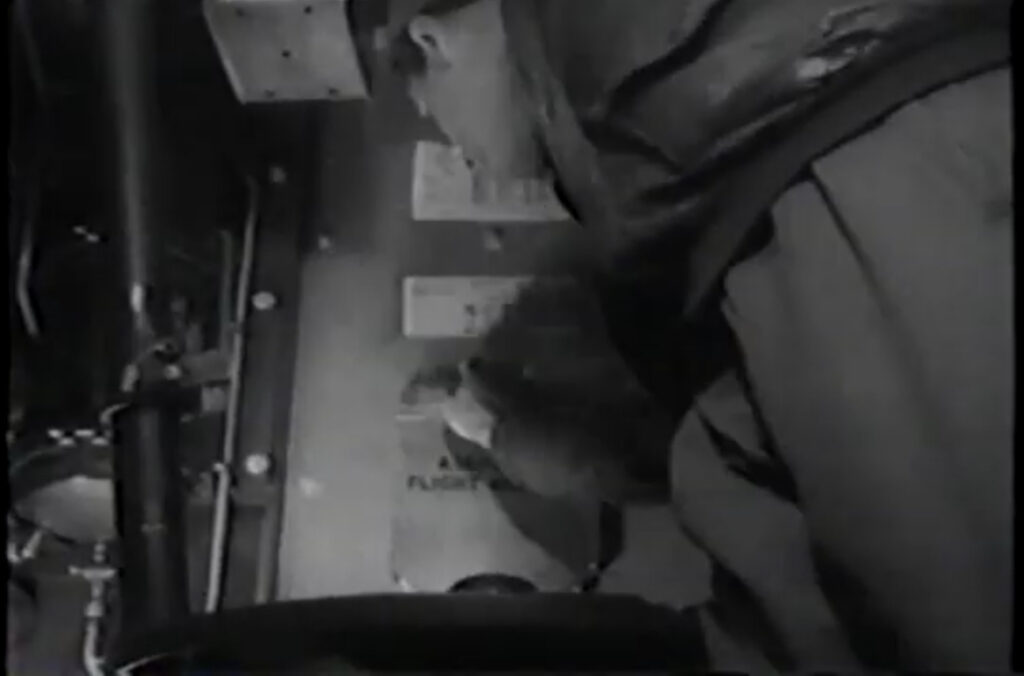
A screenshot from How to Fly the B-17 Flying Fortress showing the cockpit door.
The upper chart is of the bomber’s fuel system, the center chart a data card referencing the print numbers for the aircraft’s major systems, and the wooden folder is the Flight Reports Folder.
Since this is an F-model B-17, these charts are glued to the wood rather than held in little frames.
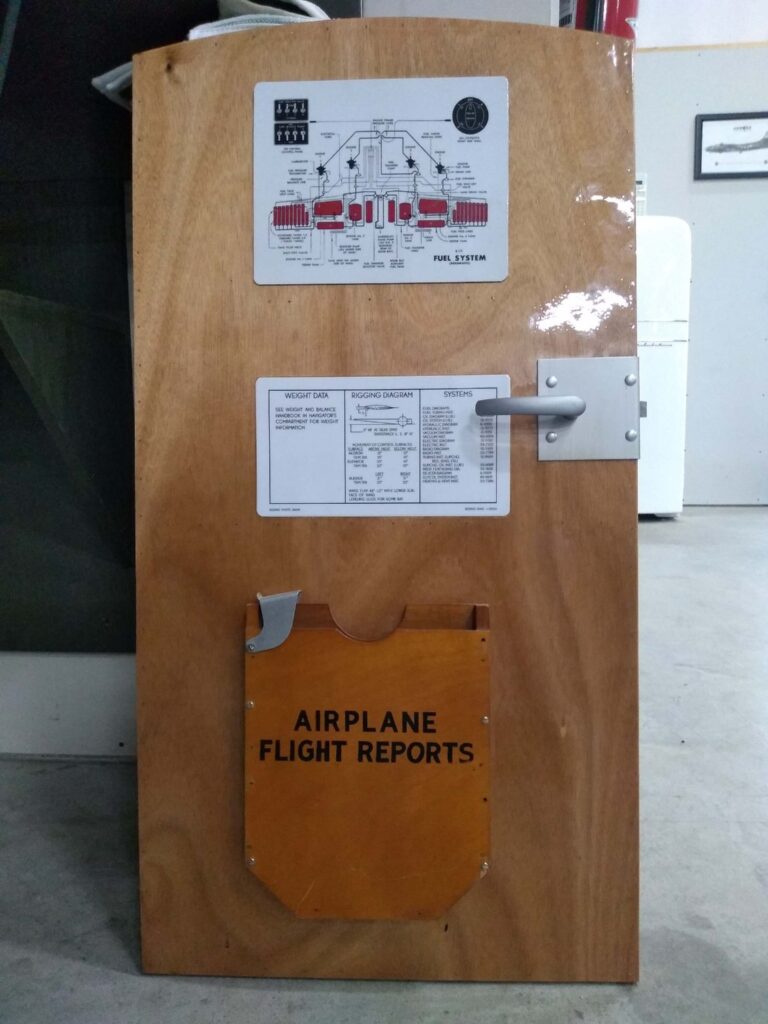
The cockpit door to Lucky Thirteen.
Ours friends at Asheville Metal Finishing recently clear anodized the hardware for this door.
The latch assembly and Flight Reports Folder are wartime original.
Photo taken 15 December 2022
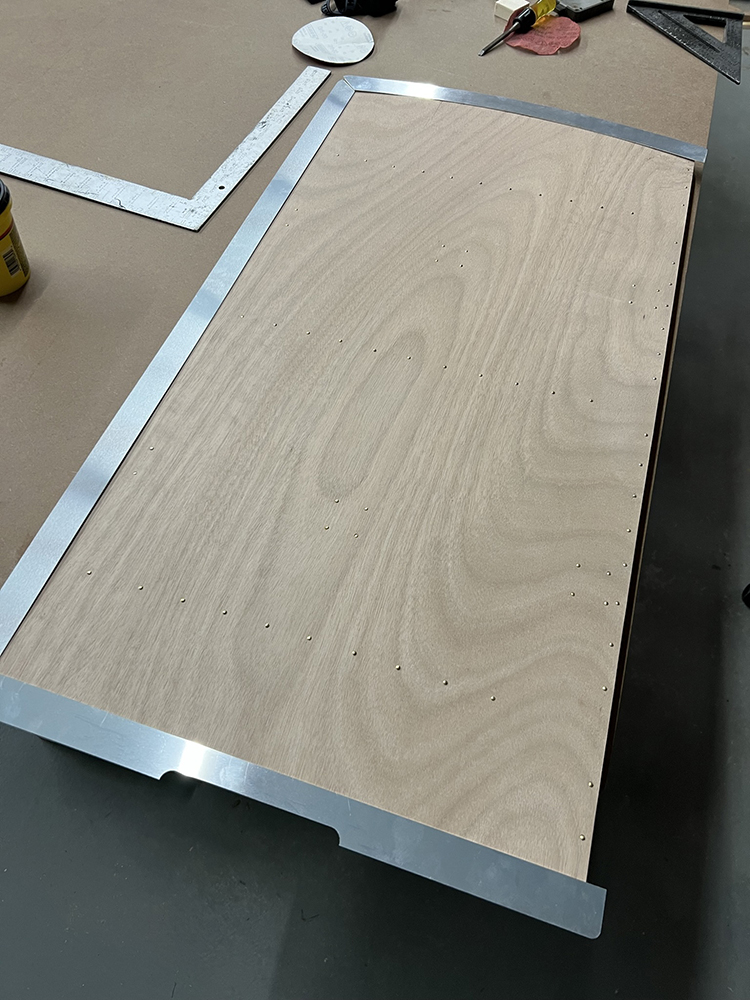
Our friend Eric Miller of Project Warbird brought the correct metal for the interior door trim on Lucky Thirteen during his recent visit.
Since I was working on the doors for Desert Rat, it was an excellent opportunity to test the fit.
Photo taken 26 December 2022.
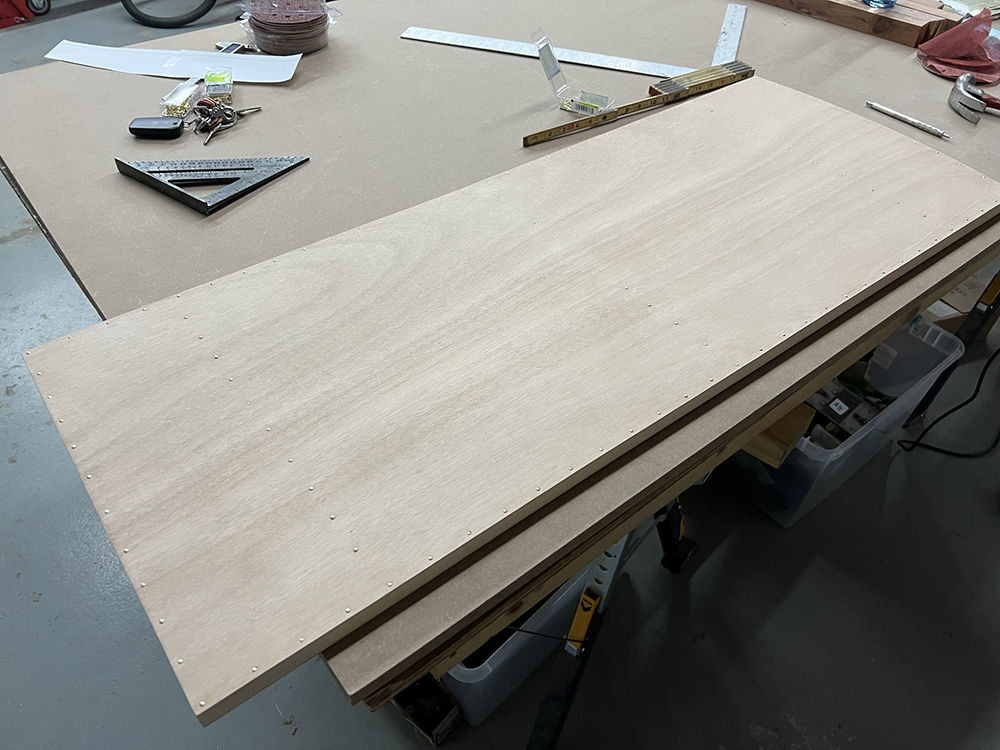
The forward radio room door for Desert Rat.
This is the side that faces the bomb bay.
Photo taken 15 December 2022.
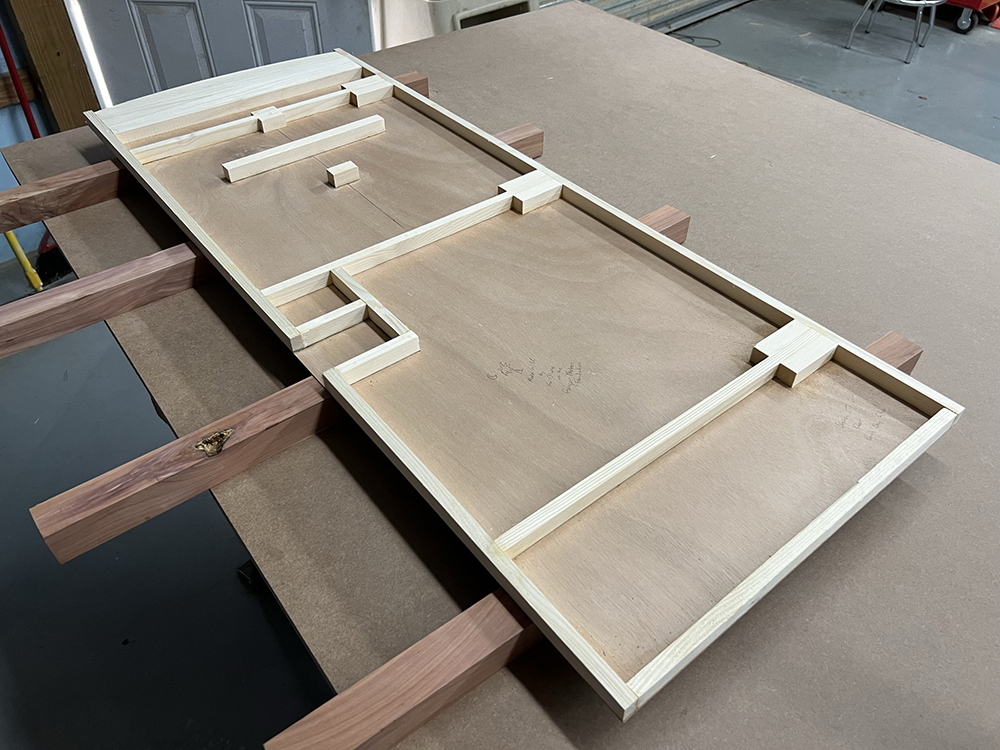
The interior of the forward radio room door for Desert Rat.
Notice the cutout on the left – it is a pocket for the door’s latch assembly.
The drawing inside is a Palmetto tree and a note saying it was made in South Carolina by the Hangar Thirteen Foundation!
Photo taken 9 December 2022.
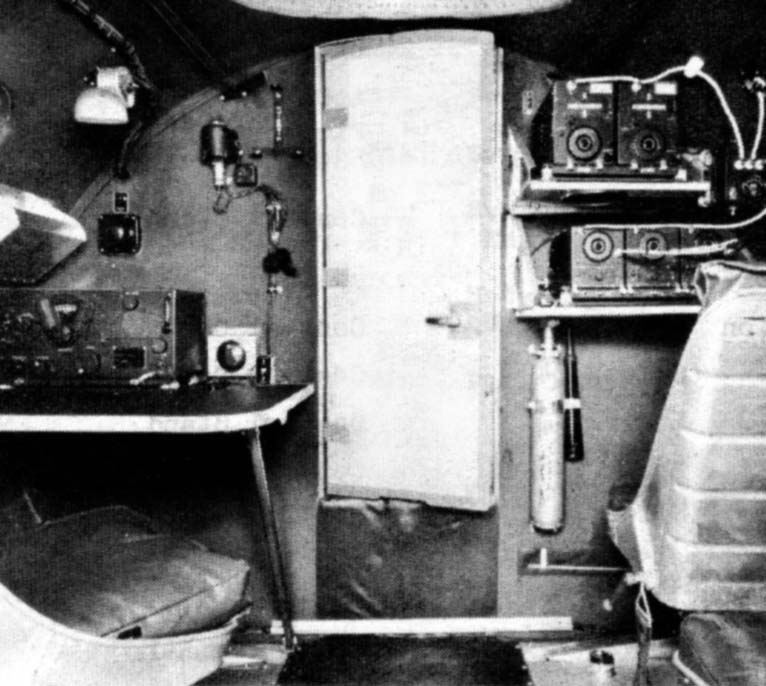
Manual illustration of the forward radio room door.
Note the dark color of the radio room table. E and early-F model B-17s had linoleum topped radio operator tables. We color matched this linoleum for Memphis Belle at the National Museum of the U.S. Air Force.

The forward radio room door for Lucky Thirteen, installed on Sta. 5.
The chart is a loading diagram for the bomb bay.
Photo taken 15 December 2022.
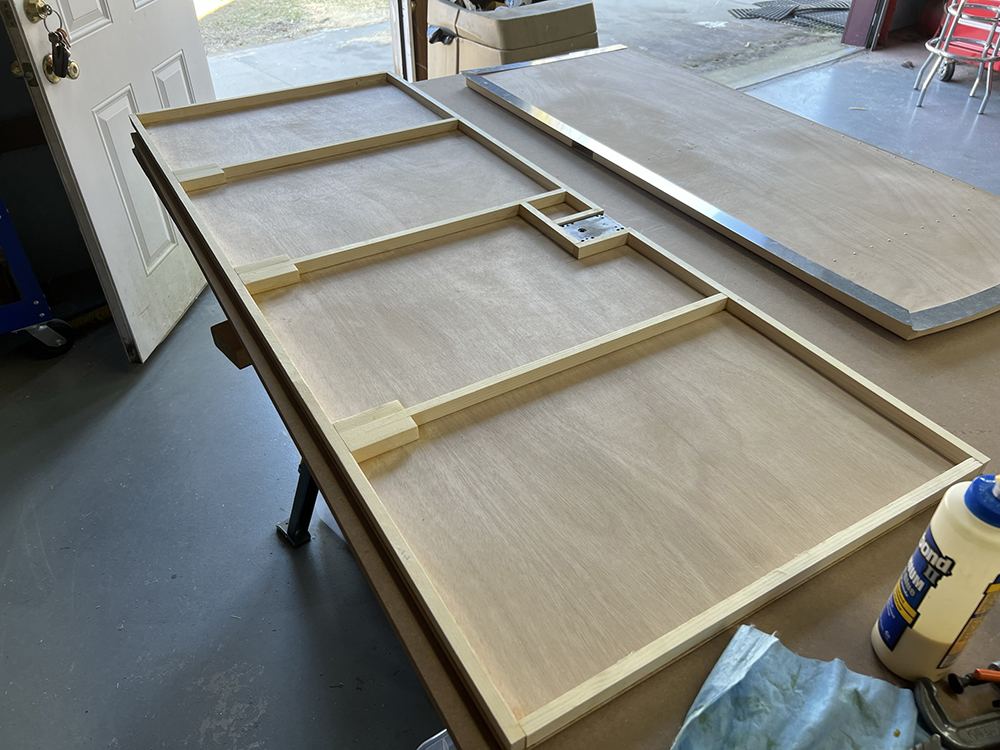
The interior of the rear radio room door for Desert Rat.
This door also has a cartoon hidden inside – “Kilroy Was Here.”
Photo taken 18 December 2022.

Test fitting the metal trim which goes on the radio room doors for Lucky Thirteen.
Photo taken 20 December 2022.
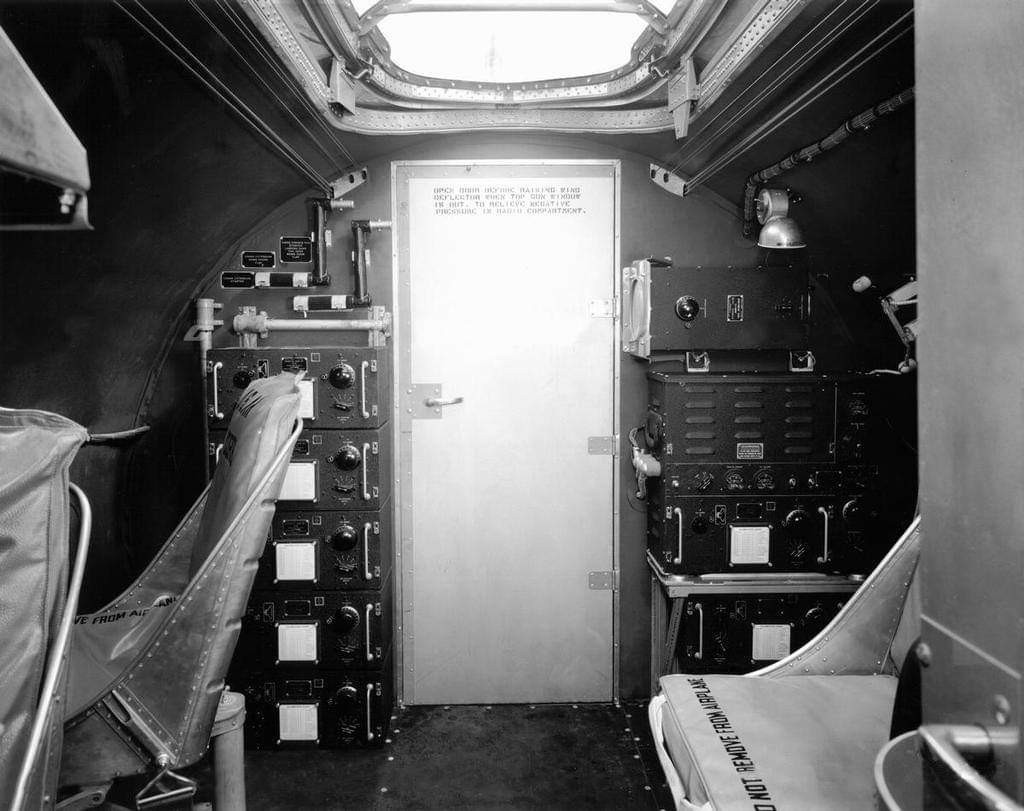
Manual photo of the rear radio compartment door.
Note the decal on top of the door, instructing the crew to open the door whenever the window hatch is open. This was to account for air flow.
In the field, this was problematic. Shells from the radio operator’s gun could fall into the ball turret’s gearing, and keeping the door closed meant that the crew could also not see one another. As such, this door was often sawed off to the upper hinge. Footage from William Wyler shows that this was done to Memphis Belle.
In the B-17G series, this issue was rectified by adding a screen window to the upper portion of the door.
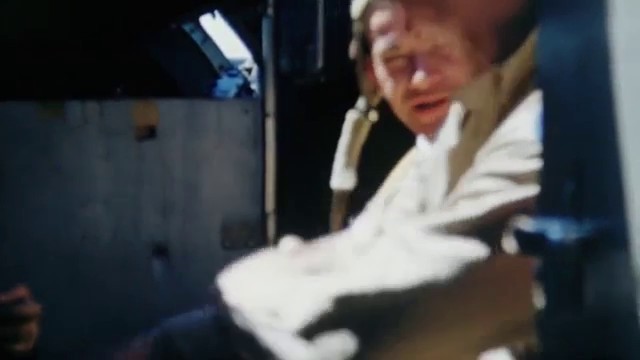
Screenshot from William Wyler’s footage showing the cropped door on Sta. 6.
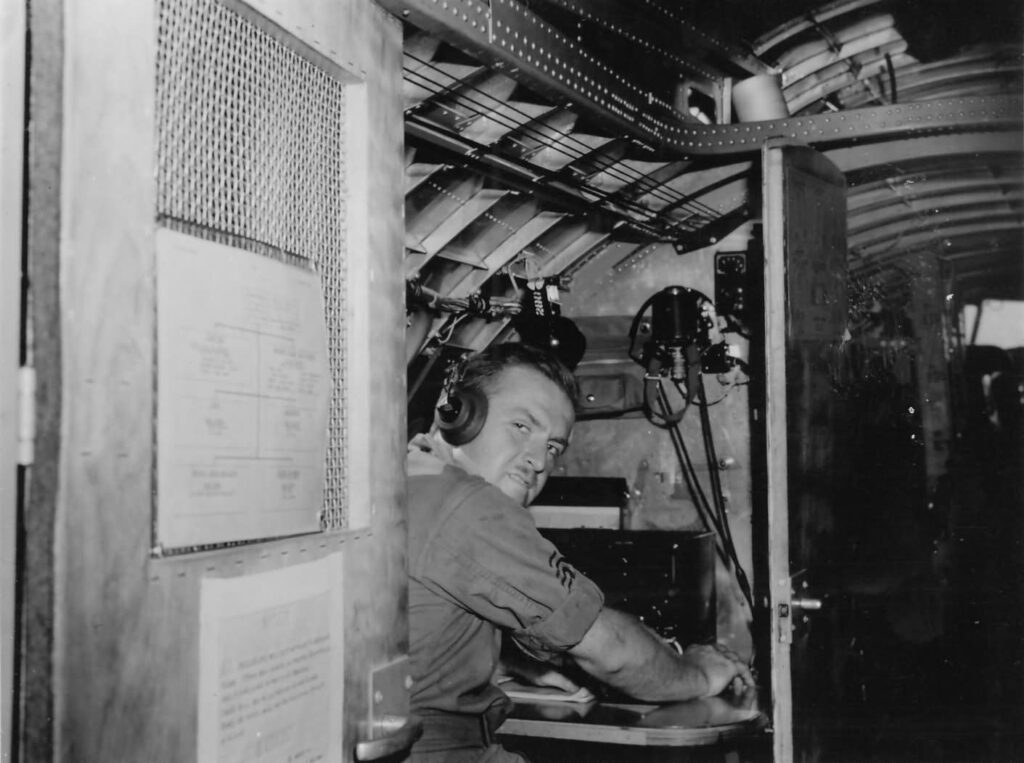
Photograph taken aboard a late G-model B-17 with a screen window in its Sta. 6. door.
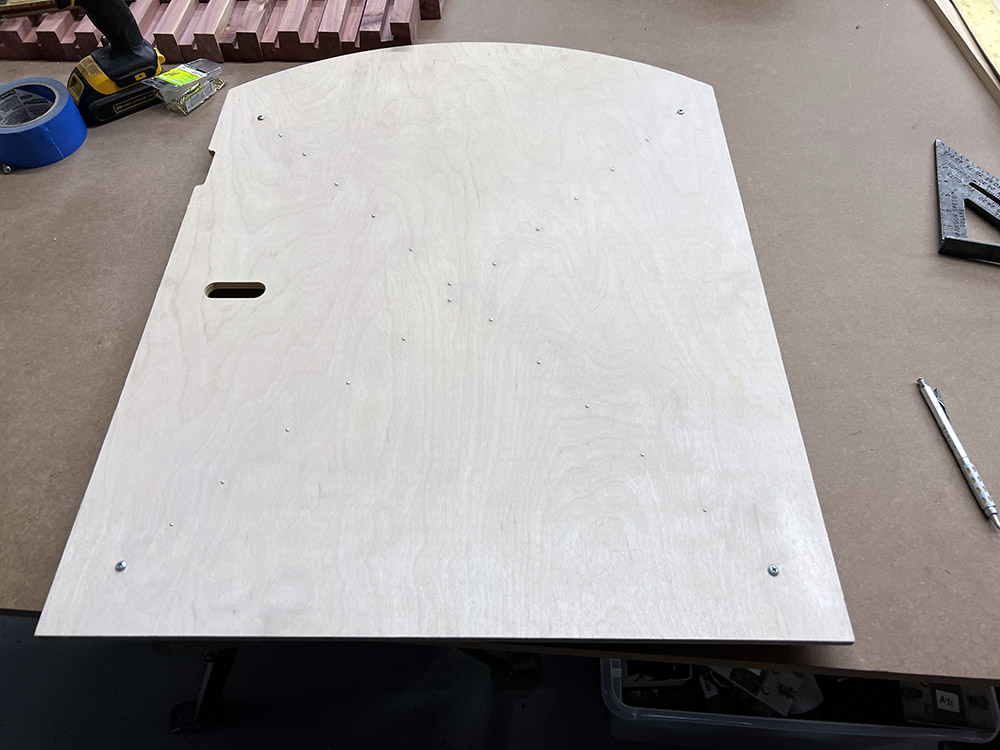
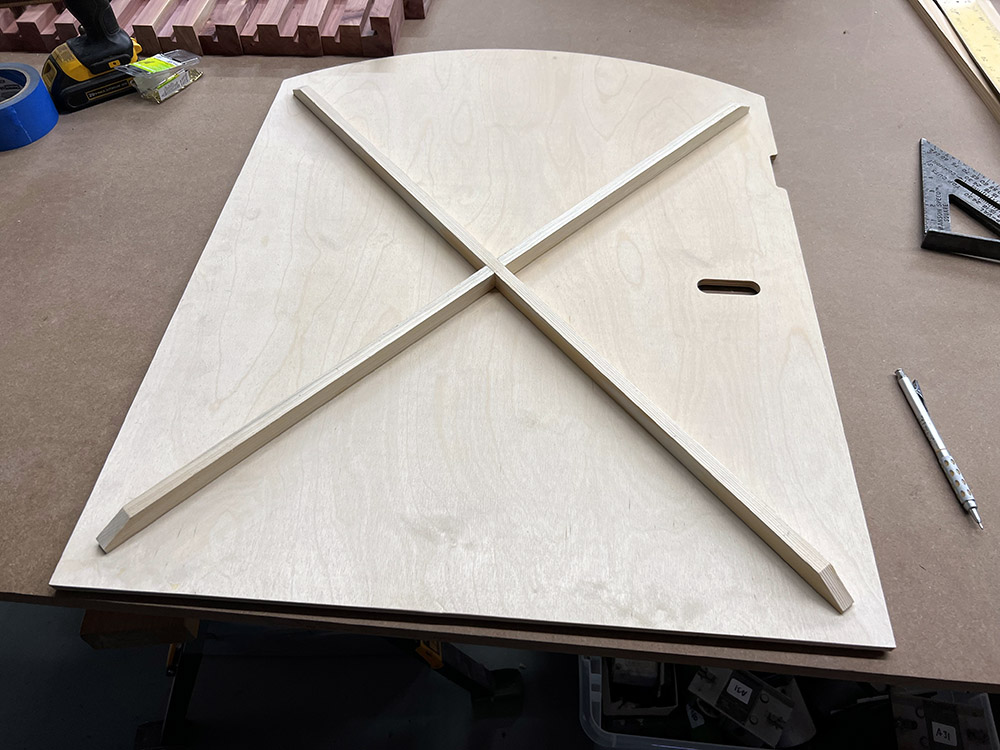
The tail gunner’s crawlway door, an artifact only found on E and F model B-17s.
Photo taken 4 January 2023.

A 3D rendering of the latch assembly for the tail gunner’s crawlway door, made by volunteer Bob Hachmann.
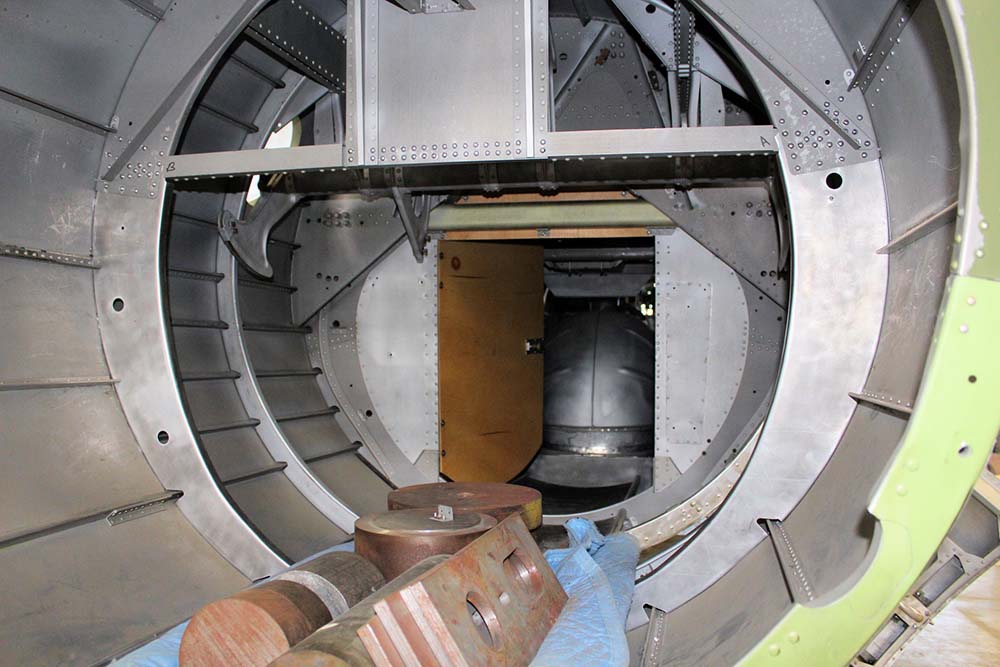
Photo taken by volunteer Karl Hauffe of the tail gunner crawlway door aboard Memphis Belle, while under restoration at the National Museum of the US Air Force.
On 15 December Eric Miller of Project Warbird came by and I helped apply the markings to one of his Vultee BT-13 instrument panels. We were very pleased with how it came out! Eric brought with him some aluminum for the interior door trim, which we were able to cut on the CNC. But more importantly, Eric also put the last touches on our autopilot amplifier. It is now completely restored.
Longtime followers might recall that this unit was purchased from Richard De Boer of the Calgary Mosquito Aircraft Preservation Society last year. The amplifier was missing its top panel and side-cap, and the casing was somewhat dented in the back. Thankfully, the interior was pristine. Our friend Dom Serong was amazing in providing us with measurements, photos, and videos so that we could recreate the missing parts. Bob Bennett of New Holland, South Carolina fabricated the new top and side-lid, and I recreated the missing dataplate and paper insert. Karl Hauffe painted the interior while I applied the baked-on exterior wrinkle paint. Eric took the last step of fixing the rear dent, riveting the top, and installing the dzus fasteners for the side-lid.
Special thanks to Bob Bennett, Karl Hauffe, Eric Miller, and especially Dom Serong for their help with this. I hope you guys are as happy as I am with the final result!
We are now only two pieces away from a complete Type C-1 Autopilot system. I only know of two complete, working systems and neither of them are in the US, so this is a rather ambitious goal for us.
The remaining pieces required are the junction box (which will likely require being made anew) and bombsight stabilizer. This later piece will be the most difficult as stabilizers are highly prized by collectors, and as such, are generally quite expensive. If you can help with this, please let us know!
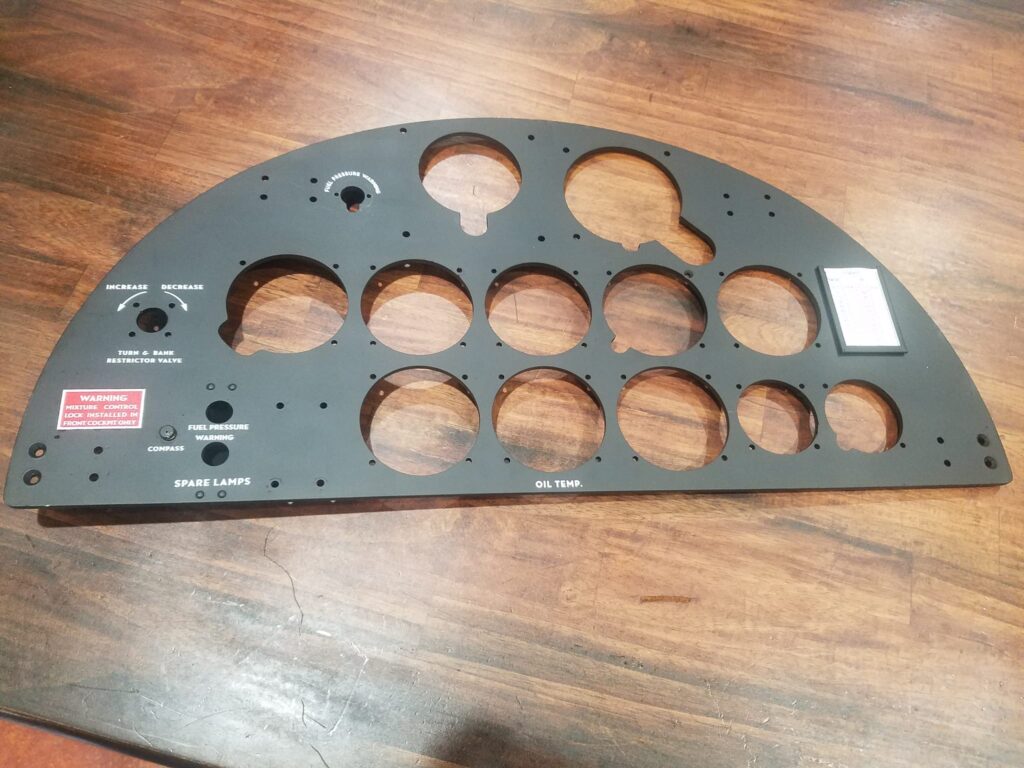
The markings are freshly applied to the first of Project Warbird’s Vultee BT-13 instrument panels.
Photo taken 15 December 2022.

The newly restored amplifier for the Honeywell Type C-1 Autopilot.
The dataplate is an exact replica of an original.
Photo taken 15 December 2022.
*We have since this update discovered the plate was mounted in the wrong spot, with a second, larger plate going in this place.
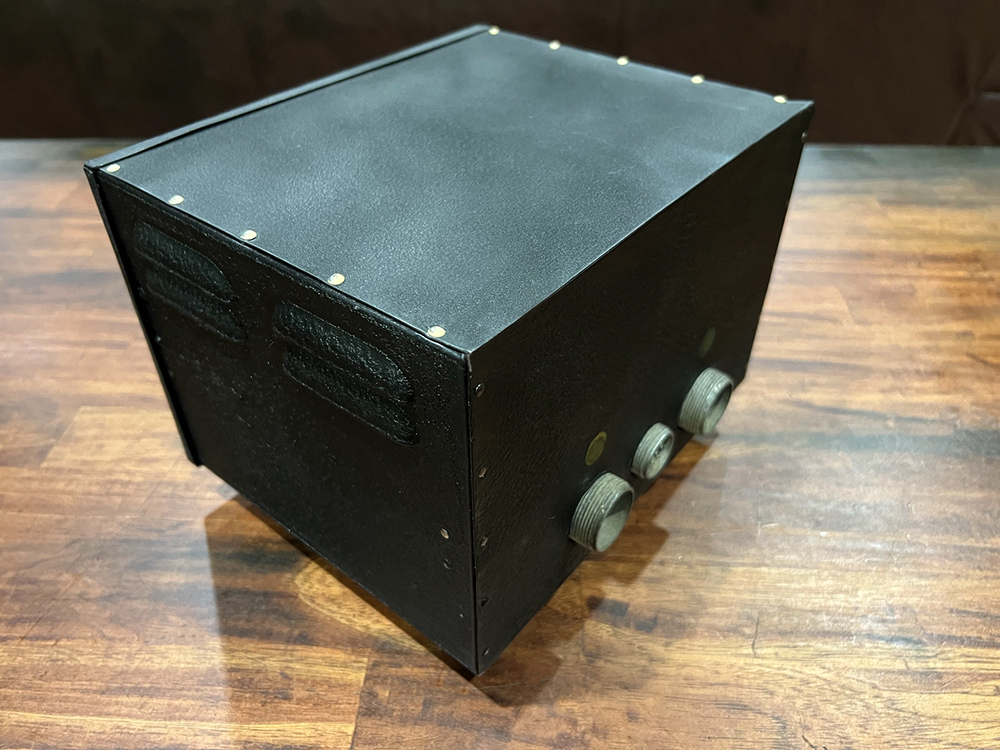
The newly restored amplifier for the Honeywell Type C-1 Autopilot.
The three plugs here correspond to the three servos, which were mounted throughout the aircraft. The control cables were routed through these servos and the autopilot tugged on them to maintain level flight. As such, each plug corresponds to an axis – pitch, roll, and yaw.
Photo taken 15 December 2022.
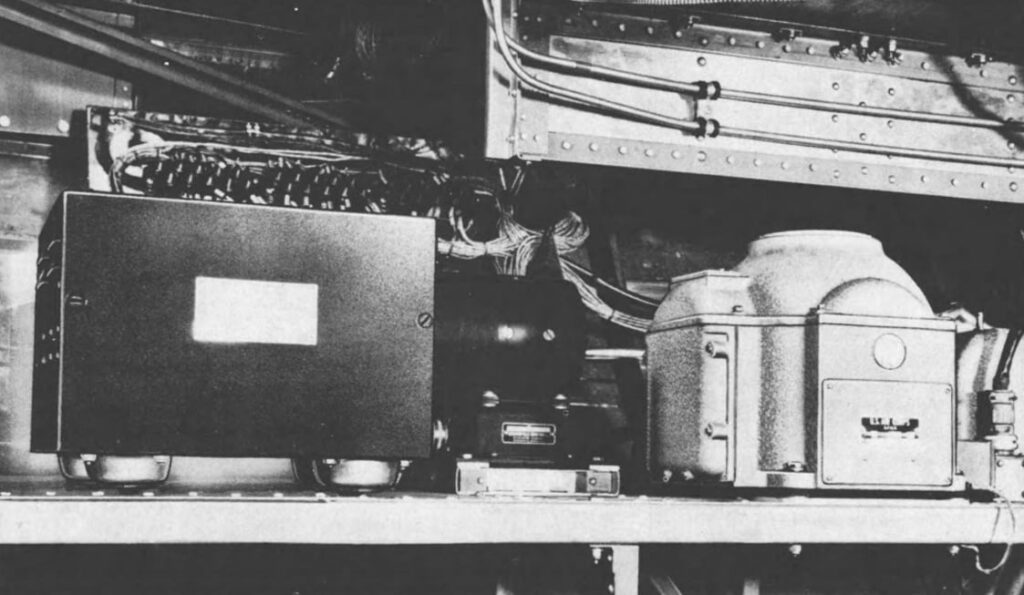
Manual illustration of the autopilot equipment that was mounted below the cockpit, in the forward crawlway.
The amplifier is visible on the left. To the right is the autopilot gyro. Our gyro is a combat veteran, taken from “K-King” (44-6139, 351BG), a Boeing B-17G which crash-landed near Villers-lez-Heest on 12 September 1944.
Between the amplifier and servo is the autopilot’s rotary inverter. We have both wartime variants thanks to a generous donation from Joe McKowen of Gaffney, South Carolina.
The autopilot junction box, which we currently lack, is visible behind these units. In this illustration, the top cover is removed.
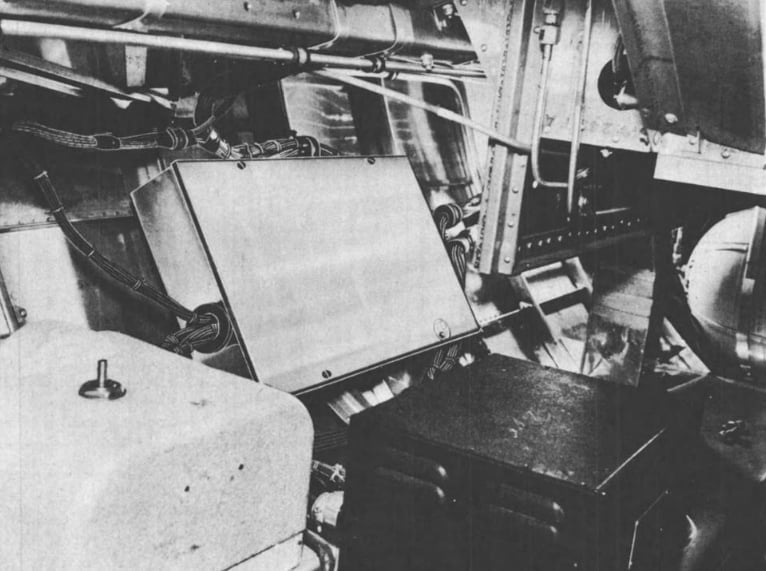
Another manual illustration of the autopilot equipment that was mounted below the cockpit, in the forward crawlway.
The amplifier is visible on the lower right.
The junction box, which we currently lack, is visible in the center with its cover in place.
The servo which controls the ailerons is visible on the bottom left. The elevator and rudder servos were mounted on a shelf above the tail wheel.
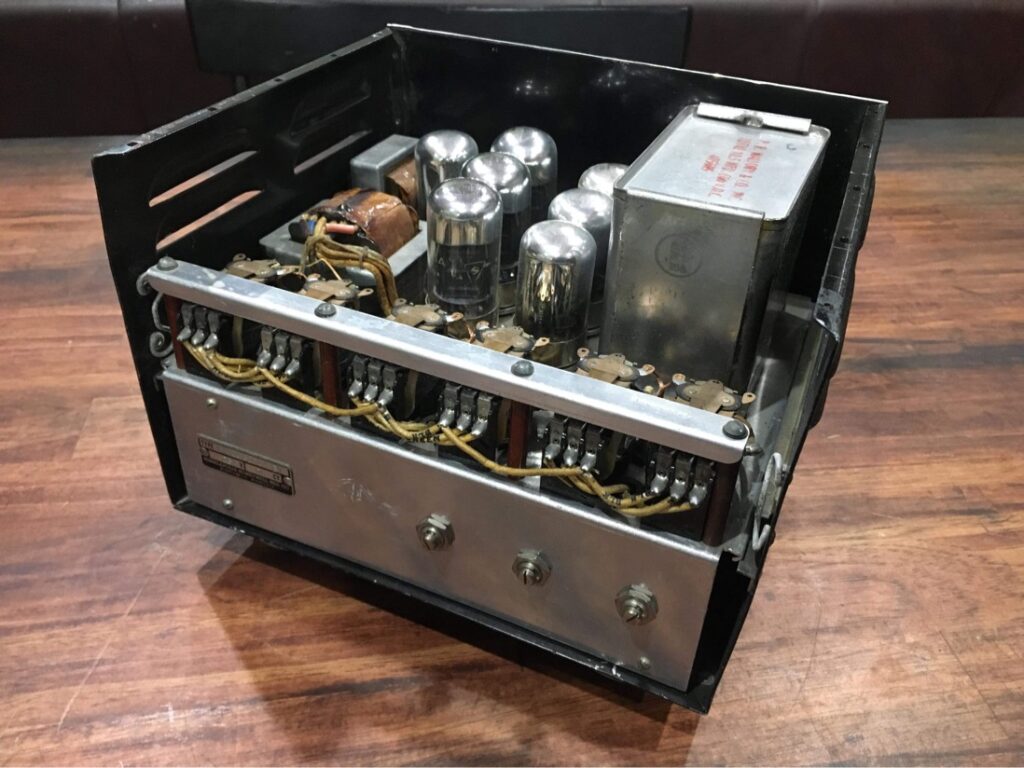
The amplifier for the Honeywell Type C-1 Autopilot when it first arrived.
Photo taken 24 October 2021.

The new top and side-cap made by Bob Bennett of New Holland, South Carolina for the Honeywell Type C-1 Autopilot.
Photo taken 11 June 2022.

The new top made by Bob Bennett of New Holland, South Carolina for the Honeywell Type C-1 Autopilot.
The original dent in the back is visible here. It was caused by the internal assembly, which slides on rails, being slid into place off center at some point in its past.
Photo taken 11 June 2022.
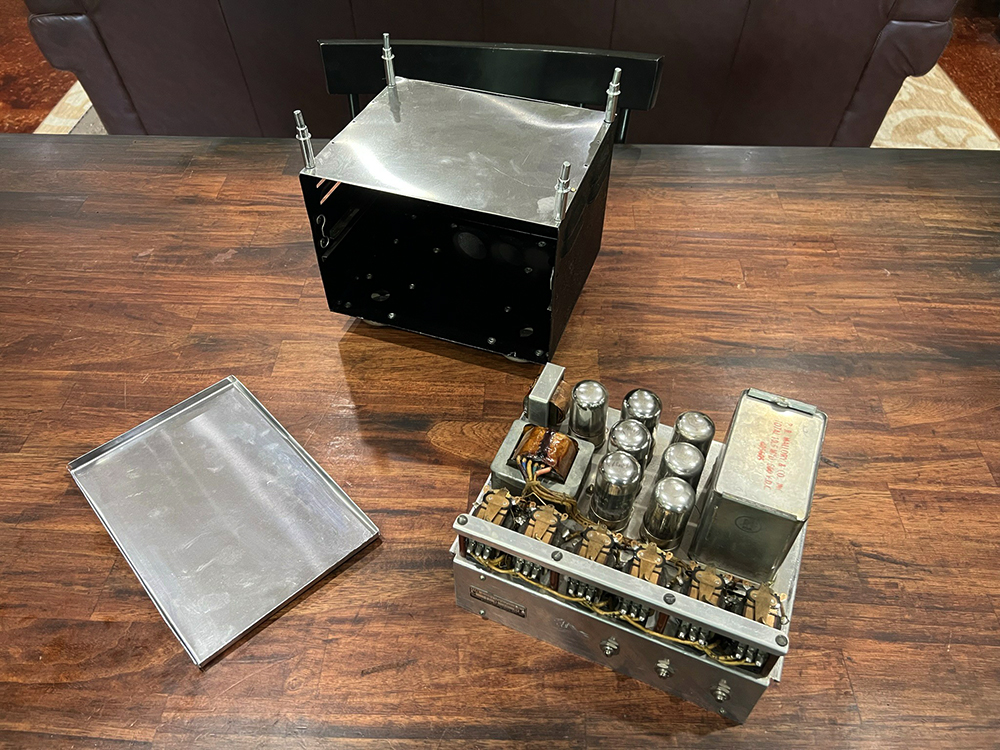
The new top and side-cap made by Bob Bennett of New Holland, South Carolina for the Honeywell Type C-1 Autopilot.
The internal assembly is slid out here.
Photo taken 11 June 2022.

A screenshot from a video Dom Serong sent explaining how the missing bits of the autopilot amplifier went together.
Dom accomplished a rare feat – he pronounced my name correctly on the first try!
Photo taken 22 November 2021.
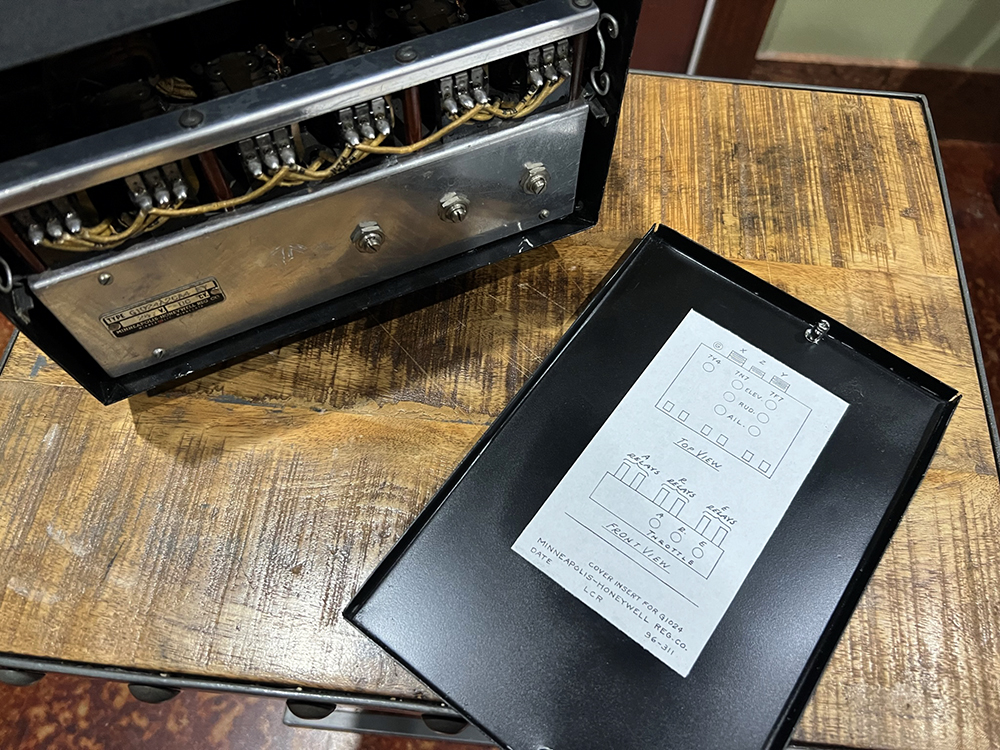
A close-up of the paper insert for the autopilot amplifier.
This insert is an exact copy of the one in Dom Serong’s amplifier and is even glued in slightly off-center to match.
Photo taken 15 December 2022.

Our current progress is gathering components for the Type C-1 Autopilot System. The pieces we have acquired are highlighted in red.
Not shown is the Norden bombsight head. Our friend Andy Rivera has offered us a beautiful example and is waiting for us to find a stabilizer we can mount it to.
I think you might enjoy this update, as it is about something rather unique – the Bullard First Aid Can.
The Boeing B-17 was equipped with a first aid kit for each of its major crew compartments. For the nose, cockpit, and radio room, the kits were canvas First Aid Kit – Aeronautics. Through the B-17C, D, E, and F series, the waist compartment was equipped with an aluminum can made by Bullard of San Francisco, California.
Mounted on Sta. 6 next to the IFF transponder, the Bullard can held a fold-out kit containing a military variant of one of Bullard’s existing first aid lines. It has taken us some time, but we have finally completed restocking the Bullard can for Lucky Thirteen!!!
We have also just received a massive donation of books and parts from our friend Bill Strawn of Deland, Florida. Bill has some 24 years of experience with the Collings Foundation, touring with their Boeing B-17 and Consolidated B-24, as well as maintaining them with American Aero down in New Smyrna Beach, Florida. He had some bits he wanted to contribute toward Lucky Thirteen and, in the process, also sent along some books that he had gathered over the years – many of which were given to him by veterans he met along the way.
It is going to take some time to go through everything but in the meantime I thought everyone might like to see it all laid out!

The newly arrived donation from Bill Strawn of Deland, Florida.
If you look closely, you can see some really amazing pieces in there!
Photo taken 11 December 2022.
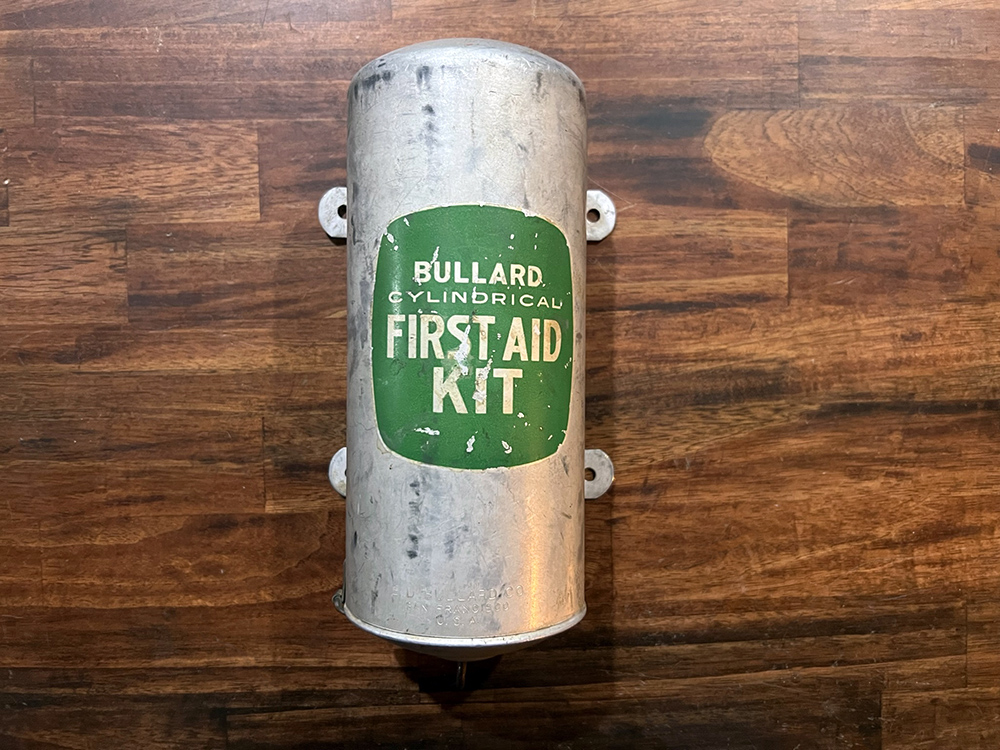
The Bullard First Aid for Lucky Thirteen.
Photo taken 5 December 2022.
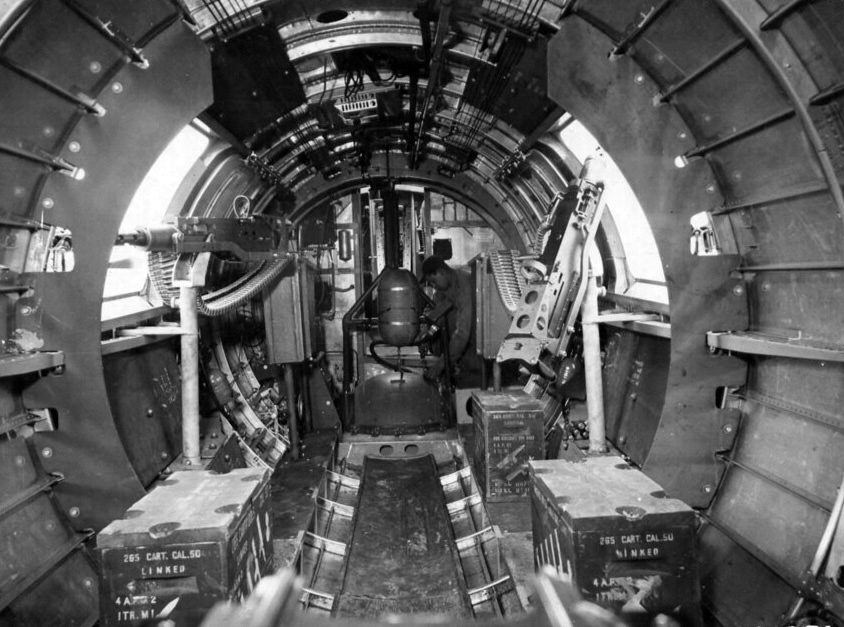
The waist compartment of an F-model B-17. Note the Bullard can, mounted between the Sta. 6 door and the IFF transponder.
We are currently working with Warbirds Of Glory to gather references on the detonator plug for the BC-966 Transponder.
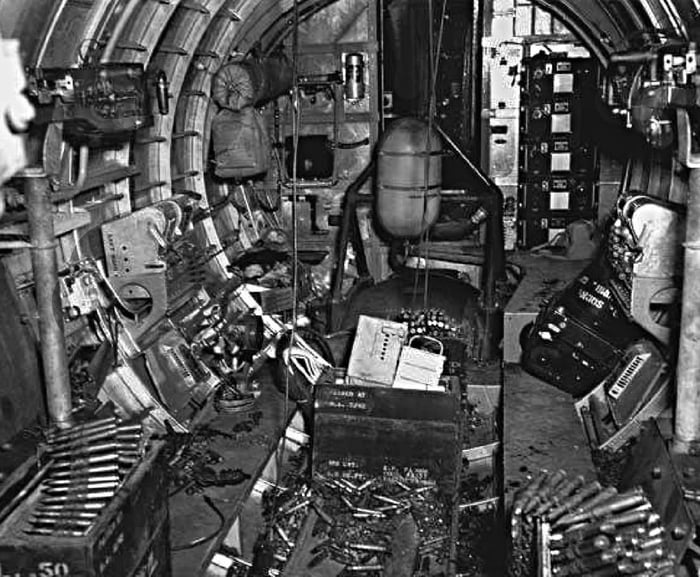
The waist compartment of an older F-model, shortly after a combat operation. The Bullard can is visible here as well.
Note that the IFF transponder has been removed. A top secret piece of equipment, photographs of this system were discouraged.
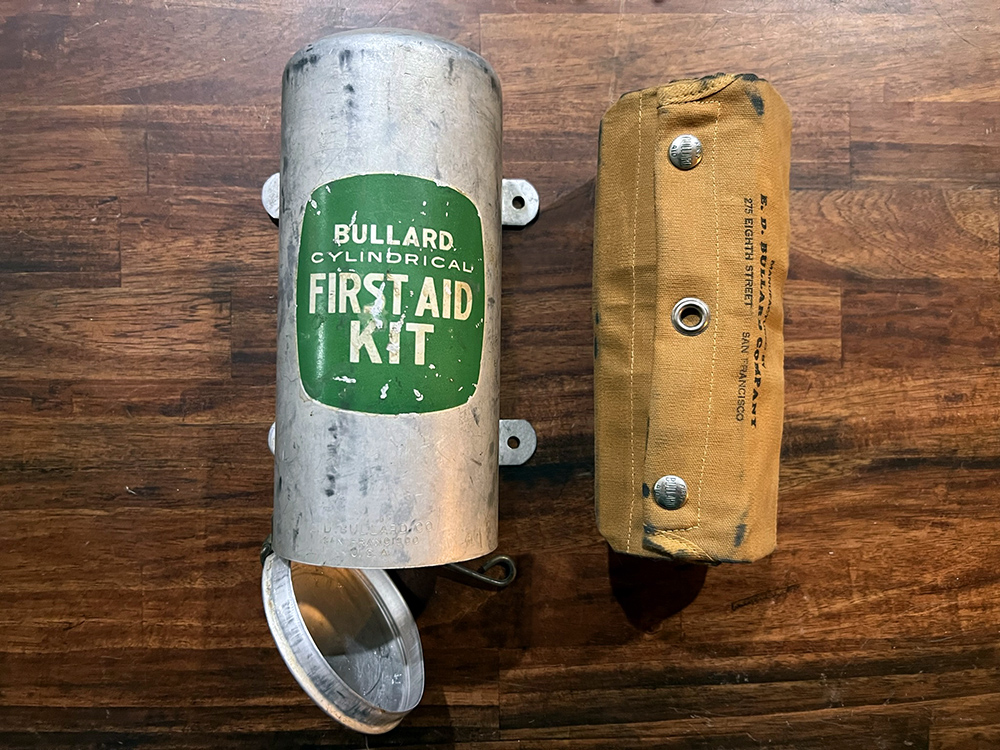
The contents of the Bullard can removed.
Photo taken 5 December 2022.

The first aid kit from the Bullard can after being unrolled.
While we were fortunate to locate a Bullard can that was rather complete early on, it nevertheless took us a long time to track down the missing components.
Photo taken 5 December 2022.
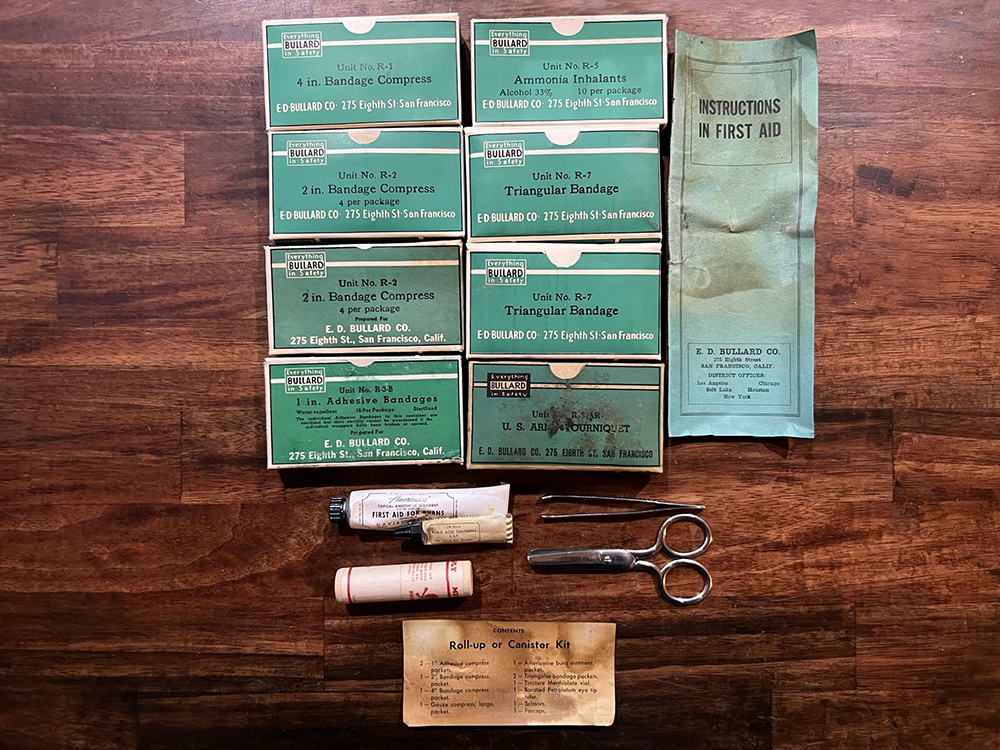
The contents of the Bullard first aid kit displayed on the table.
Some of these pieces, like the Bullard-brand Army tourniquet, are quite rare.
Photo taken 5 December 2022.
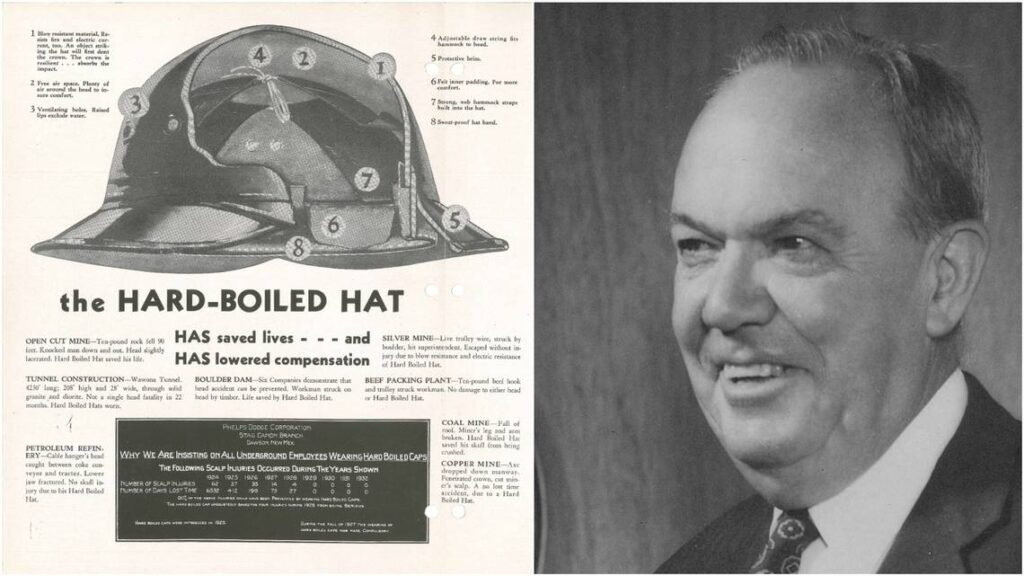
Based in Cynthiana, Kentucky and established in 1898 by Edward Dickinson Bullard, Bullard is best known for inventing the hard hat.
Bullard’s son returned from the Great War with the idea of producing helmets similar to those he wore in the Army for coal miners.
This was the genesis of their Hard-Boiled Hat – history’s first hardhat.
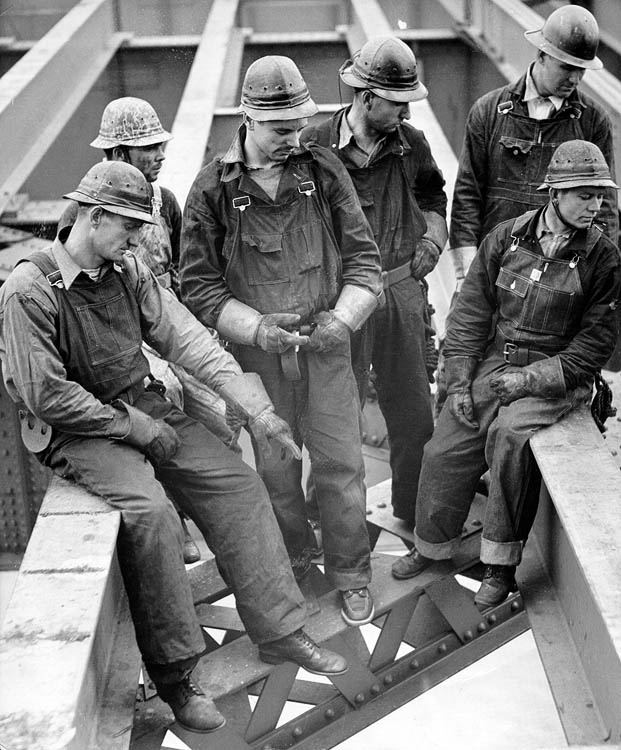
Bullard was later contracted to supply equipment for the construction of the Golden Gate Bridge.
This project resulted in a series of Bullard advances in safety, including steel hardhats and paint respirators.
We have a potpourri of various subjects to share in this Lucky Thirteen update.
First up is an incredible donation from our friend Harry Friedman of the Memphis Belle Memorial Association. Harry has contributed a NOS center glass panel for the project’s Type A-2 ball turret, as well as a set of servo wrenches for various aerial gunnery applications. While the other windows in the ball turret were acrylic, the center window was bulletproof glass, measuring 16 inches in diameter and .75 inches thick. Harry’s panel cleaned up beautifully and it is so clear that it is difficult to photograph. Thank you SO much, Harry, this is an incredible piece!
Next is an update on the center control panel. When I last posted about it, our friend Rian Olsen pointed out that I had made a mistake in painting the flap guard and mag linkage red. They should have been black. How I missed that, I have no idea! Duly noted, we set to work replacing these pieces. In the meantime, the screws were replaced as well. The blueprints regularly use the abbreviation “R. Head” for certain screws and, while I had assumed this meant “Round Head,” I recently found documentation that it actually meant “Recessed Head” – a period term for what we now called “Phillips Head” screws. Always learning! These new screws are all wartime NOS. I am happy to report that the center panel is now complete. All that is left is to paint the panel’s housing.
Work continues on the instrument panel and our friends Stijn Claus and Eric B Miller decided to also order dry transfers from the guys at ReproGraphX. Both of their projects needed UV glow transfers, which was new to ReproGraphx, so it was a great opportunity for some tests. There was some mix-up in the final order, as Eric’s transfers have yet to arrive and Stijn’s transfers came here instead of Belgium. Still, it was interesting to look over the final product. ReproGraphX had trouble getting the ink to stick to the glow material, so some of the markings are not visible under regular light. However, I am happy to report that they all glow as they should under UV light. So, we are heading in the right direction!
(I should note that while the markings on the center panel were white, the blueprints call for many of the markings on the instrument panel to glow under UV light. Got to pay close attention…)
Next, I wanted to talk about our friend Howard Lawson down in Florida. Howard is a visual technician, with a background creating 3D models for the various aviation corporate giants. Howard is currently working on a passion project, creating a virtual reality B-17G using original blueprints. The detail in his work is absolutely breathtaking, and we have been keeping in touch with one another now for almost a year.
And, Howard has been gracious enough to devote some of his time to side-projects for Lucky Thirteen. First was a trip to check out the Collings Foundation’s work on Shady Lady, regarding their ball turret. Their ball turret has early-style side-caps, which were only found on E and F-model B-17s. While they refused to consider a sell/trade/donation, they did allow Howard to drive down and measure the side-caps. Volunteer Bob Hachmann was able to create a model off of Howard’s measurements, but because the side-caps were not removed, the model is only halfway complete. We know someone who has unused examples of these caps, though he has yet to get back to us on the subject.
More successful has been our work on the bomber’s fire extinguishers. Lucky Thirteen carried three Type A-17 CO2 steel extinguishers (Kidde or Kelsey Hayes) and two Type A-2 Carbon Tet. brass extinguishers (Fyr Fyter). Thanks to the awesome efforts of volunteer Chris Ely, we have been able to track down three A-17s and two A-2s. Unfortunately, the third A-17 will require us swapping parts between damaged examples and replacing missing and broken parts. With exception of one of the A-2s, none of these units still have their wall mounts. And since they were GFE (Government Furnished Equipment), the blueprints no longer exist.
(If you have a complete A-17 CO2 or A-2 Carbon Tet. extinguisher, or have parts for either one, please do let us know!)
So, Howard set to work creating a 3D model of the CO2 extinguisher mounts based on the information we DID have available – mounting hole dimensions, manual drawings, and photographs taken by our friend Dave Littleton of the B-17 Cockpit Project. During this period, we were contacted by our friends at B-17E Desert Rat Restoration Project, as they found a source for the upper CO2 extinguisher mounts. That still leaves the bottoms. If originals are not forthcoming, we can use Howard’s models (which he is currently fine tuning) to create new ones. Special thanks to Howard Lawson and Chris Ely for their work on the extinguisher complement to Lucky Thirteen – this is going to be awesome.
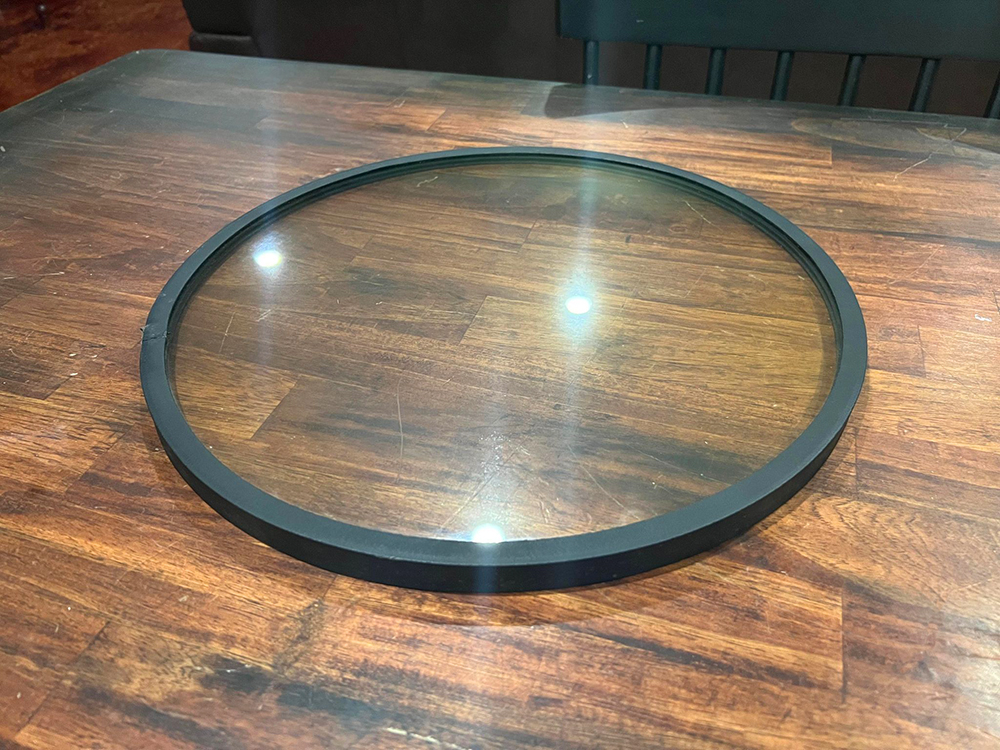
Harry’s newly arrived ball turret center window glass.
Few people have been as important to the B-17 preservation community as Dr. Harry Friedman, and we are honored by his contribution.
Photo taken 24 November 2022.
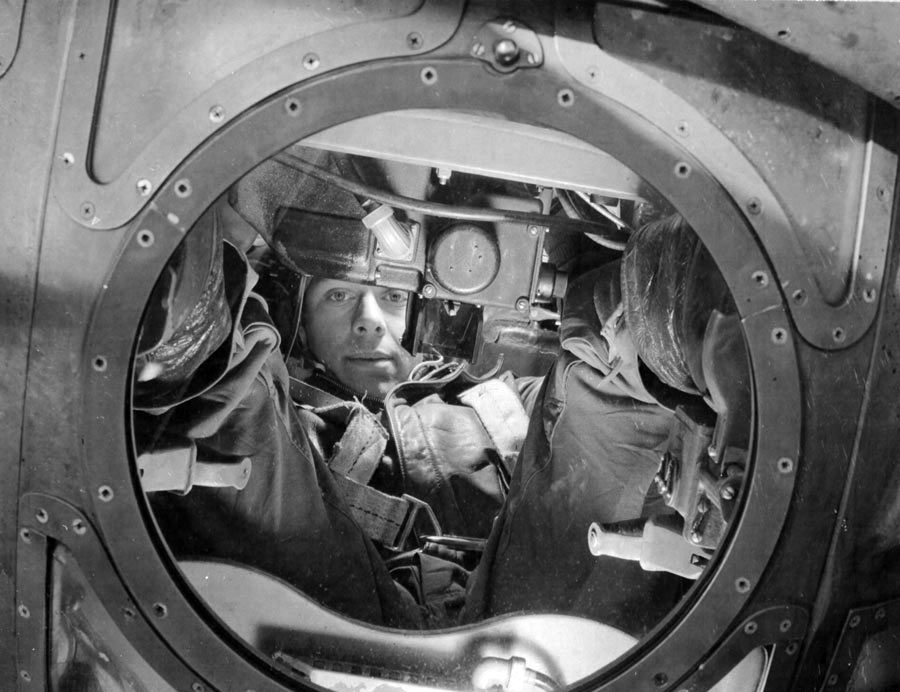
SSGT Earl J. King of the 303BG peers through the center window of a Type A-2 Ball Turret.
If you have any turret components that you would like to go to the project, please let us know!
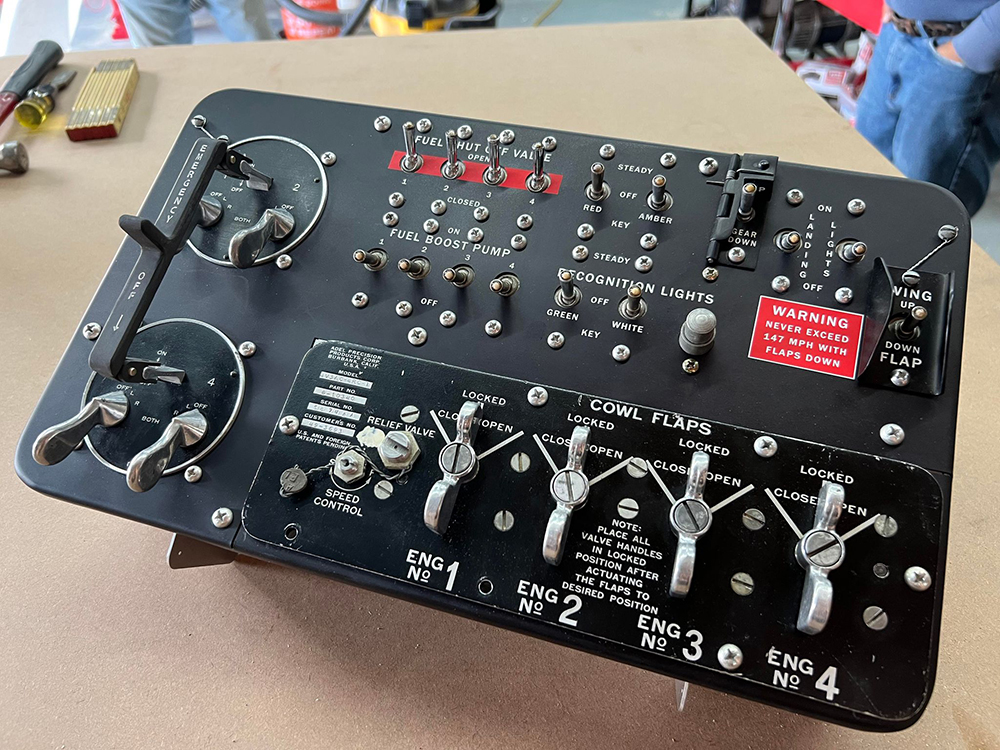
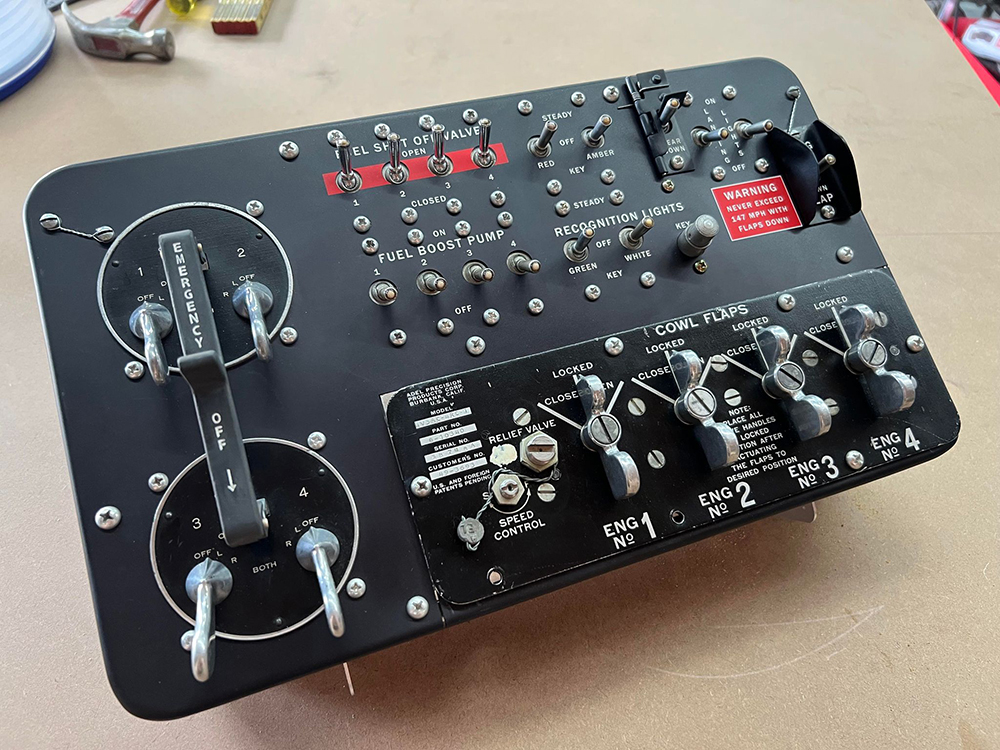
The completed center console.
Special thanks are due to Anton Hermans, Jimmy Rollison, Joe McKowen, Rian Olsen, Bob Hachmann, ReproGraphx, and Asheville Metal Finishing – without whom this accomplishment would have been impossible.
Photo taken 2 December 2022.
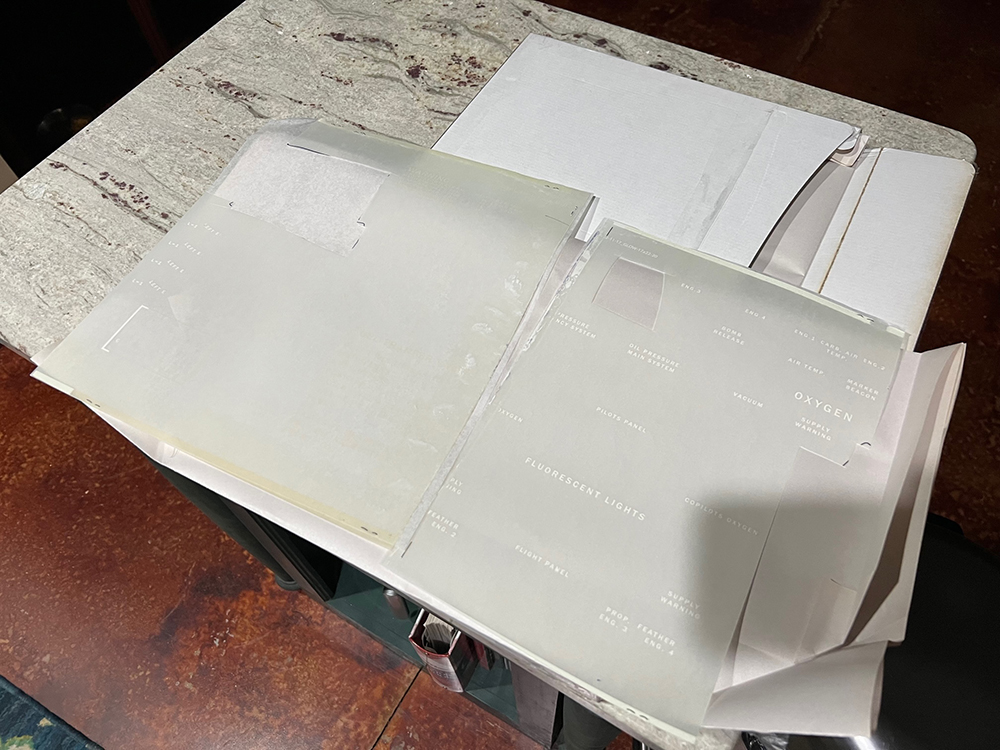
The B-17 panel glow-marking test sheet from ReproGraphx, intended for our friend Stijn Claus.
The white ink did not adhere properly to the glow ink on the right side of the left sheet.
Photo taken 21 November 2022.
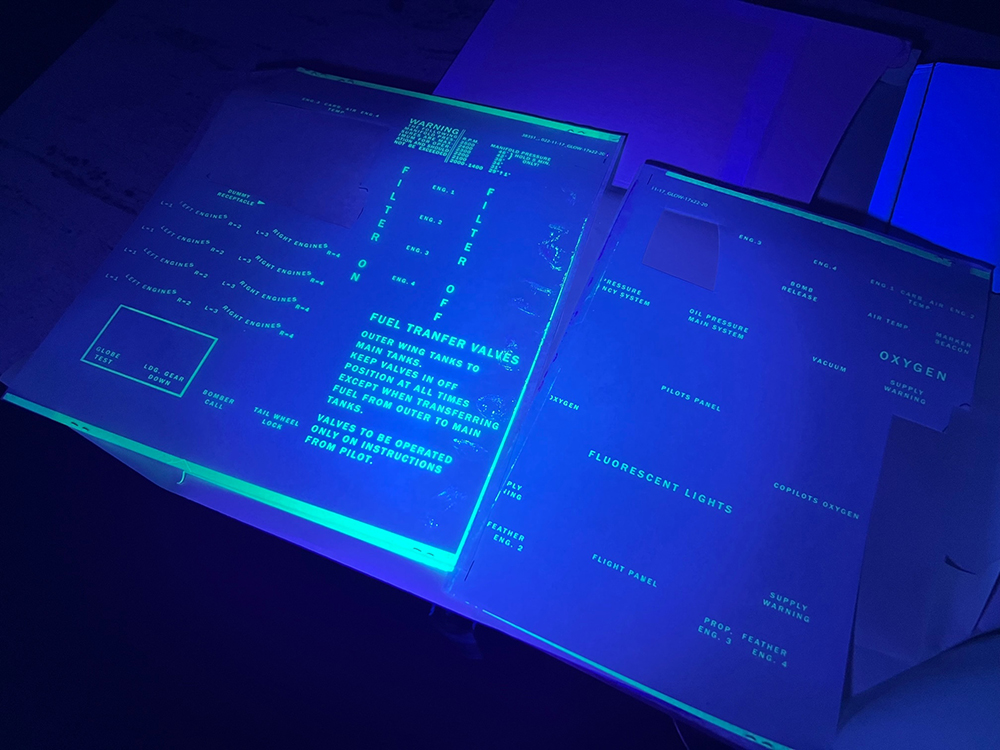
The B-17 panel glow marking test sheet from ReproGraphx, intended for our friend Stijn Claus.
This picture was taken with the UV light shining directly on the transfers. As you can see, while the white ink may have fallen off on the right side of the left page, the glow ink remained.
Photo taken 21 November 2022.
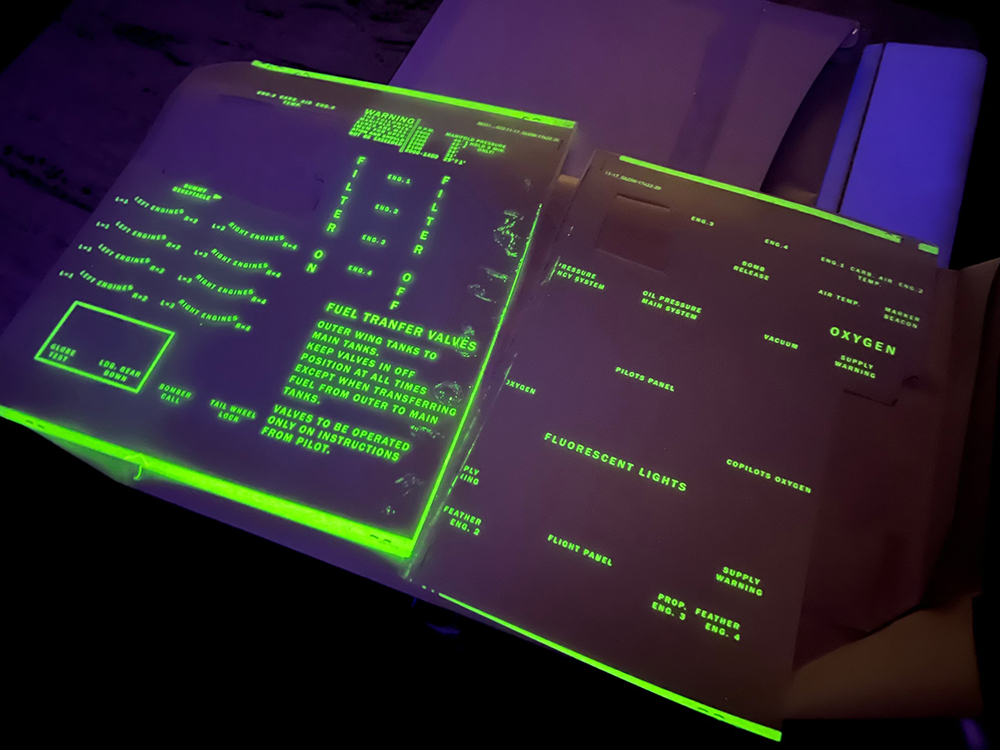
The B-17 panel glow marking test sheet from ReproGraphx, intended for our friend Stijn Claus.
This picture was taken after removing the UV light from the transfers. They stayed glowing for several minutes.
Photo taken 21 November 2022.
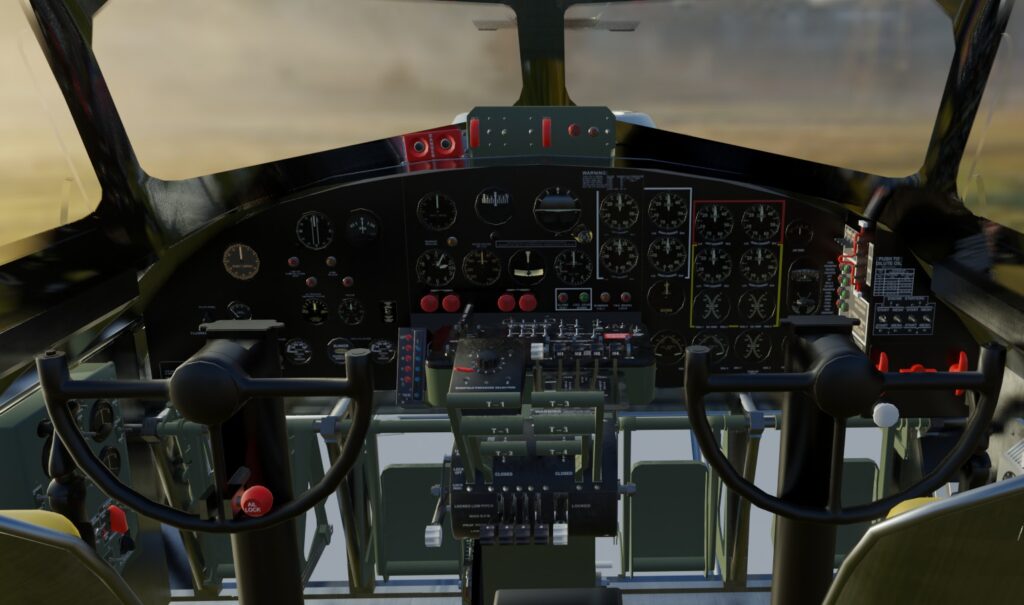
Rendering taken from Howard Lawson’s Virtual WWII B-17G Bomber Project.
This is the aircraft’s cockpit.
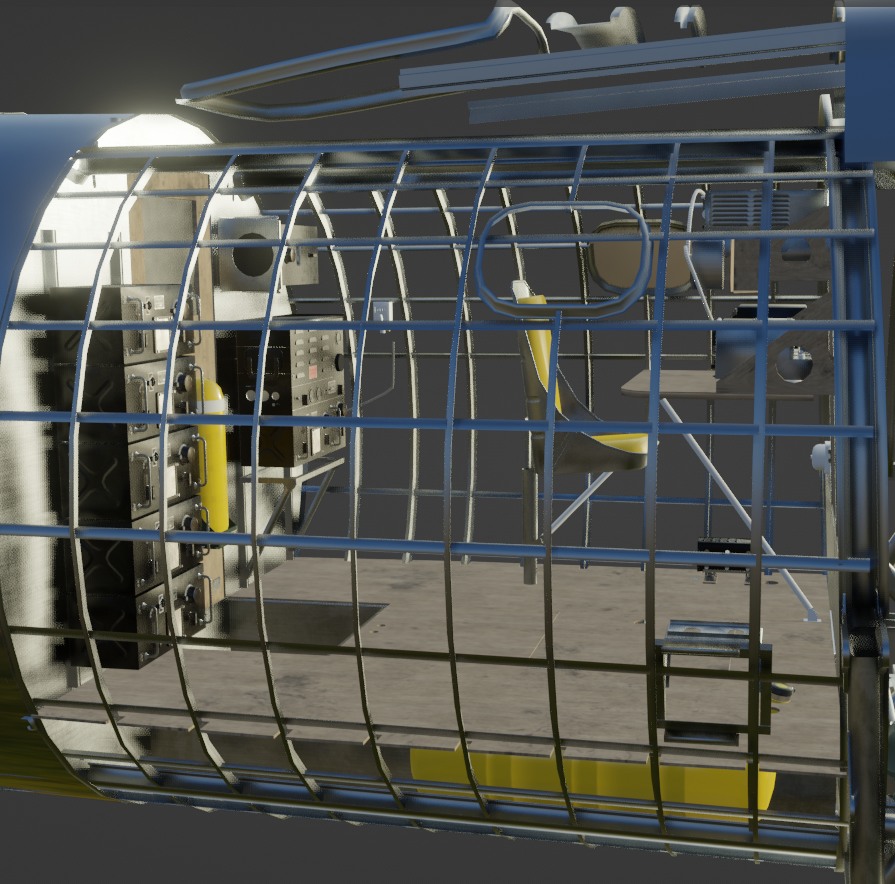
Rendering taken from Howard Lawson’s Virtual WWII B-17G Bomber Project.
This is the aircraft’s radio compartment.
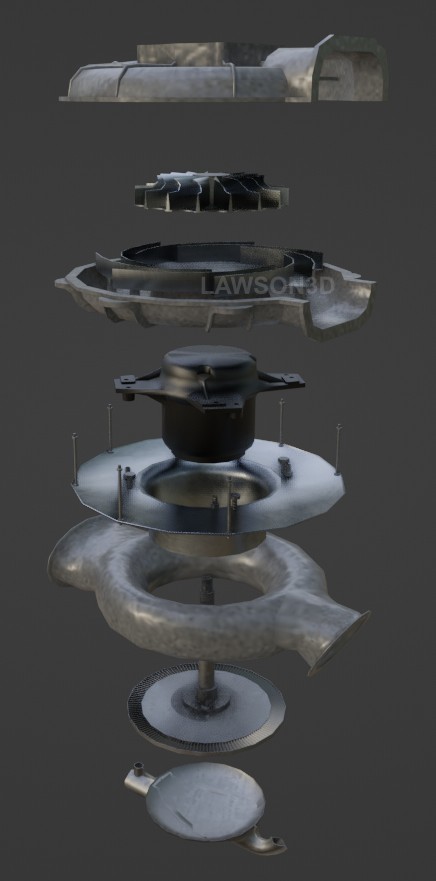
Rendering taken from Howard Lawson’s “Virtual WWII B-17G Bomber Project.”
This is one of the aircraft’s turbochargers, broken down by components by referencing original manuals.

Rendering taken from Howard Lawson’s Virtual WWII B-17G Bomber Project.
This is one of the aircraft’s prop assemblies, broken down by components by referencing original manuals.

SSGT Ray Armstrong of the 305BG poses with his Type A-2 ball turret. Note the side-cap, designed to streamline the ball. These were only found on E and F-model B-17s and early B-24s.
Armstrong survived a bailout on 31 March 1943 when his aircraft, Southern Comfort (41-24617), caught fire over England while returning from a strike.
If you can help with this need, please let us know!
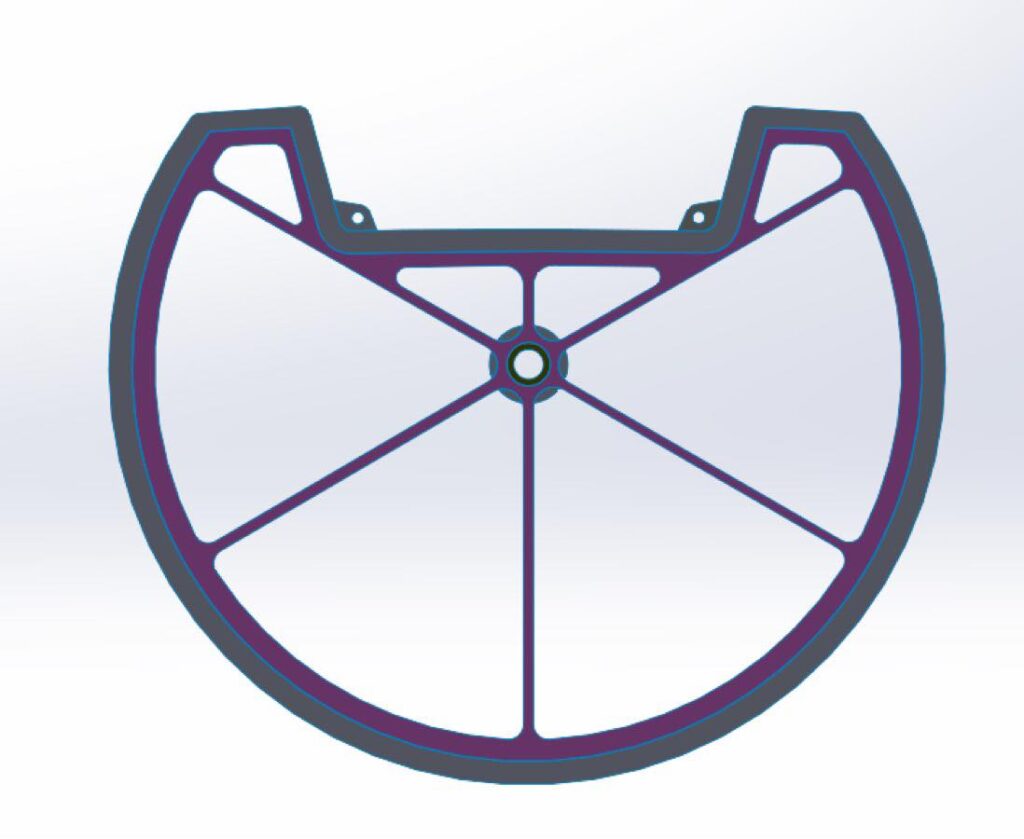
Bob Hachmann’s ball turret side-cap rendering, made using outside measurements taken by Howard Lawson.
We are hoping to acquire an original pair, since we know that there are some still in existence.
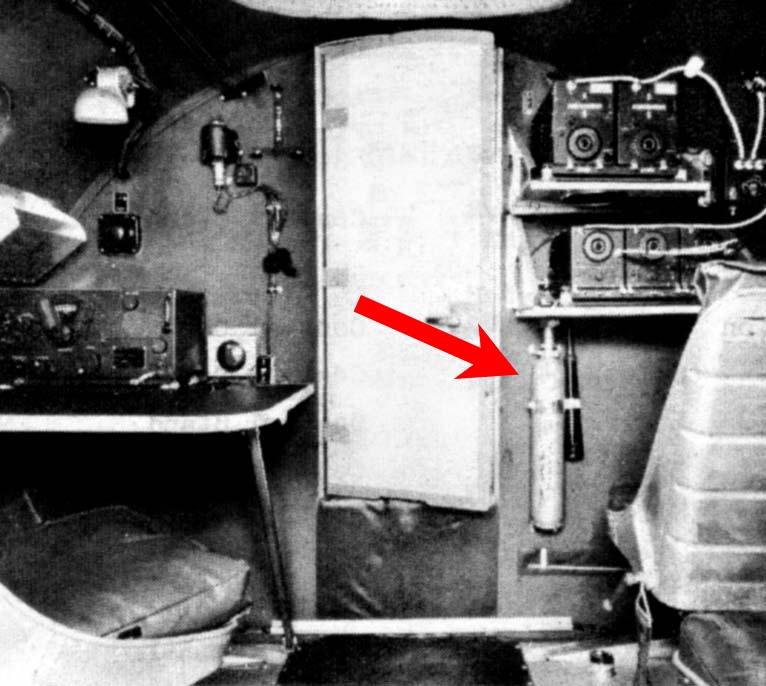
A Type A-17 CO2 fire extinguisher is highlighted in this manual illustration of a B-17F’s Station 5 bulkhead.
The B-17 carried three of these extinguishers as standard.
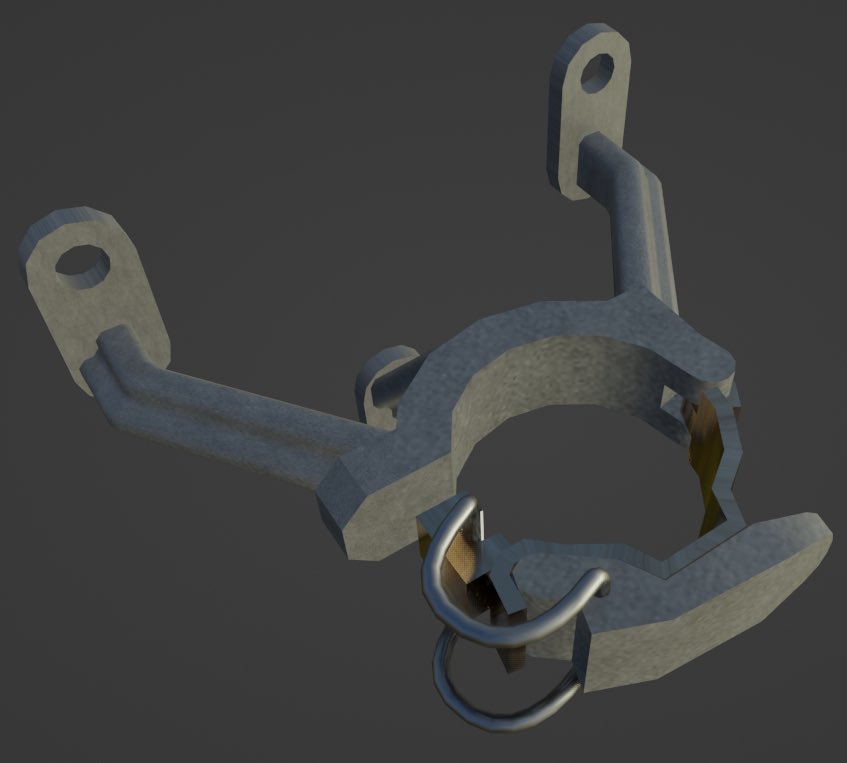
Howard’s rendering of the wartime CO2 extinguisher’s upper bracket.
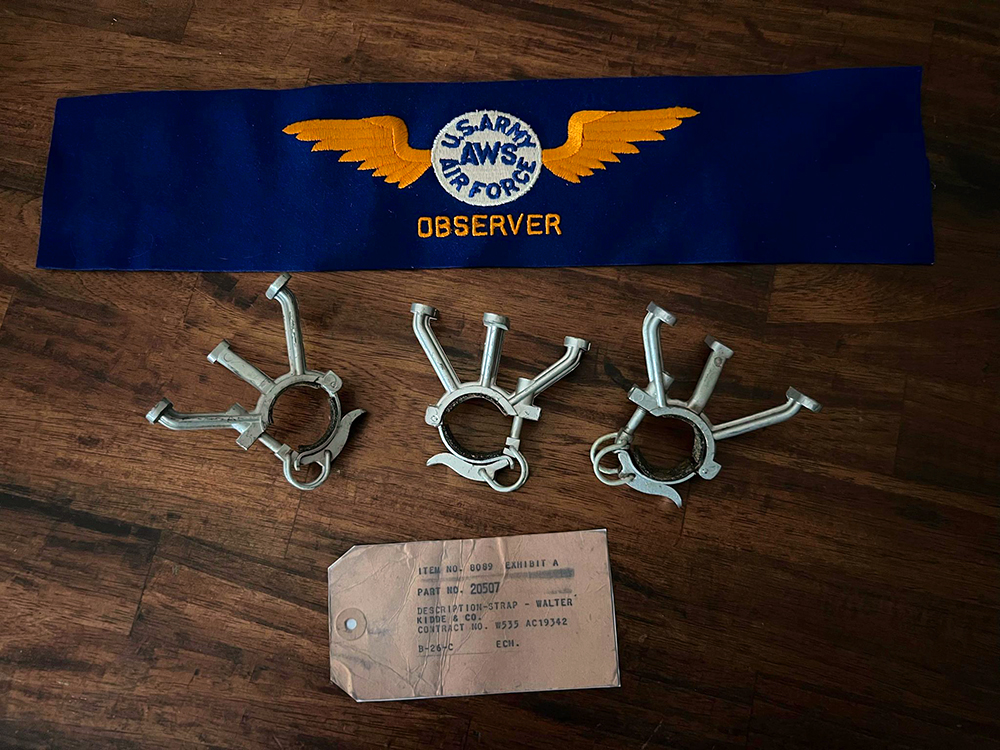
Newly arrived wartime extinguisher brackets, along with the gift of an AAF observer’s armband.
The tag that accompanied them suggests that they were intended for installation aboard a Martin B-26.
Special thanks to Chris Monroe of B-17E Desert Rat Restoration Project for alerting us to these!
Photo taken 3 December 2022.
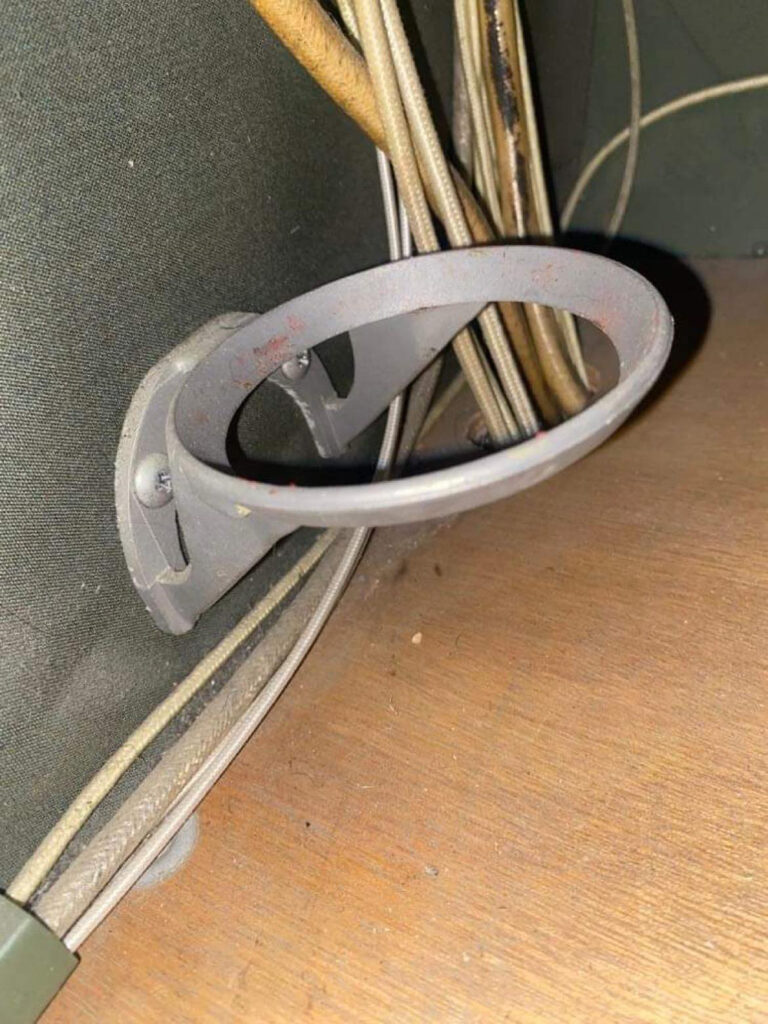
An original lower CO2 extinguisher bracket, installed aboard Dave Littleton’s B-17G Cockpit Project.
Thanks Dave for helping us research these parts!
Photo taken 26 November 2022.

One of our two original Type A-17 Extinguisher clasp bands.
Since we need a third, this part was carefully measured and recreated on the computer, in case it becomes necessary to recreate it.
Photo taken 4 December 2022.
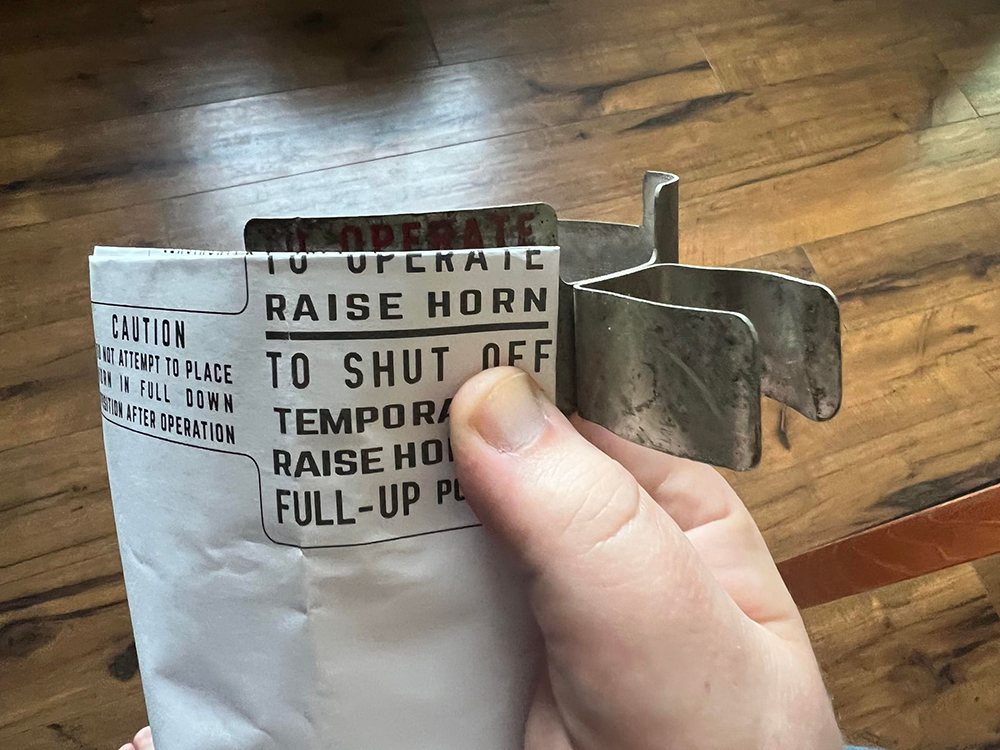
Comparison photo between a print-out of the computer recreation and the original.
We strike to make sure everything aligns perfectly.
Photo taken 4 December 2022.
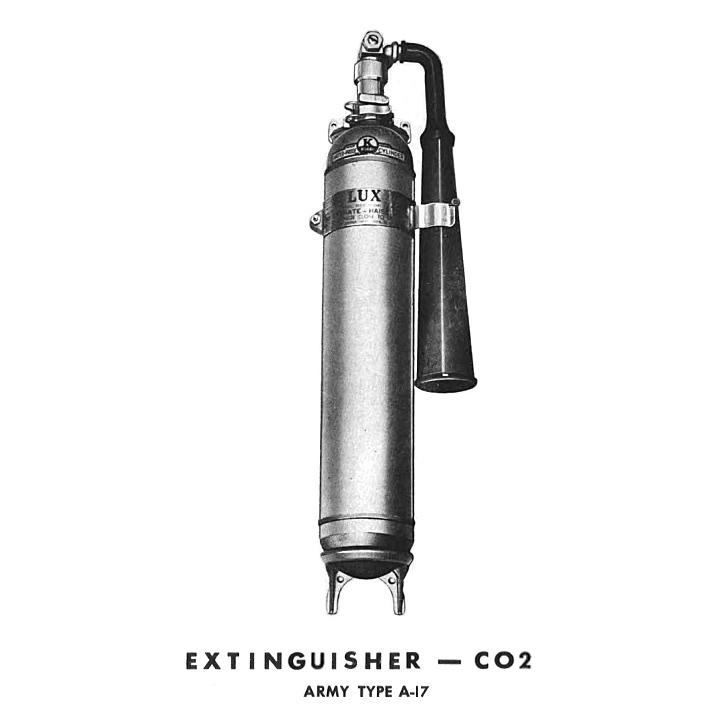
Manual illustration of a Type A-17 Fire Extinguisher, complete with its wall mounts. The Boeing B-17 carried three of these as standard. Later B-17s replaced this model with the 4TB, which was of similar size with a different handle.
If you have one of these and would like to contribute, please let us know!
Friends, November was a rough one. Between sickness and the loss of friends and family, it is taking some effort for me to get back into the swing of making regular updates.
I thought I would start with something special that I took with me to the 8AFHS reunion in Washington, DC. Those who did not come to visit really missed out on something special: Kevin Davenport and his class at Creekside High School 3D printed miniature versions of our recent turret scans!
Now, I must preface that there is a great deal of misunderstanding about how these scans work. Just because we have these parts scanned does not mean that we can immediately go out and recreate them. It is akin to asking an artist to create a sculpture based solely on a photograph – you can get close, but not exact. That is why we are having to reverse engineer the scans, depending heavily on friends like Steve Salinas at Planes of Fame Air Museum to provide measurements of little details that the scans could not pick up (like screw thread sizes, for example).
For the ball turret, only the ball was scanned, as a trunnion assembly has been made available to us once we can afford it. However, the scan was incomplete as there were some components missing. This primarily entails the ammunition hatch. Early ball ammo hatches are rather rare today and we have been unable to find someone who can measure an original early-style ammo magazine hatch cover, much less sell or donate an original. As for another early ball part, the side covers, we are currently working to purchase an original pair.
The top turret will require additional 3D scanning of components once we can raise the funds to do so.
Upon completion of the reverse engineering process, we can then work to have new molds created and the parts cast a new. This will be rather expensive, and we will not be able to accomplish this without everyone’s support. The benefits of recreating these long-lost blueprints however will far outweigh any cost.
Speaking of support, our friend Chris Ely, who is currently helping to restore the aircraft’s extinguisher and ashtray complement, recently donated a Type G-1 Oxygen Tank. Like many surviving G-1 tanks, Chris’s tank had been converted into a portable air bubble after the war. No alterations were made to the tank itself, meaning all that is needed to return it to wartime spec is to unscrew the fittings. The Boeing B-17 carried a total of 18 of these tanks, and Chris’s donation means that we are only 3 tanks from a full complement!
Once we have a full complement of oxygen tanks, we can begin the process of restoring them for Lucky Thirteen. So, if any of you have an oxygen tank or two to spare…
Volunteer Bob Hachmann has also been hard at work, fabricating the housing for the bomber’s instrument panel.
For those who do not recall: We have avoided cutting the finished faceplates for the instrument panel until the housing is completed. Instead, we have used a wooden mockup as a placeholder for the gauges and switches, allowing us to proof our work before the final product. While G-model B-17s used a wooden instrument panel housing, B-17Fs used aluminum housings.
This sort of housing is rather uncommon today and Bob has had to create special jigs to recreate various extrusions that are no longer commercially available. It is exciting for us to see the housing beginning to take shape!
Because Megan and I have been down with the flu for so long, I have not accomplished much on my end lately. However, I have been able to cut some phenolic spacers for Ray to install on Sta. 5. These are for the Command Radio shelves.
Because Lucky Thirteen was upholstered in her radio compartment, all of the equipment mounted therein requires spacers to account for the insulation. While most of these take the form of aluminum tubes, the spacers for the SCR-274 shelves were made of laminated phenolic. Now that these are cut, Ray can begin fabricating the shelves.
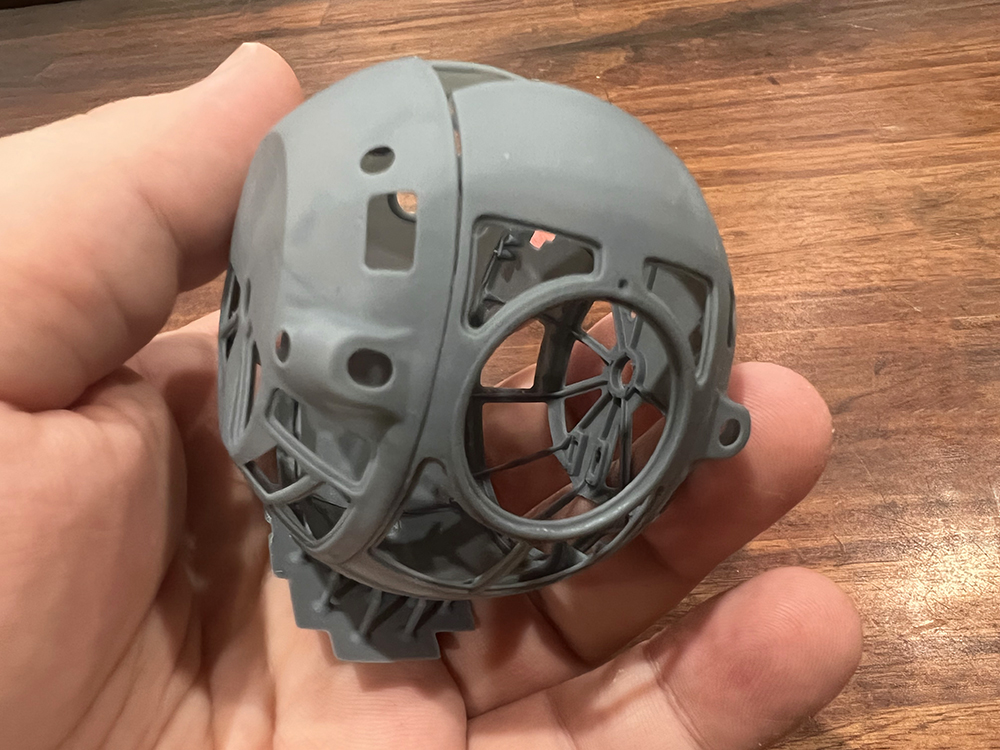
The 3D printed ball turret, made by Kevin Davenport using scans of the original at Planes of Fame Air Museum in Chino, California.
There was some trouble printing the ball as shrinking the design also decreases the thickness of the walls.
Photo taken 20 November 2022.
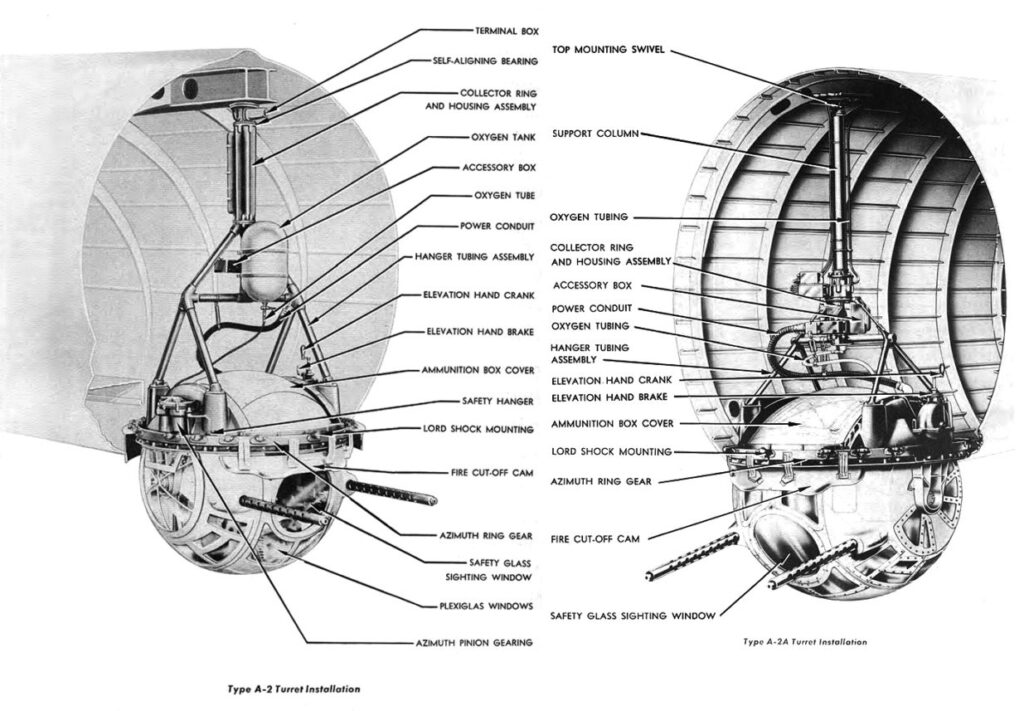
Manual illustrations covering the Type A-2 (left) and Type A-2A (right) Ball Turrets. The Type A-2 was typically installed on E and F model B-17s, and the A-2A on G models.
No B-17 ever carried a ball turret with external ammunition cans.
Note the ammo magazine hatches. The A-2 had a cast aluminum hatch and while the A-2A used one made of stamped sheet metal.
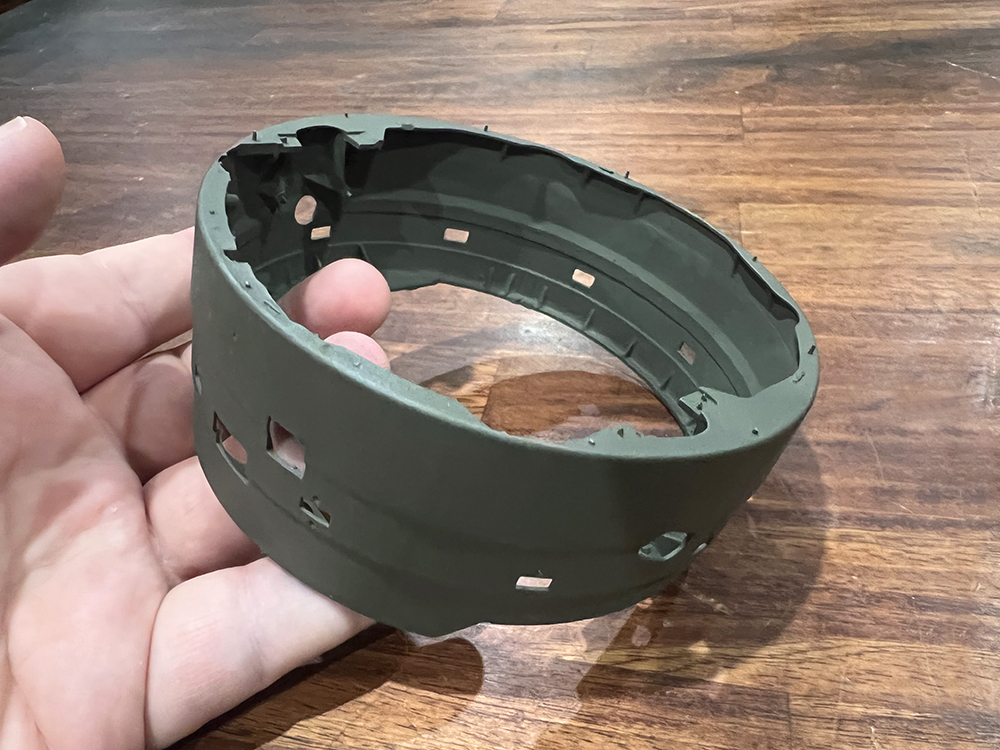
The 3D printed top turret tub, made by Kevin Davenport using scans of an original.
The area facing the camera is the forward section of the top side. The locating pins for the dome can be seen here.
Photo taken 20 November 2022.
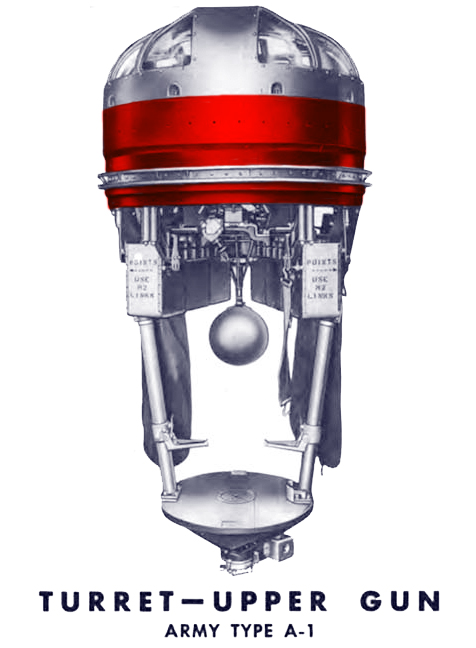
A manual drawing of a Type A-1 Upper Turret is highlighted to show the tub assembly.
Because of their rarity, it is unlikely that an original will ever become available.
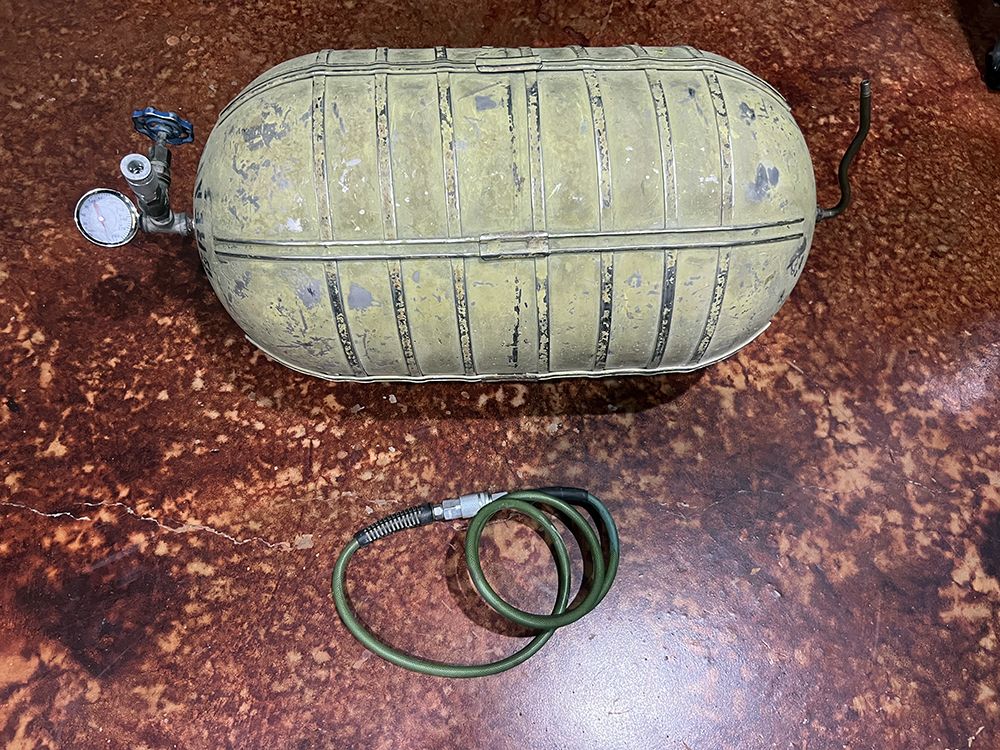
The Type G-1 Oxygen Tank donated by our friend Chris Ely.
Only three more to go to have a full set of 18 for Lucky Thirteen!!!
Photo taken 8 November 2022.
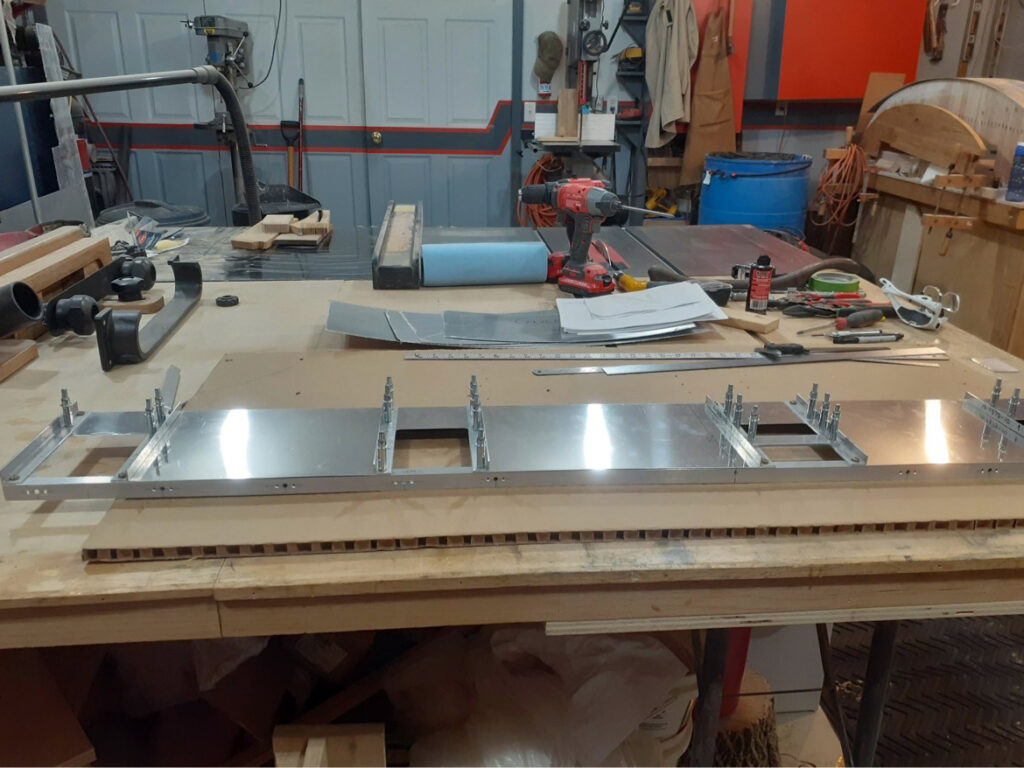
The instrument panel housing begins to taken shape.
Note the form for the unique arch which forms the upper part of Sta. 3.
Photo taken 18 November 2022
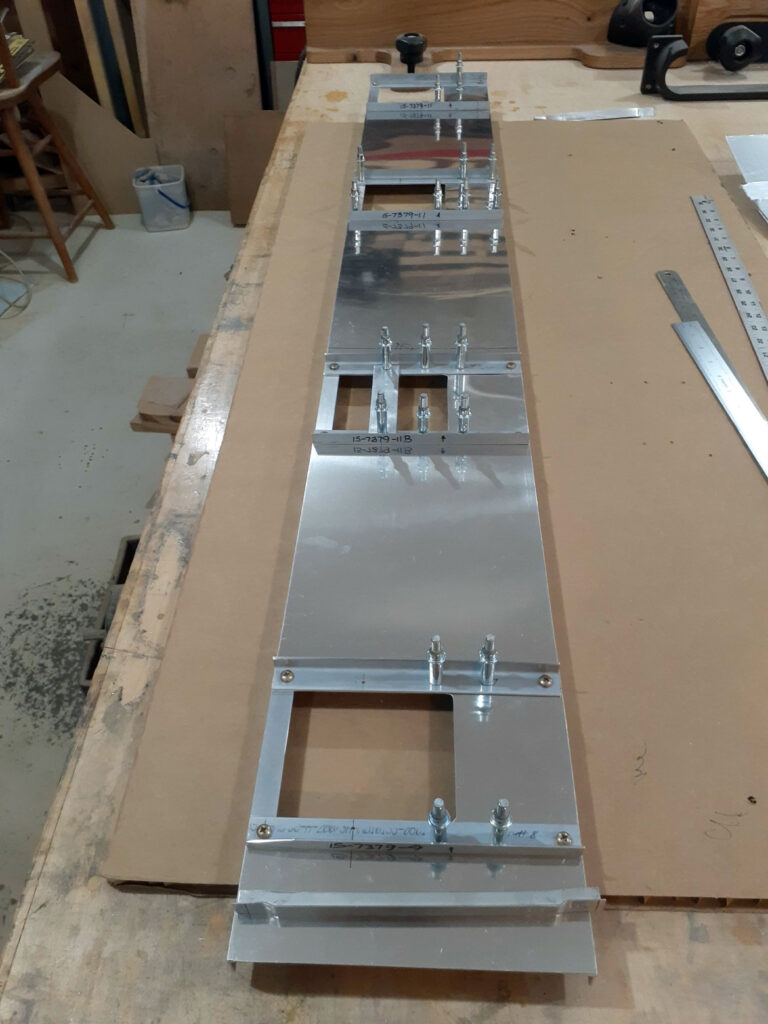
The instrument panel housing begins to taken shape.
Photo taken 18 November 2022.
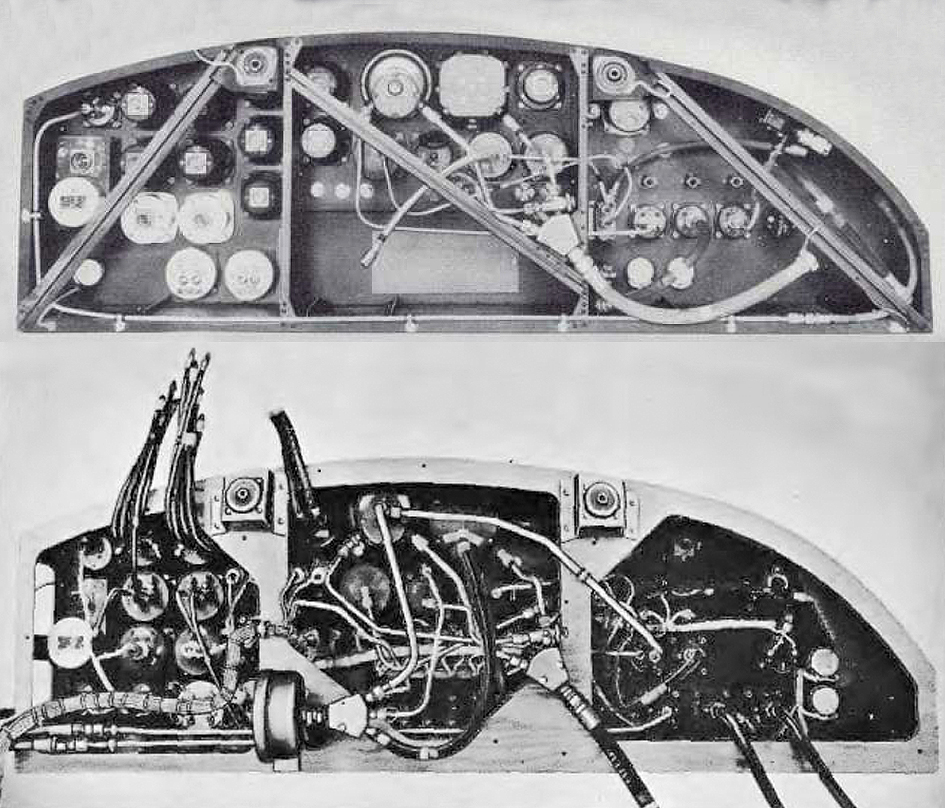
Manual illustrations comparing the instrument panel housings for an F model (top) and G model (bottom) B-17.

The phenolic spacers cut for the SCR-274 shelves on Sta. 5.
Photo taken 17 November 2022.
Got some pics today showing our work on the aft fuselage of Liberty Belle.
After a great deal of careful work to ensure the proper fit, the main entrance door is now installed. Those of you with experience in metal fabrication will likely appreciate the work that went into this.
It will not be long before she is ready to go down to Georgia and join the rest of the old bird.
For first-time visitors, please remember that the Hangar Thirteen Foundation and the Liberty Foundation are two different organizations. We have been working with the Liberty Foundation to help rebuild the B-17G Liberty Belle, but the B-17F Lucky Thirteen is our own project.
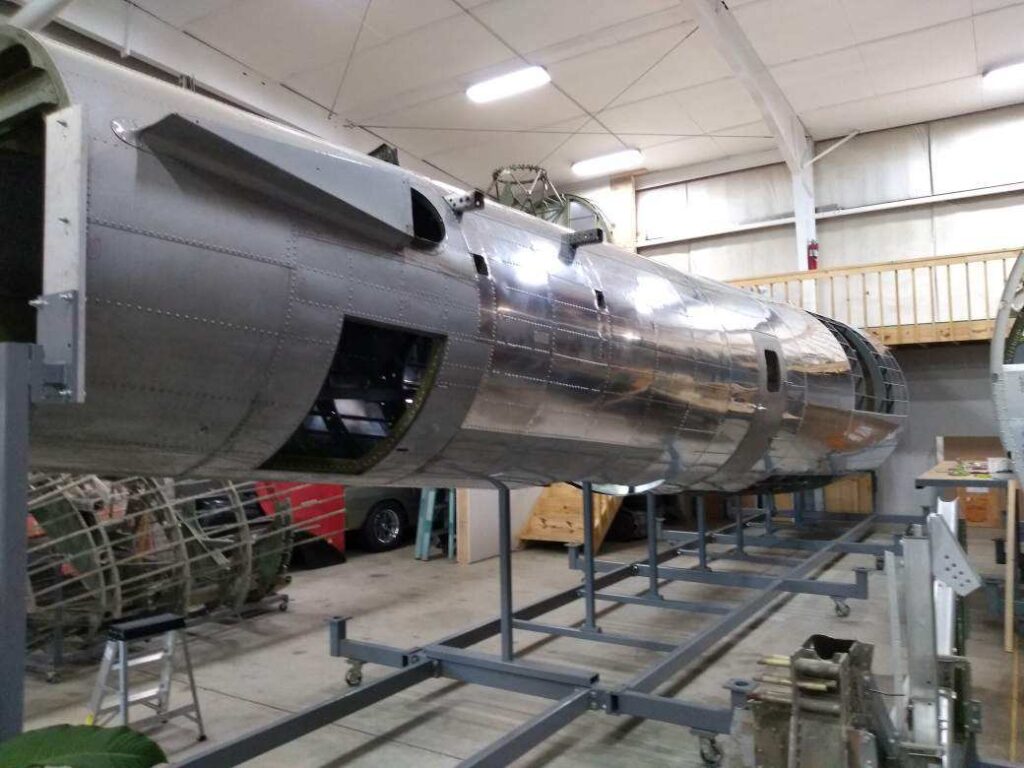
The aft fuselage of Liberty Belle.
Hangar Thirteen has two fuselage jigs – a fore jig and an aft jig. The aft jig is holding the aft fuselage of Liberty Belle. The fore jig (right) is holding the forward fuselage of Lucky Thirteen.
Photo taken 8 November 2022.
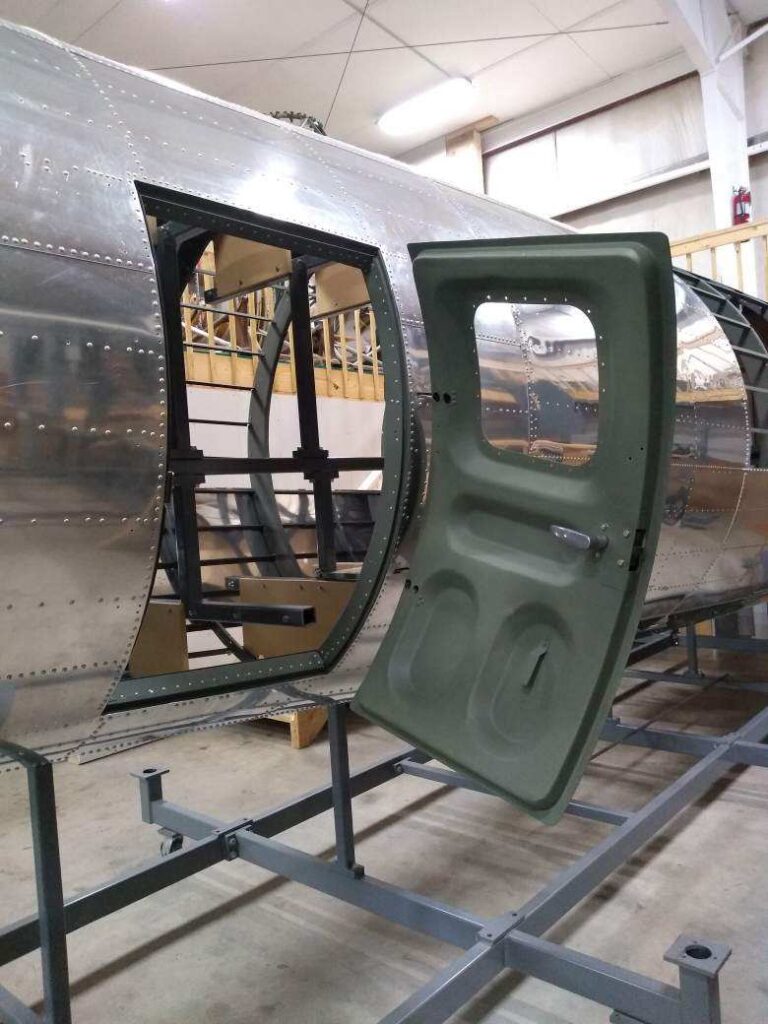
The main entrance door to Liberty Belle, now installed.
Photo taken 8 November 2022.
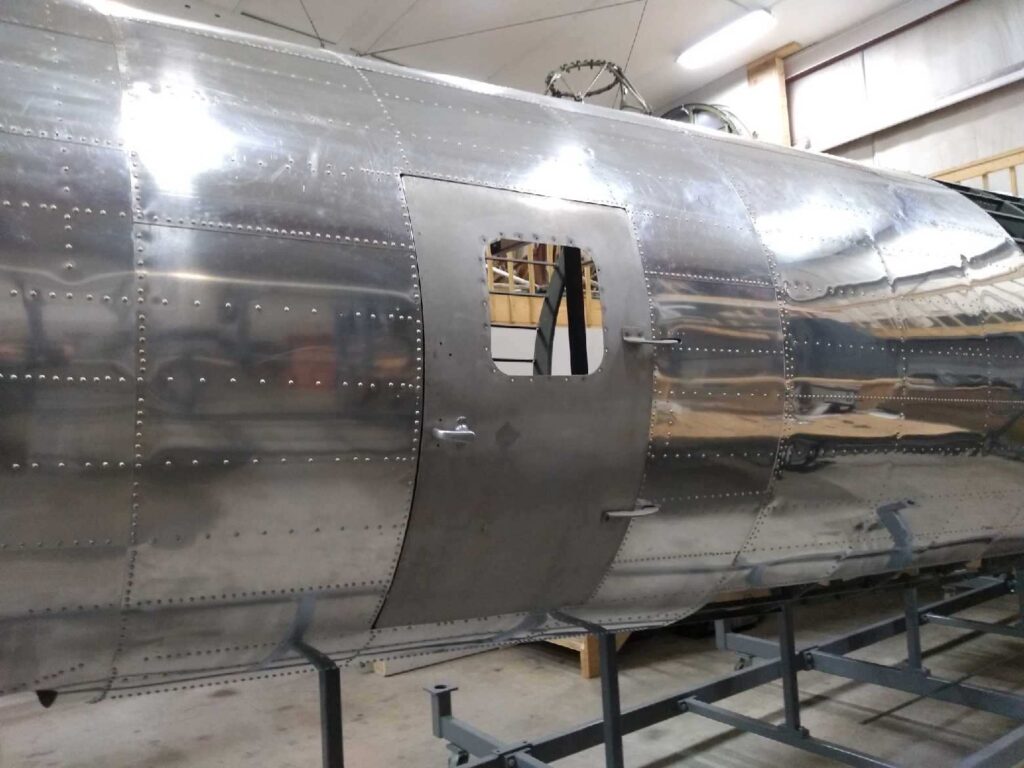
The main entrance door to Liberty Belle, now installed.
Photo taken 8 November 2022.
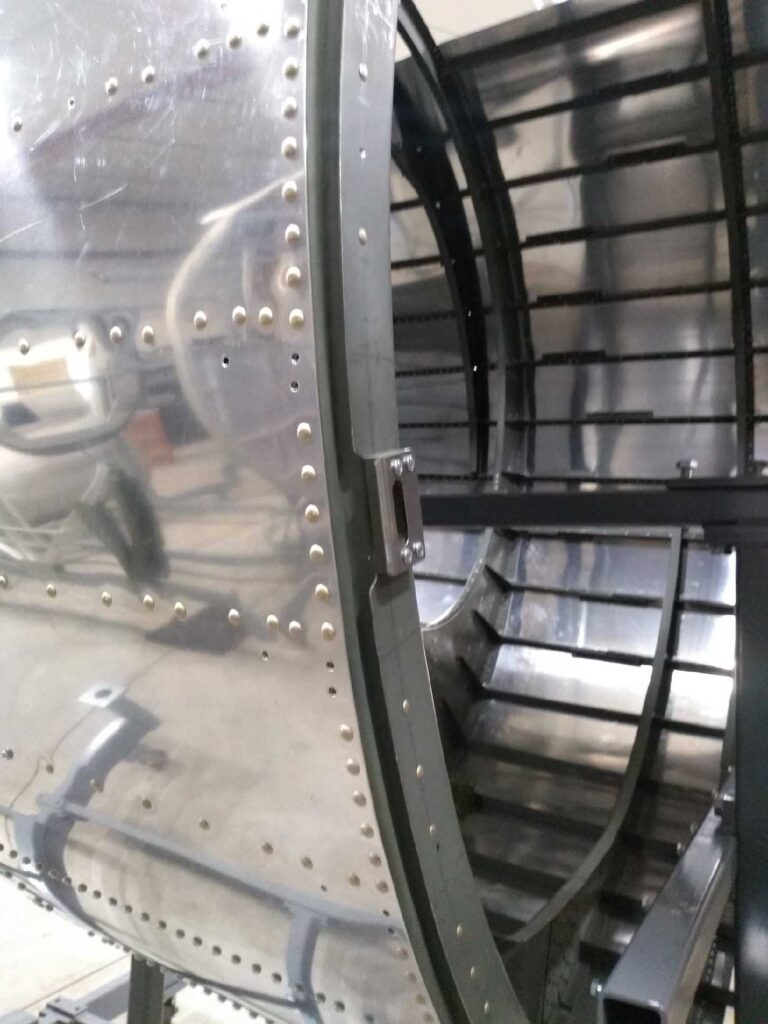
The latch catch, fully formed and installed into Liberty Belle.
Photo taken 8 November 2022.
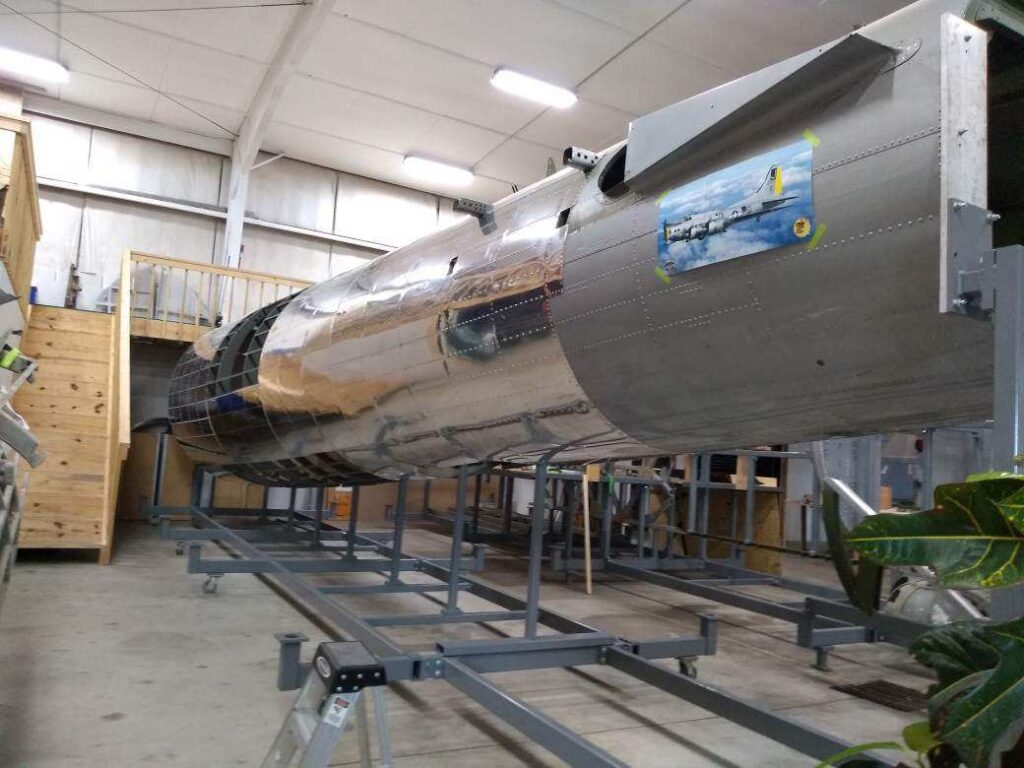
The aft fuselage of Liberty Belle in Hangar Thirteen’s aft fuselage jig.
The stairs in the back lead to an overhang which we plan to eventually expand, so as to circle the entire hangar.
Photo taken 8 November 2022.
I am sorry to say that our attendance at the 2022 Eighth Air Force Historical Society reunion was not the success that we hoped that it would be. The 384th Bomb Group graciously allowed us to set up our display in their meeting room and we had to try and get visitors to come by in their spare-time via word-of-mouth. However, because of the hotel’s design and schedule of events, getting people to our display proved difficult.
Still, we met some fascinating people, made some new friends, and got to see some amazing sights.
Amongst the friends we made was Shannon Muchow, who was attending with the 385th Bomb Group. On ‘Rendezvous Night’ the 384BG and 385BG shared the same dining room, and during conversations it came out that she works with Greg Stathatos at B-17 Archaeology – a mutual friend! Shannon is just as friendly and passionate about history as Greg, and we had a great time chatting about the ups and downs of our unique field.
Similarly, I got a message from the great Stijn Claus of the B-17 Flying Fortress Parts Project saying that he had a friend attending that he would like us to meet: Kristof De Geyter. Like Stijn, Kristof is from Belgium, and came in honor of a memorial he is working on. Kristof volunteers as a local historian and had some incredible stories to tell about the veterans and veteran families he has interacted with. If you don’t already know of Kristof and his work, he is definitely worth following on Facebook. Because of the cursory nature of the previous day’s Arlington Cemetery tour, Kristof and I decided to explore the Washington Mall on our own the following day. I hope he had as much fun as I did!
Speaking of breaking away, Hangar Thirteen volunteer and 384BG member Christopher Wilkinson missed out on visiting the National Air and Space Museum, Smithsonian Institution Udvar-Hazy Center on Thursday, so we made a point of taking him there on Saturday afternoon. That was an absolute blast. Because the National Air & Space Museum downtown was under renovation, much of its collection had been temporarily moved to the Udvar-Hazy Center – a location far more appropriate, in my humble opinion. The NASM has already begun the process of moving the B-17G Shoo Shoo Baby from the NMUSAF in Dayton to Washington, bringing over various small components. And they were out there, if you knew where to look…

The Hangar Thirteen display inside the 384BG’s room. The 384BG’s conference room was called the “Manassas Suite,” after a nearby rail hub that was the site of two major battles during the American Civil War/War of Secession.
One my first major research projects in grad school was on LTG James Longstreet, who achieved a major victory as commander of Confederate I Corps at the Battle of Second Manassas.
Not visible here is a television playing a looped slideshow of our B-17 work.
Photo taken 19 October 2022.

Shannon Muchow and I sent this picture to Greg Stathatos after we met at the ‘Rendezvous Night’ dinner.
Photo taken 21 October 2022.
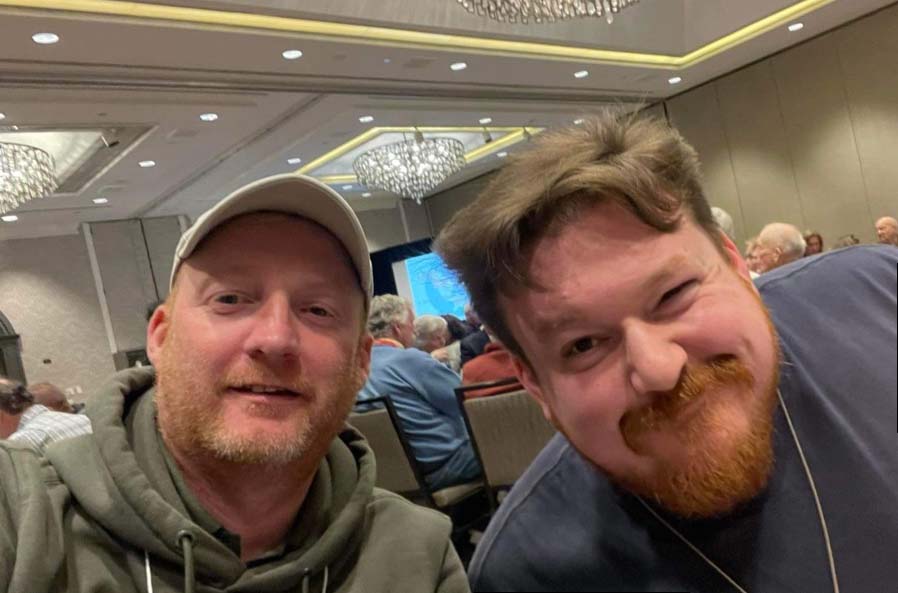
Kristof De Geyter and I at the opening banquet dinner. We sent this picture to Stijn Claus so he knew that we had found one another.
My apologies for the messy hair!
Photo taken 20 October 2022.
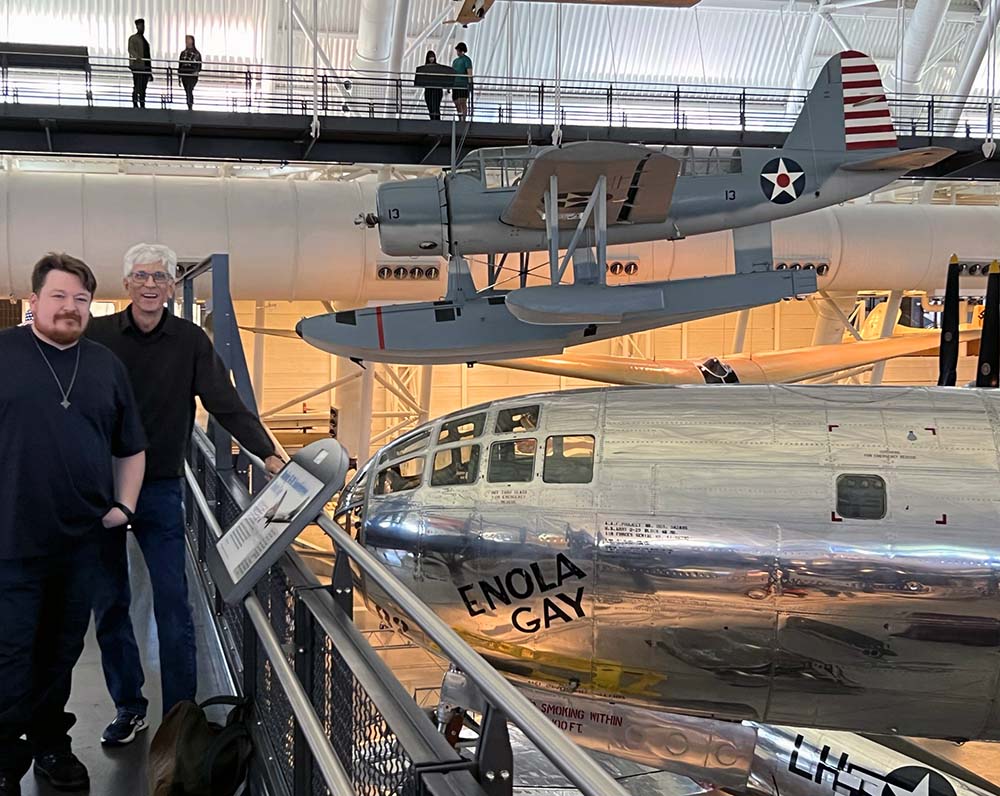
Chris Wilkinson and I in front of the Boeing B-29 Enola Gay at the Udvar-Hazy Center.
Photo taken 22 October 2022.
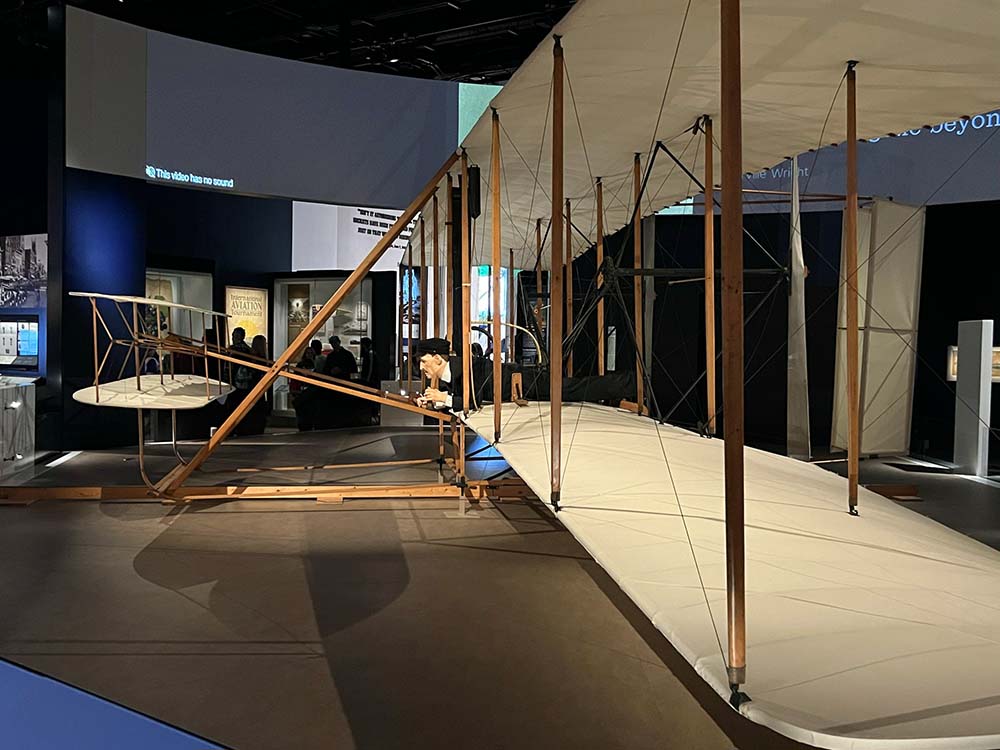
Where it all began – the Wright Flyer.
The National Air and Space Museum, Smithsonian Institution’s downtown facility is currently undergoing extensive renovation. I will admit to not being a fan of many modern museum trends, but it was nice to see the Flyer moved to a location where it could be easily seen.
Photo taken 21 October 2022.
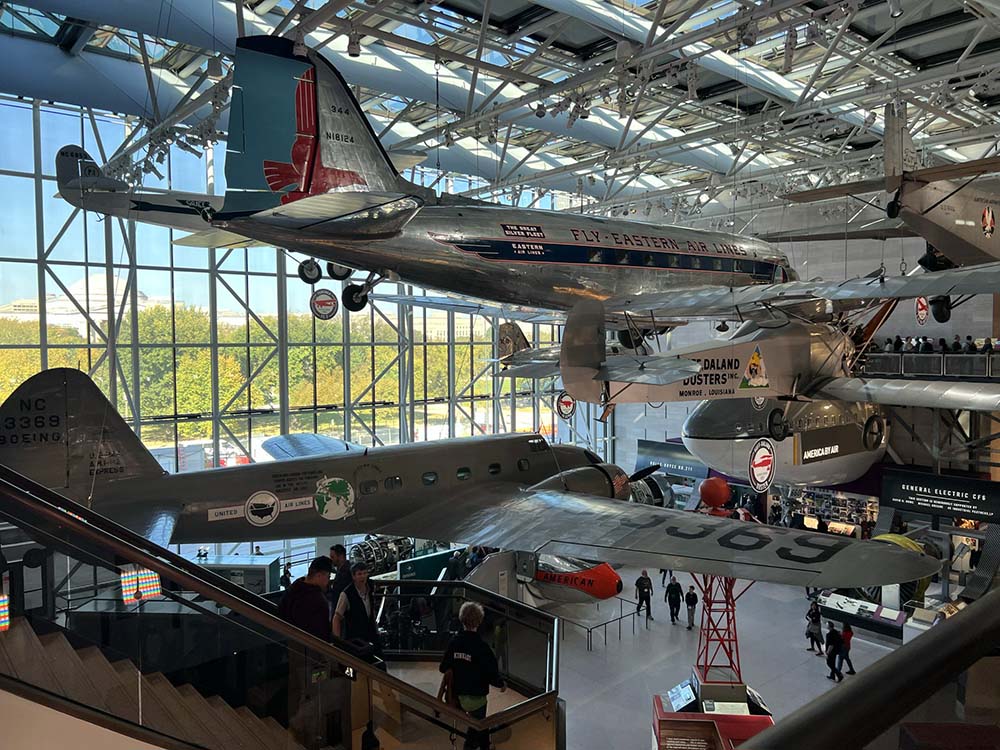
One wing of the National Air and Space Museum, Smithsonian Institution’s downtown facility was opened to the public on a preview basis. A family from New Jersey was gracious enough to give Kristof and I a pair of extra tickets for afternoon entry.
This gallery remains largely unchanged from its original design, displaying major aircraft throughout the history of US airliners.
These aircraft are, in chronological order: a Huff-Daland Duster, Curtiss Robin, Fairchild FC-2, Ford Trimotor, Northrop Alpha, Boeing 247, Douglas DC-3, Douglas DC-7 (Nose), and Boeing 747 (Nose).
Photo taken 21 October 2022.
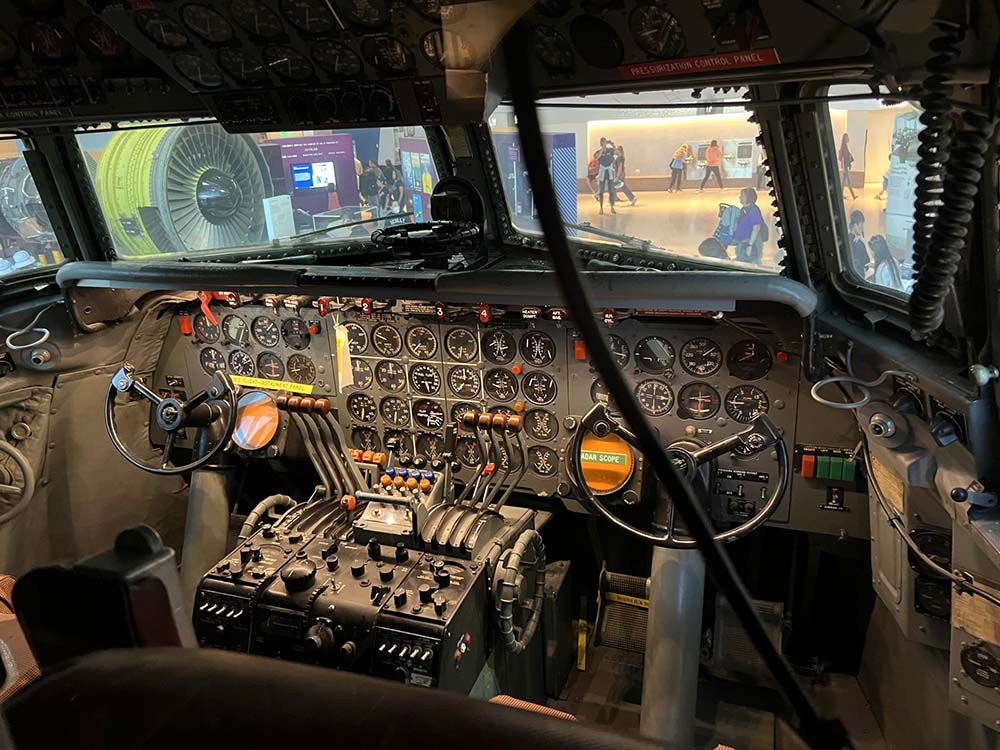
The cockpit of the Douglas DC-7 nose on display at the National Air and Space Museum, Smithsonian Institution in downtown Washington, DC.
Photo taken 21 October 2022.
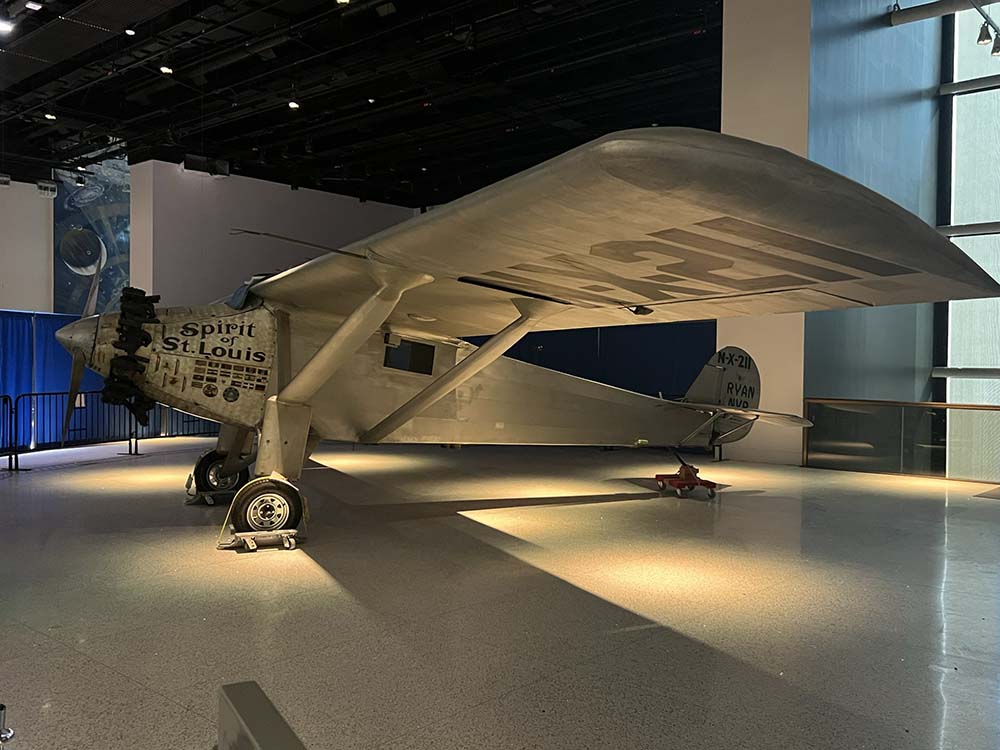
Tucked away in a shadowy corner behind a security line, Kristof and I found the Spirit of St. Louis – the first aircraft to solo across the Atlantic Ocean nonstop – awaiting its return to display.
Extensive work was required on her upper wing from years of hanging under sunlight. It is wonderful to have her on the floor again, even if it is only for a short while.
Photo taken 21 October 2022.
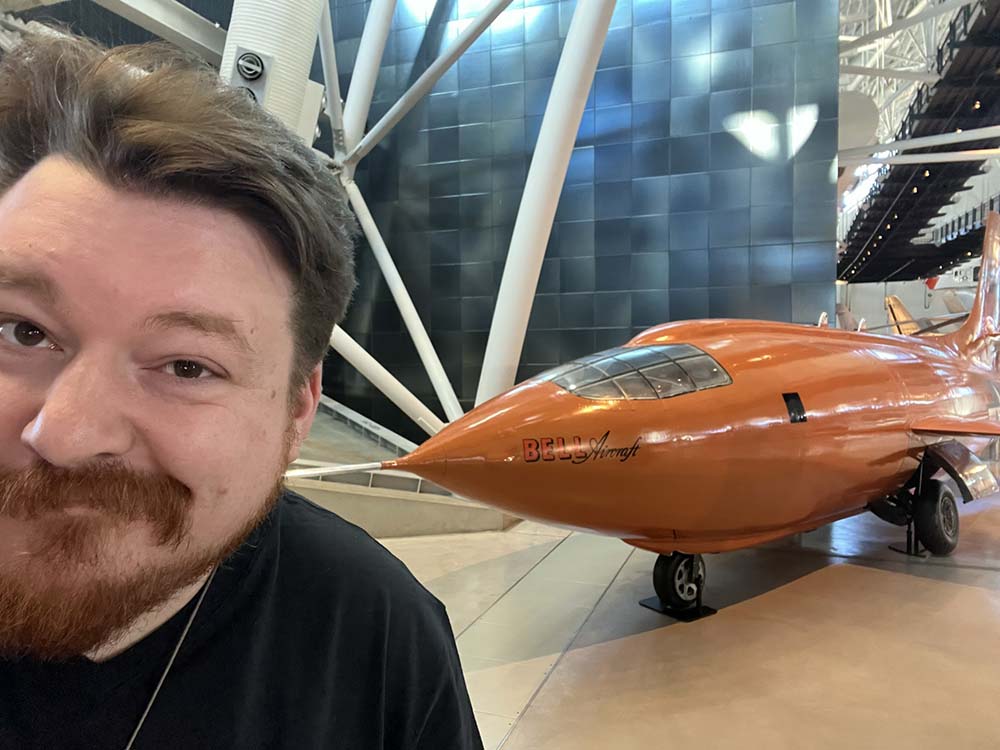
The National Air and Space Museum, Smithsonian Institution’s downtown facility is generally too crowded to get a good view of the artifacts on display. This is why I have always felt that truly important pieces should be displayed at the Udvar-Hazy Center.
The Bell X-1, shown here, has been moved to the Udvar Hazy Center, where it sits at the entrance to the space exploration gallery.
Hopefully, she can stay there.
Photo taken 22 October 2022.
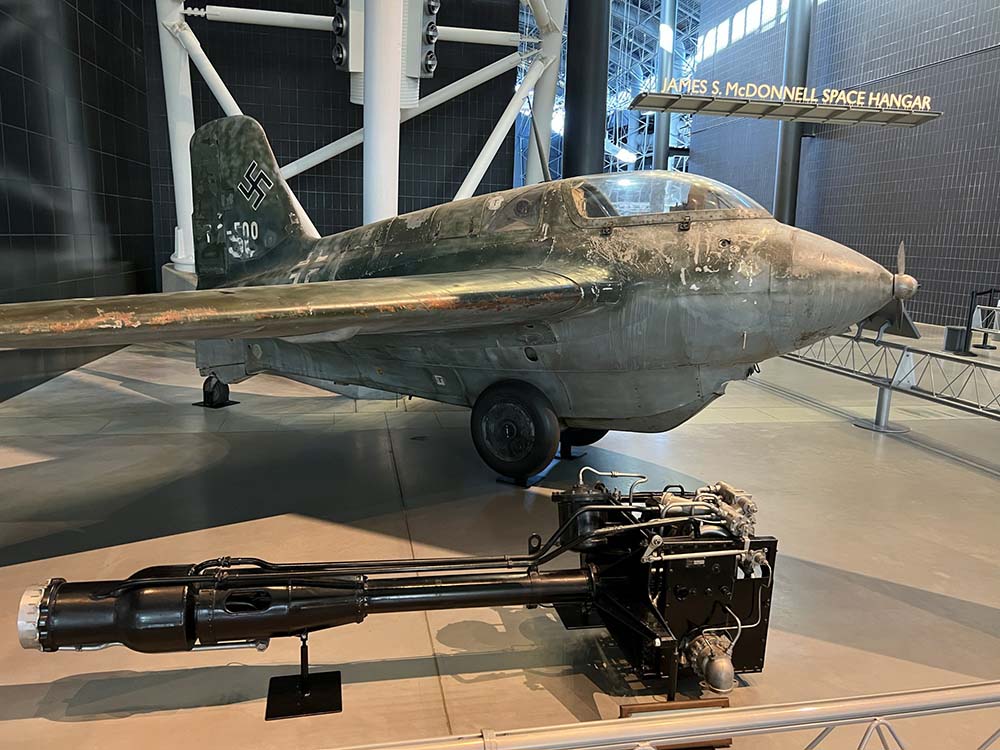
This Me-163 was originally loaned to the Mighty Eighth Air Force Museum in Savannah, Georgia. As you can see, she has never been refinished.
While shockingly lethal in combat, the aircraft was as dangerous for its operators as it was for its enemies. Allied fighter pilots learned to simply wait for the Komet to expend its fuel (which it did rapidly) and shoot them down as they glided back to Earth. An estimated 91 were built before the war’s end, scoring 16 aerial victories for a loss of six to enemy action and nine to the dangers inherent in the aircraft’s design.
Entering service on 28 July 1944, their first operational losses occurred on 16 August when a Me-163 piloted by Fwl Herbert Straznicky (JG400) was shot down by SSGT Howard J. Kaysen, tail gunner on Boeing B-17G Towering Titan (44-38085, 305BG). Shortly afterward, Lt Hartmut Ryll (JG400) was shot down by North American P-51s of the 359FG (LTC John B. Murphy and LT Cyril Jones, Jr.) while attempting to intercept B-17G Betty Lou’s Buggy (42-31579, 91BG).
Photo taken 20 October 2022.
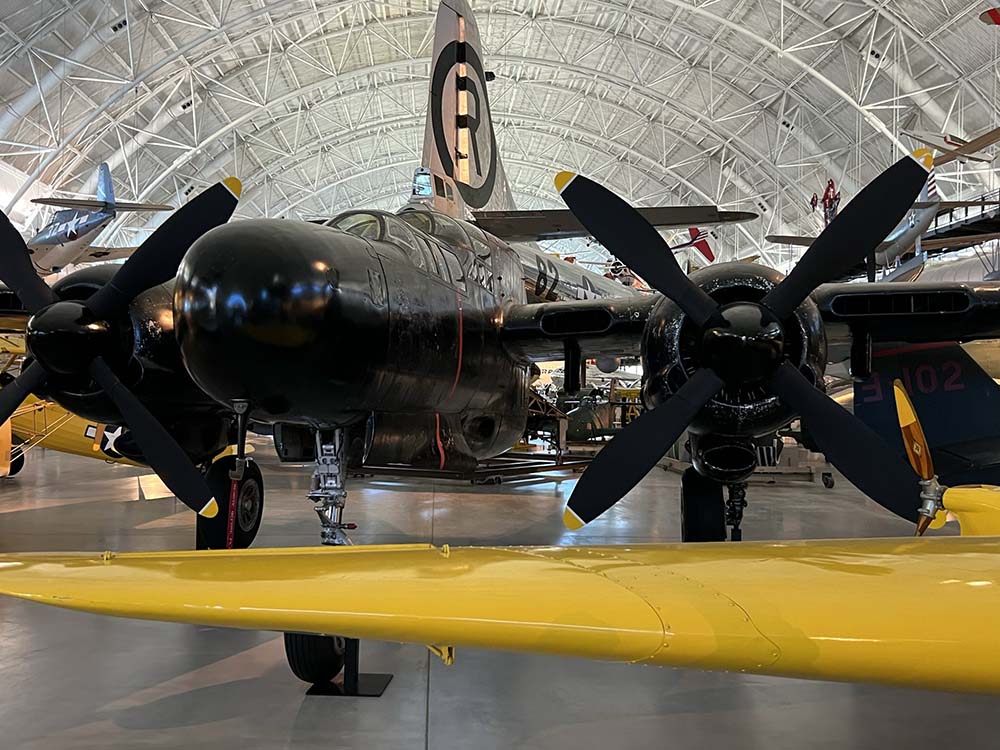
One of only four Northrop P-61 Black Widows in existence. Once again, her markings remain completely untouched.
The P-61 was developed to replace the DeHavilland Mosquito in US service, as there were simply not enough to meet demand. While the P-61 did not live up to the Mosquito’s performance, it was nevertheless a remarkably advanced design. The nose assembly held the aircraft’s radar.
Photo taken 20 October 2022.

A Republic P-47D, formerly on loan to the Museum of Aviation in Warner-Robins, Georgia.
This P-47’s interior has never been refinished. Like the Boeing B-17, the P-47 did not have a zinc chromate interior – rather, her cockpit was Dark Dull Green.
Photo taken 20 October 2022.

Because of vandals, the Boeing B-29 Enola Gay is displayed elevated from the floor.
An interesting reflection of modern education, Bock’s Car at the National Museum of the US Air Force does not suffer from this issue, simply because most people have no idea that there was a second nuclear strike aircraft.
Photo taken 20 October 2022.

An overhanging walkway allows visitors to look down on Enola Gay, but only by looking through a protective plexiglass wall.
That portable oxygen bracket by the bombardier’s position should look familiar to regular Hangar Thirteen followers!
Photo taken 22 October 2022.
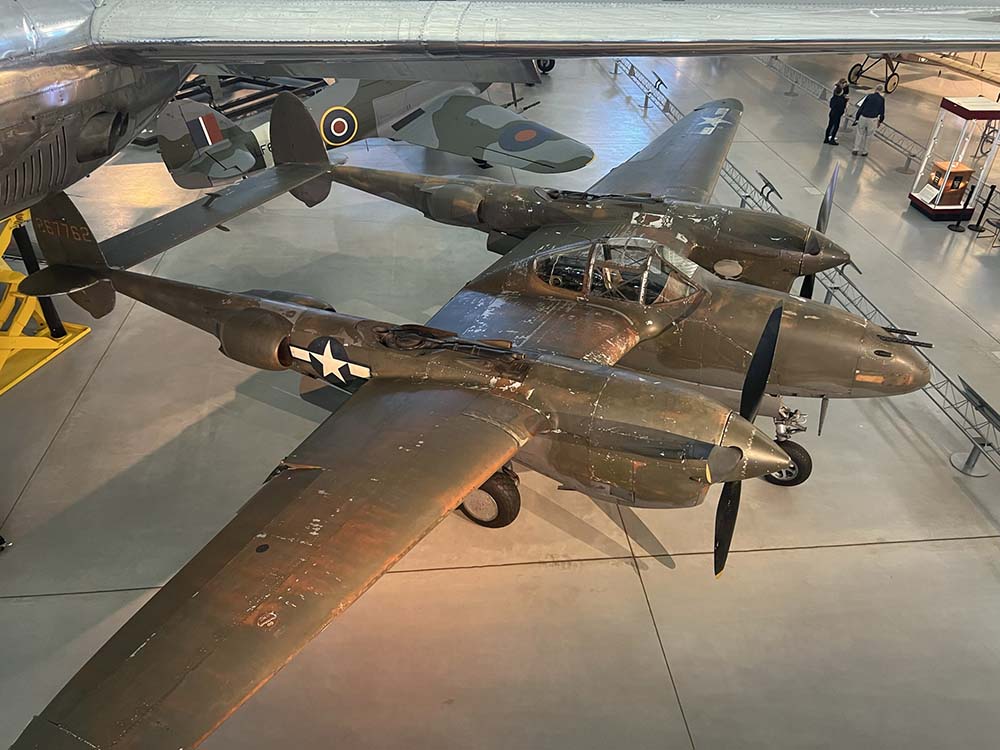
The National Air and Space Museum, Smithsonian Institution has long practiced a policy of preservation rather than restoration. For aircraft like this Lockheed P-38, which spent most of its life in storage, the result is breathtaking.
Photo taken 22 October 2022.

A wartime training display on the Lockheed P-38’s hydraulic system.
Photo taken 20 October 2022.

A great many of the aircraft on display at the National Air and Space Museum, Smithsonian Institution are one-of-a-kinds. This Nakajima J1N1 is the sole-surviving example of its type. The Gekkō was one of only three production Japanese fighters to prove effective against the Boeing B-29.
Note the upward firing armament behind the cockpit. This is a Japanese variant of Schräge Musik – fighters designed to intercept heavy bombers from underneath, where they were least likely to be seen.
Photo taken 22 October 2022.

The sole surviving Boeing 307 Stratoliner (excluding the one that was mangled into a boat).
The airliner variant of the Boeing B-17, the Stratoliner was history’s first pressurized airliner.
Photo taken 20 October 2022.
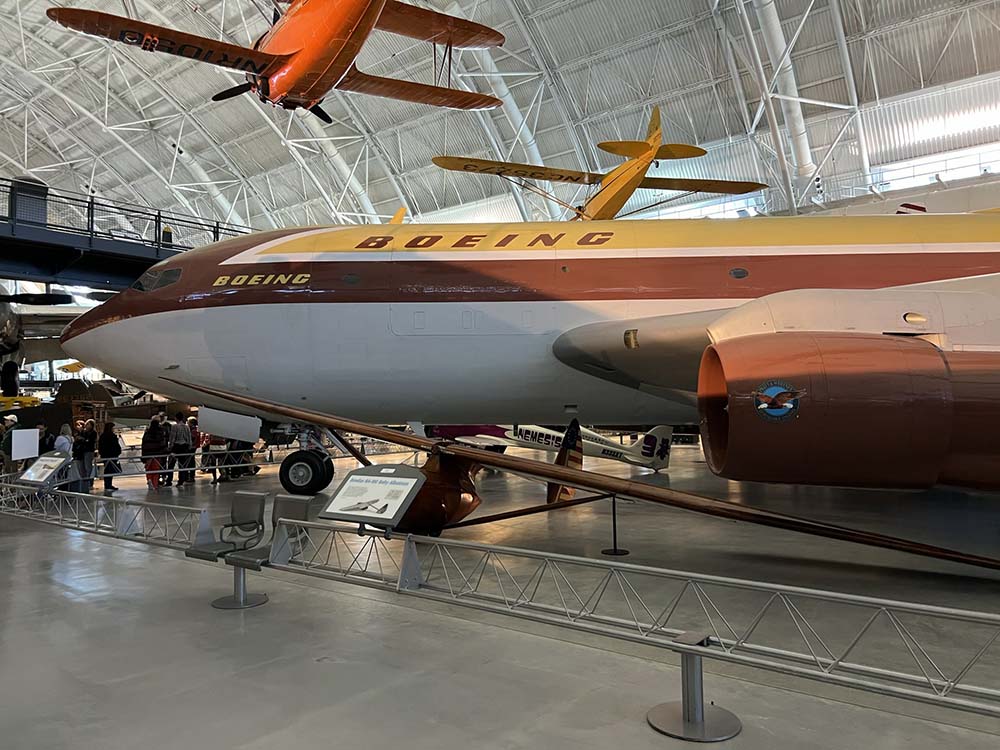
The prototype Boeing 707.
When Boeing hosted a test flight in 1955 to show airline executives that jet airliners were indeed safe, test pilot Tex Johnston stunned the world by performing a barrel roll in this aircraft.
When Boeing CEO Bill Allen demanded to know what Johnston was doing, Johnston replied “selling airplanes.”
Photo taken 20 October 2022.

Tucked behind the Boeing 707 is Howard Hughes’s H-1 Racer, awaiting the renovations to the National Air and Space Museum, Smithsonian Institution’s downtown facility.
This aircraft was one of the first to explore the performance advantages of flush riveting.
Photo taken 20 October 2022.
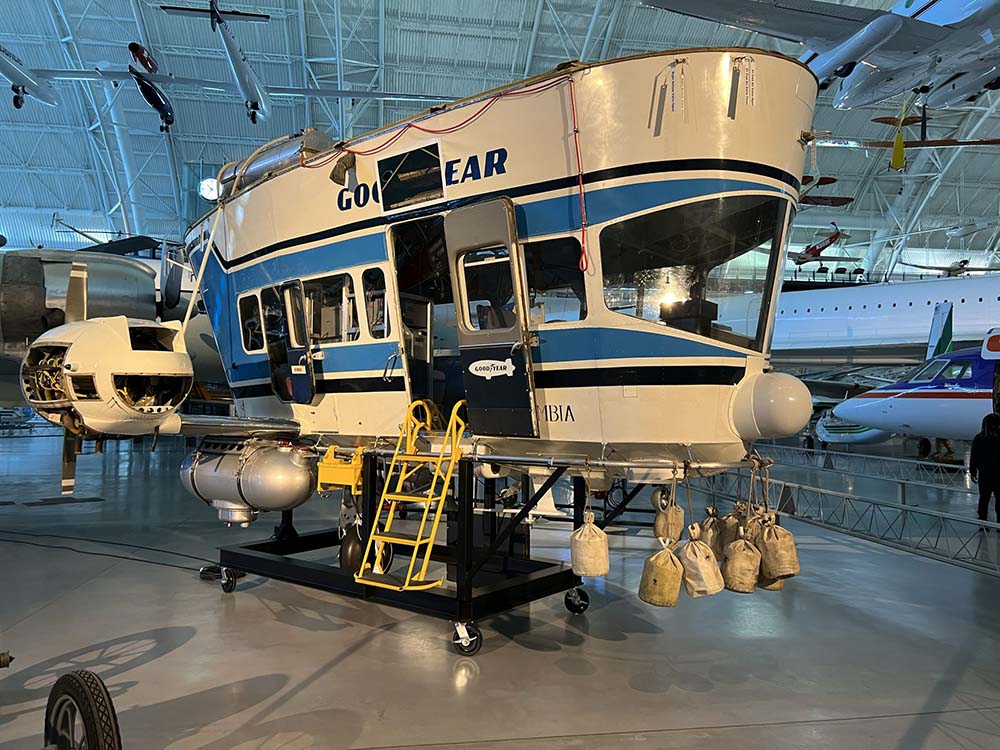
While many recognize the original Goodyear Blimp, few know that she was a WWII veteran. Operating as C-49, she patrolled for Axis subs and trained aircrews in blimp operations.
Repurchased by Goodyear after the war, she remained in regular service until 1986.
Photo taken 20 October 2022.
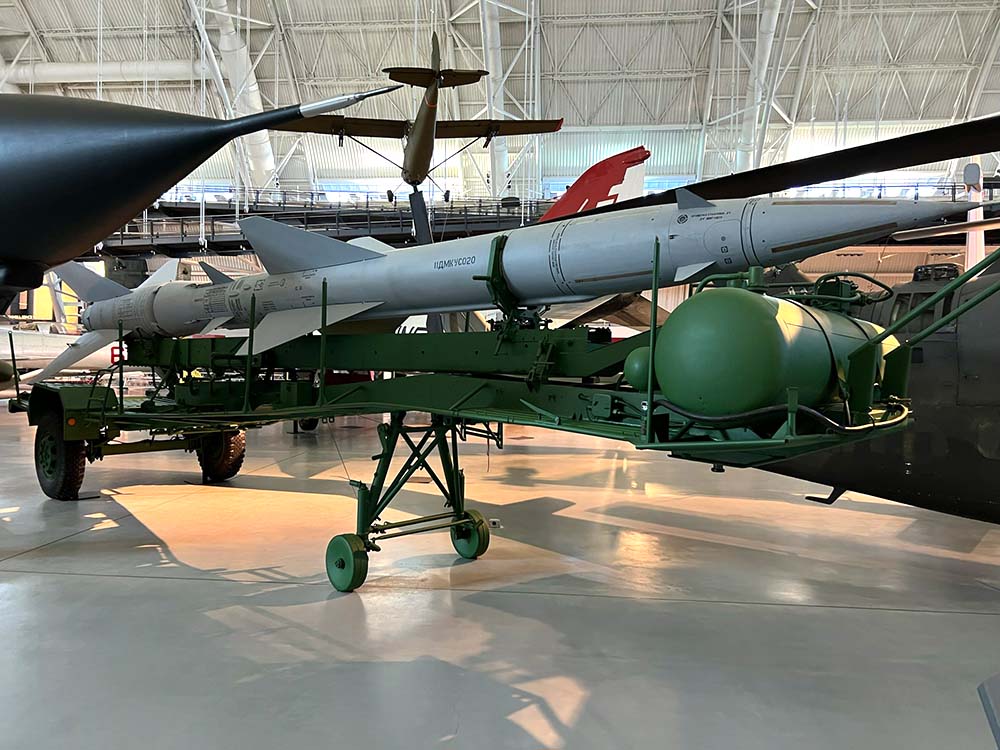
The SA-2 GUIDELINE, properly titled the S-75 Dvina, remains the most preeminent surface-to-air missile (SAM) in military history.
Best known for the downing of Lockheed U-2 pilot F. Gary Powers in 1960, these missiles were also a major issue during the Vietnam War.
For example, throughout Operation LINEBACKER II – the sole strategic heavy bombing campaign of the war – North Vietnam launched 884 SAMs, downing 15 B-52s. All in a period of seven days.
Photo taken 20 October 2022.
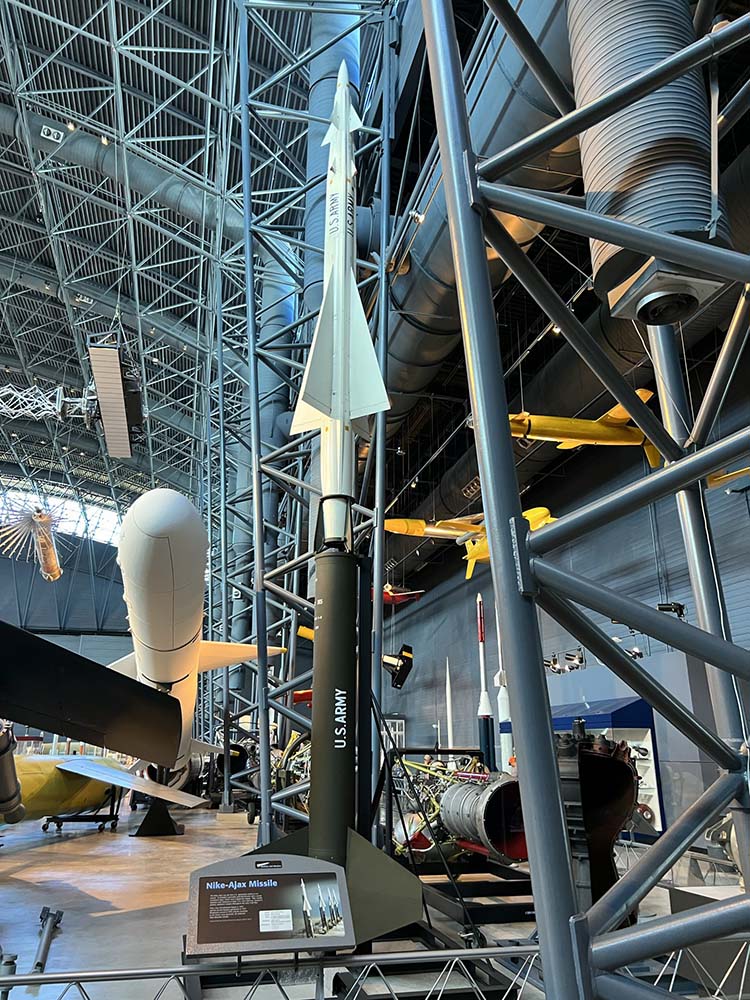
As part of Project NIKE, the MIM-3 Ajax was the first successful surface-to-air missile. On 27 November 1951, it was successfully tested over White Sands, New Mexico, downing a Boeing B-17 drone.
The competing design, the CIM-10 BoMARC, was first tested on 23 October 1957 off the coast of Florida. Again, the target aircraft was a WWII-surplus Boeing B-17.
Photo taken 22 October 2022.

Hangar Thirteen volunteer Chris Wilkinson poses under the engines of the Space Shuttle Discovery.
Photo taken 22 October 2022.
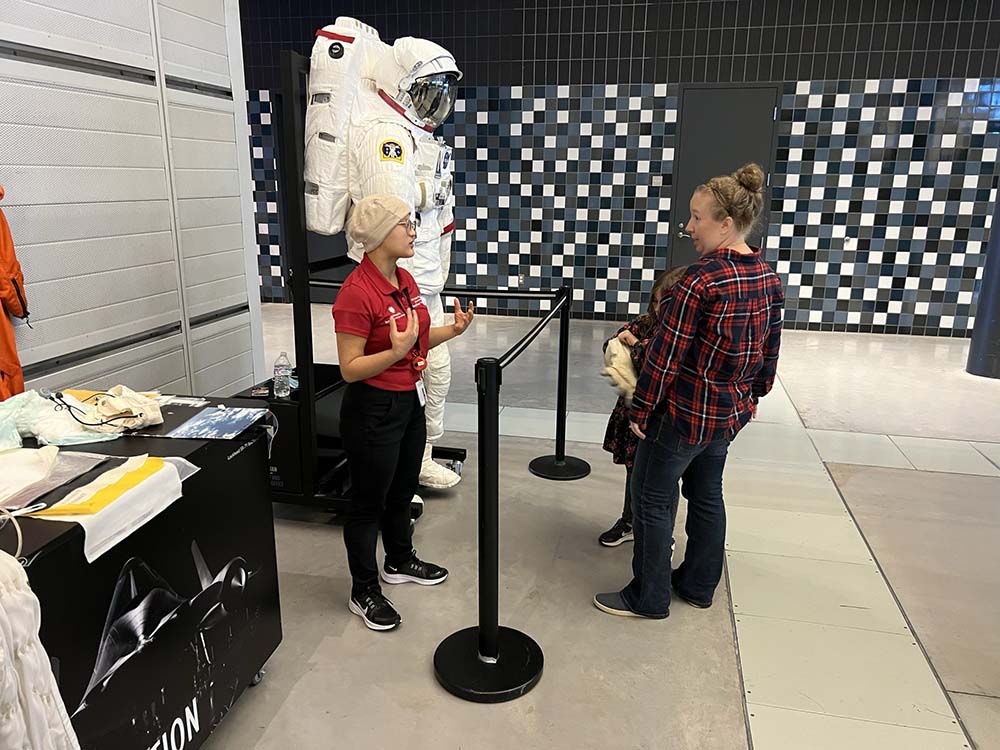
Though we did not get her name, we wanted to highlight the young lady in the hat.
A National Air and Space Museum, Smithsonian Institution volunteer, she manned a display covering the construction of NASA spacesuits.
She did a fantastic job and we wanted to recognize her in some way.
Photo taken 22 October 2022.

The Martin B-26 Flak Bait under restoration at the National Air and Space Museum, Smithsonian Institution’s Udvar-Hazy Center.
While the nose section was on display for many years downtown, the rest of the aircraft has been in storage since the war.
Photo taken 20 October 2022.
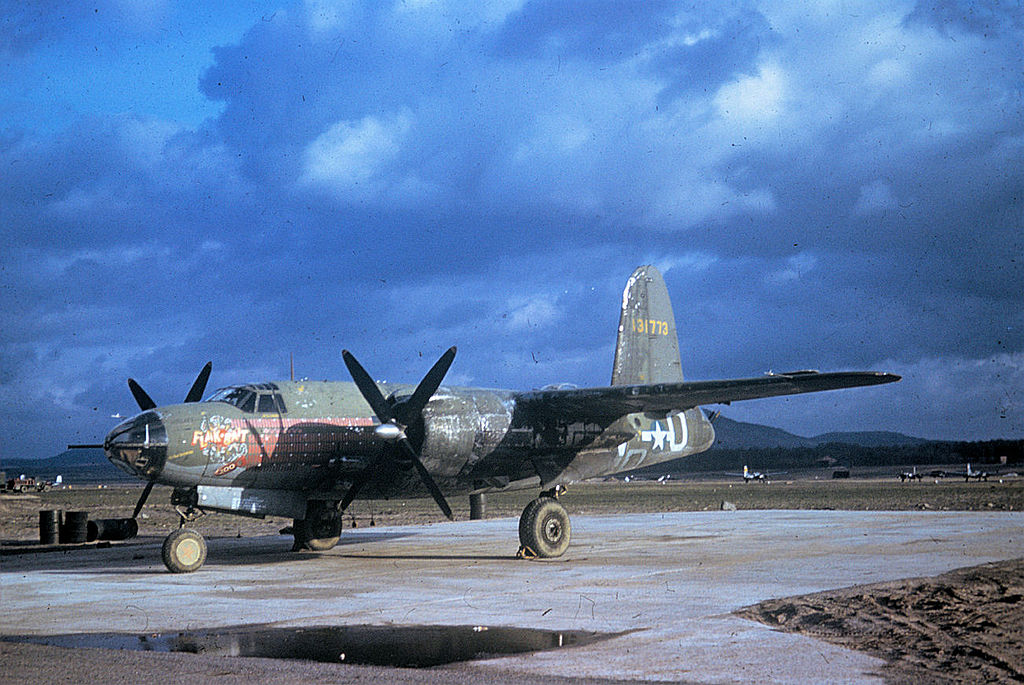
Flak Bait as she appeared in 1944.
Flak Bait few some 207 combat missions during the war and holds the current record for operational sorties by a US military aircraft.
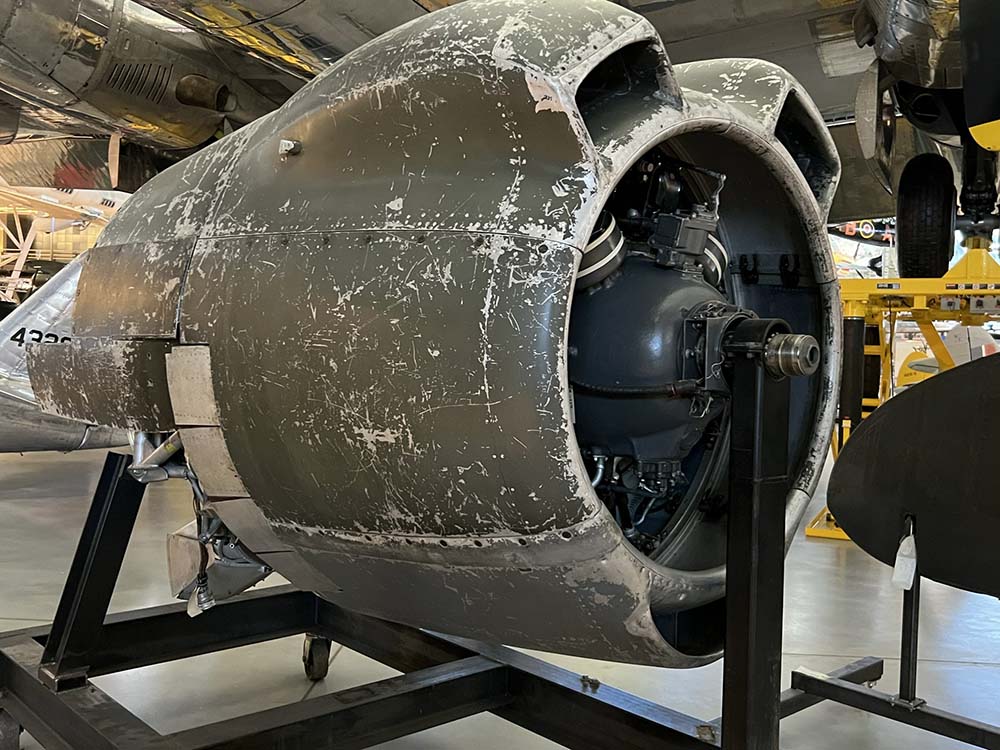
One of the engines, along with the rudder, from Flak Bait are displayed alongside the Boeing B-29 Enola Gay now that they are cleaned.
Flak Bait entered service just two months prior to Lucky Thirteen – the Boeing B-17F which we are currently rebuilding.
Photo taken 20 October 2022.
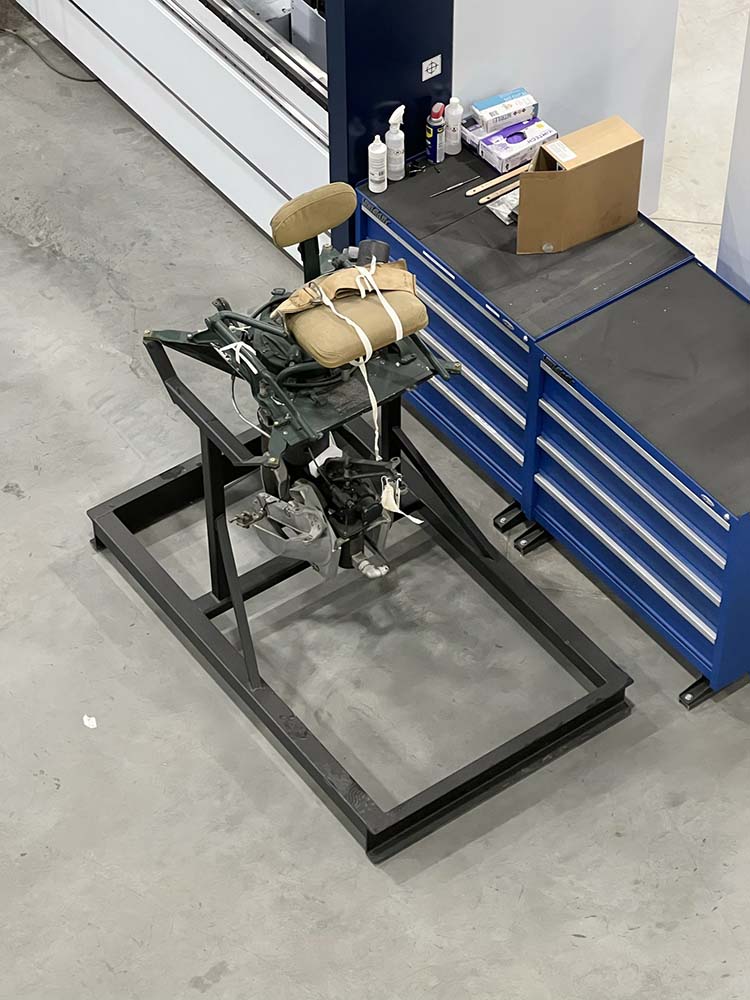
The chin turret for Boeing B-17G Shoo Shoo Baby sitting in the National Air & Space Museum’s restoration facility.
The Cramer chair is incorrect. B-29 chairs were upholstered with olive drab canvas while B-17 chairs were upholstered with dark green vinyl.
Photo taken 20 October 2022.
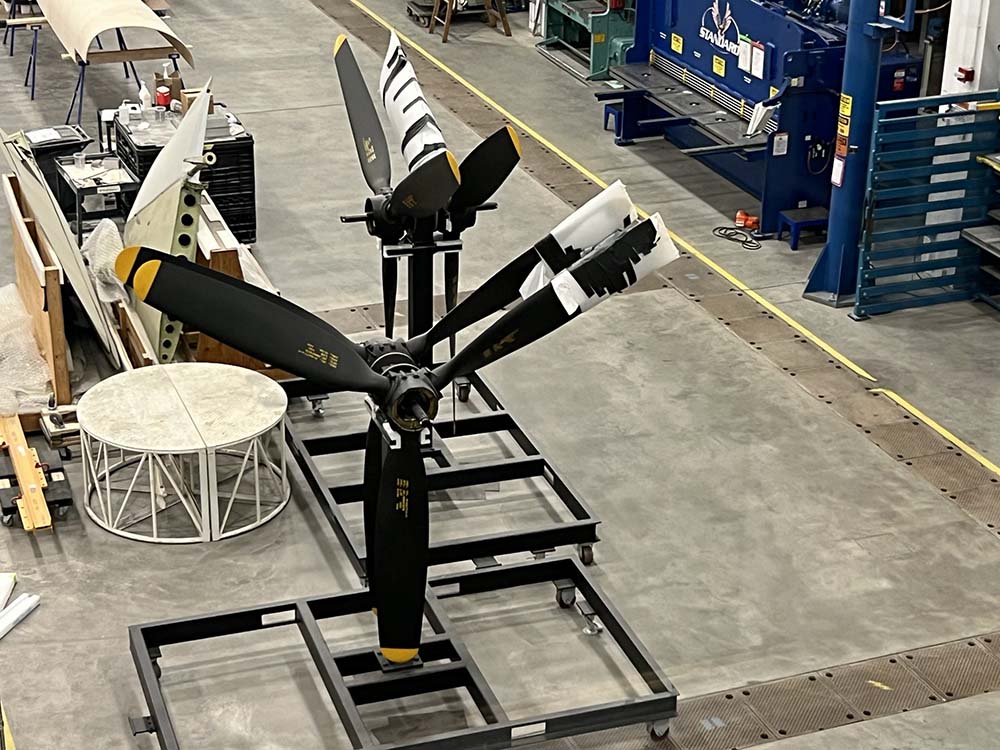
The props for Boeing B-17G Shoo Shoo Baby sitting in the National Air & Space Museum’s restoration facility.
Shannon showed me something interesting about wartime blades that many restorations get wrong – the yellow tips were not originally painted on the back of the blades!
Photo taken 22 October 2022.

The engines from Boeing B-17G Shoo Shoo Baby in a roped-off section of the National Air and Space Museum, Smithsonian Institution’s Udvar-Hazy Center.
We spoke at length with a docent about Shoo Shoo Baby, saying that we had tried to contact the museum about her before. He had never heard she was originally unpainted. Who knows? Maybe we had an effect.
Photo taken 22 October 2022.
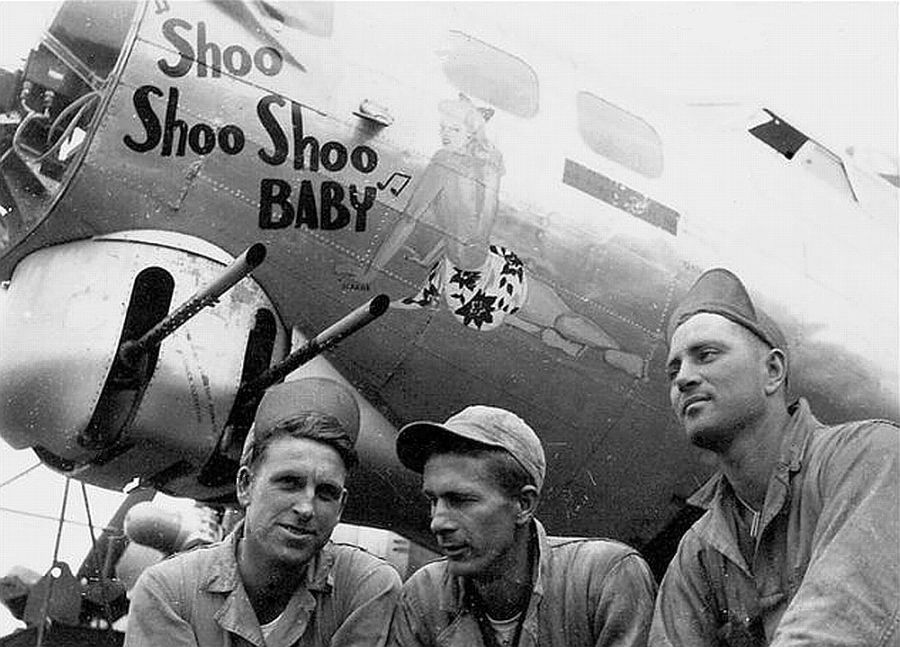
Shoo Shoo Baby (42-32076, 91BG) while in service.
Shoo Shoo Baby is one of four surviving B-17 combat veterans today, having survived the war after landing damaged in neutral Sweden on 26 April 1944.

The stabilizers and bomb-bay doors from Boeing B-17G Shoo Shoo Baby in a roped-off section of the National Air and Space Museum, Smithsonian Institution’s Udvar-Hazy Center.
If they intend to be accurate, both the interior and exterior fuselage paint from Shoo Shoo Baby will have to be removed – such as on the bomb bay doors here.
Photo taken 22 October 2022.
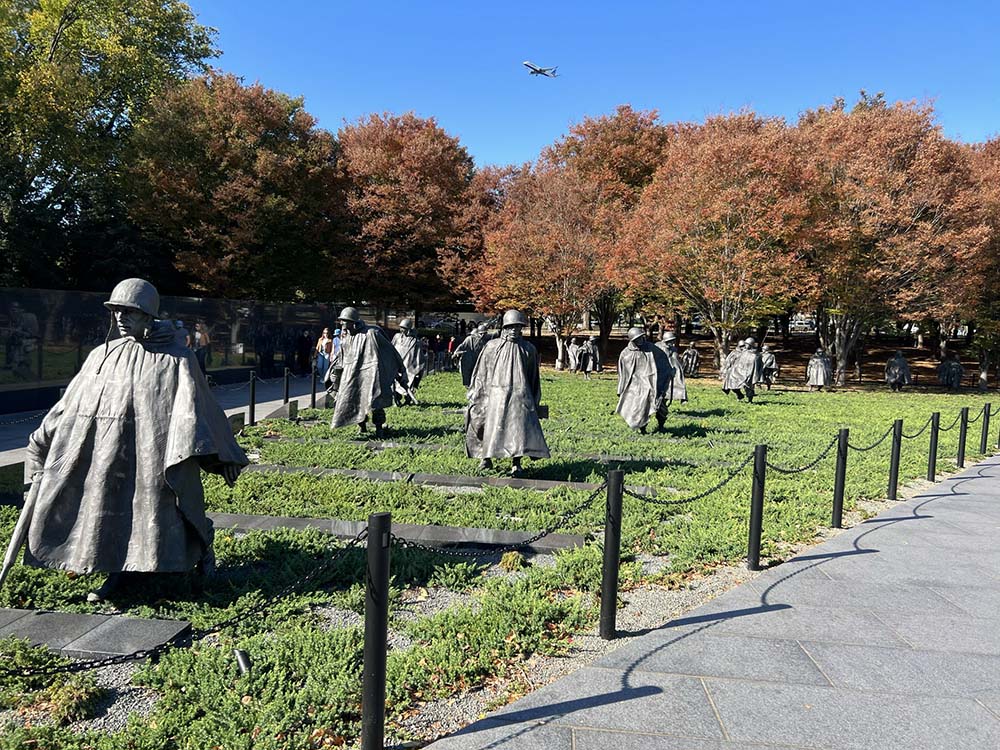
A special place for my family: the Korean War Memorial.
My grandfather served in the Korean War.
Photo taken 21 October 2022.
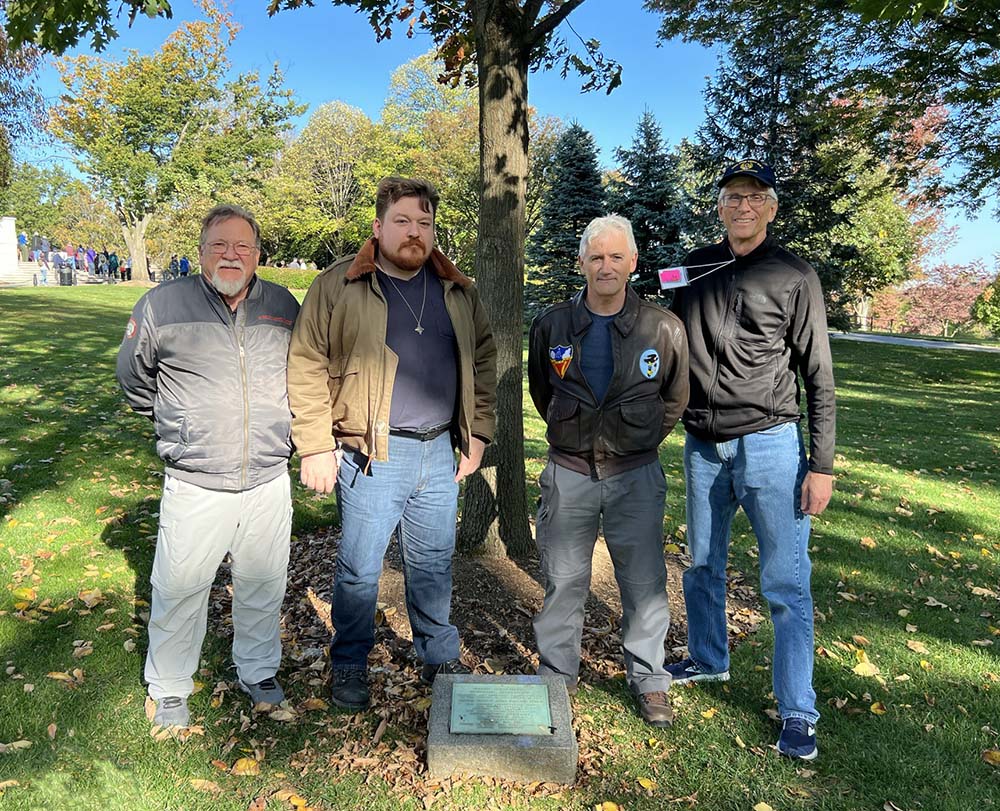
This is what it is all about:
Neil Howarth, Chris Wilkinson, my dad and I pose with the Second Schweinfurt Memorial at Arlington National Cemetery. Lucky Thirteen participated in the first Schweinfurt strike and, when completed, will represent the brave airmen who fought in the vicious air battles of latter-1943.
Chris read aloud CO 384BG COL Budd J. Peaslee’s original dedication, which was heart-wrenching.
Photo taken 20 October 2022.
Every donation that comes to us, financial and material, is precious. It is people like you who turn dreams into reality.
Here are a few new donations to share:
First is a pair of Type G-1 Oxygen Tanks from Hans Johsens of Honda, California. Hans is an awesome guy with an eclectic background, so we could (and did) talk for hours. Hans first offered these tanks back in January, but time got away from me in following up. That did not stop Hans, and he diligently packed the tanks and sent them on anyway. I dare say that these are probably the most well packed pieces to have come to this project! Thanks Hans!
The Type G-1 Oxygen Tank was the most common oxygen tank on US Army aircraft in the Second World War. A stainless-steel low-pressure cylinder, the G-1 was 24.5 inches long and had a capacity of 29 cubic feet. In contrast to the heavy, high-pressure tanks often found on British aircraft, the G-1 was relatively light, weighing just under 20 pounds. The Boeing B-17 carried 18 of these tanks, divided into four separate systems operating at a recommended maximum pressure of 400 pounds per square inch. Thanks to Hans’s donation, we are now just four tanks away from a full complement for Lucky Thirteen. Once we have a full set of tanks, they will all be stripped and refinished.
Next is a Nacelle Junction Box from a Type B Electronic Turbocharger Control System, made by Minneapolis-Honeywell – the same company which produced the B-17’s autopilot system.
The B-17 was noteworthy as one of the first mass-produced aircraft to take advantage of turbocharged engines. Simply speaking, the higher an aircraft flies, the lower the air pressure. This means that the engine loses power as it tries to mix fuel and air for combustion. The solution is to compress the air. During the Second World War, this was usually accomplished through mechanical superchargers driven by the engines themselves. By contrast, turbochargers accomplished this same goal using exhaust gases rather than mechanically driven gears.
The B-17’s turbos are relatively easy to spot, being the round pieces just in front of each engine exhaust. F-model B-17s used Type B-2 Turbochargers, which produced some 23,500 RPM, while G-models, starting in January 1944, used the Type B-22, producing up to 26,000 RPM. Still, the most drastic change came in October 1943 with the Electronic Control System. One of the easiest ways to differentiate a B-17F from a B-17G, this system removed the older hydraulic turbo controls – with had an individual lever for each engine – and replaced them with a single large control knob electrically controlling all four.
This particular piece was donated by Alan Stanczik of Countryside, Illinois, who insisted on its donation even though it was not applicable to Lucky Thirteen. Thanks Alan!
Since the throttle column for Lucky Thirteen had manual turbos, this makes our task significantly more difficult. An opportunity for an original F-model throttle column was lost to some time back when a collector was able to raise more money than us. Unless we are shockingly fortunate, it is likely that we will be forced to build the throttle column from scratch.
Last is a pair of dataplates made by our friend Tom Morely of Siler City, North Carolina.
Tom has a side-business doing metal etching, and we approached him some months back for help recreating the dataplate for the rebuilt instrument panel. Replicas are commercially available, but they are not perfect matches for the original, both in material and in design. Four different layouts exist for original B-17 dataplates (Boeing, Douglas, Vega, and Lockheed), with each having their own distinctive characteristics. Since recreating original wartime graphics is one of our specialties, we were able to recreate the layouts for each company’s B-17 dataplate. We sent the correct .051 aluminum to Tom and he was able to etch a pair of plates for the project (never hurts to have a backup). Thanks Tom!
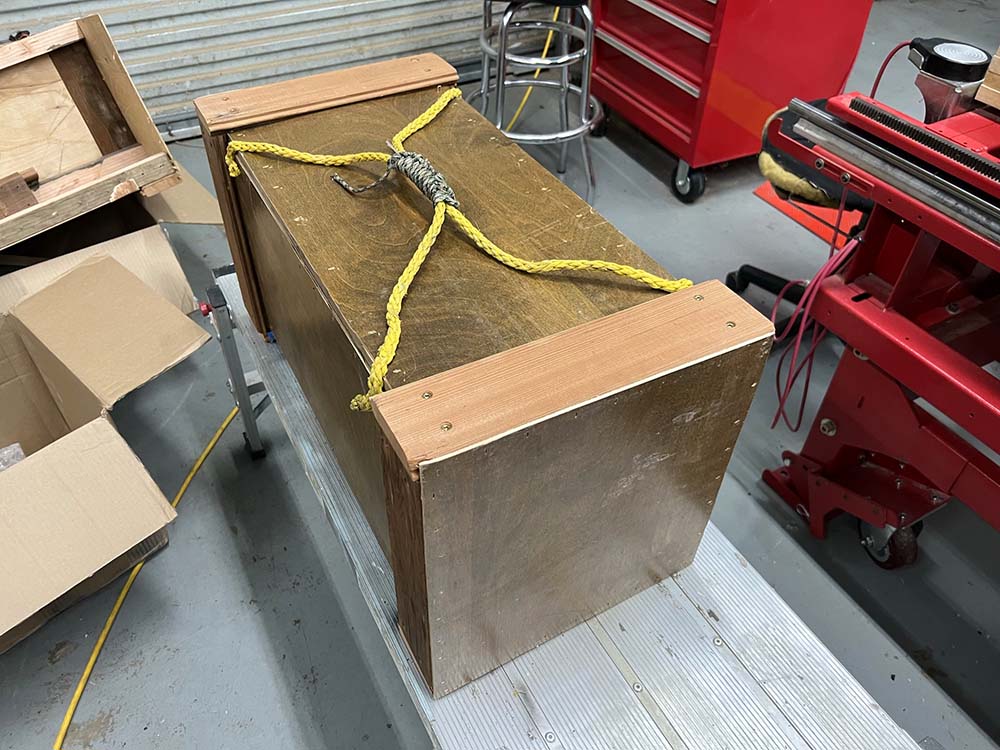
One of the two custom crates Hans Johsens built for shipping his Type G-1 Oxygen Tanks.
Photo taken 2 September 2022.
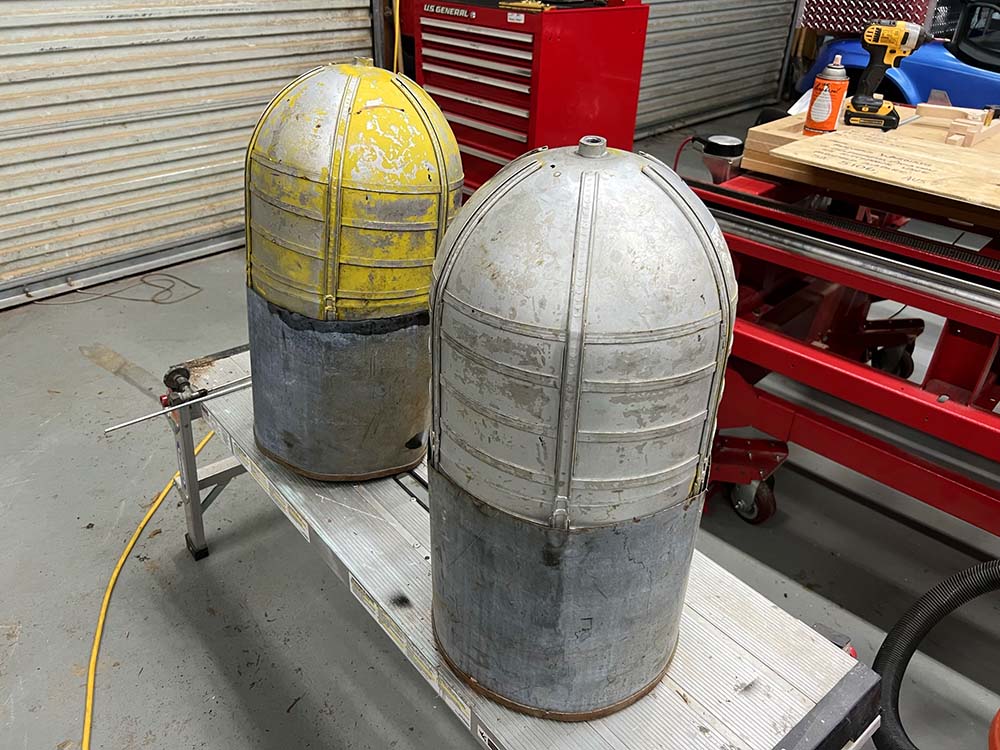
One of the most common uses for G-1 Oxygen Tanks after the war was converting them into air bubbles. Here the valves have been removed before removing their custom stands.
Photo taken 2 September 2022.

The newly-donated Type G-1 Oxygen Tanks are back to wartime spec.
We will clean and restore them once we have a full complement of tanks for the airplane. Only four more to go!
Photo taken 6 September 2022.
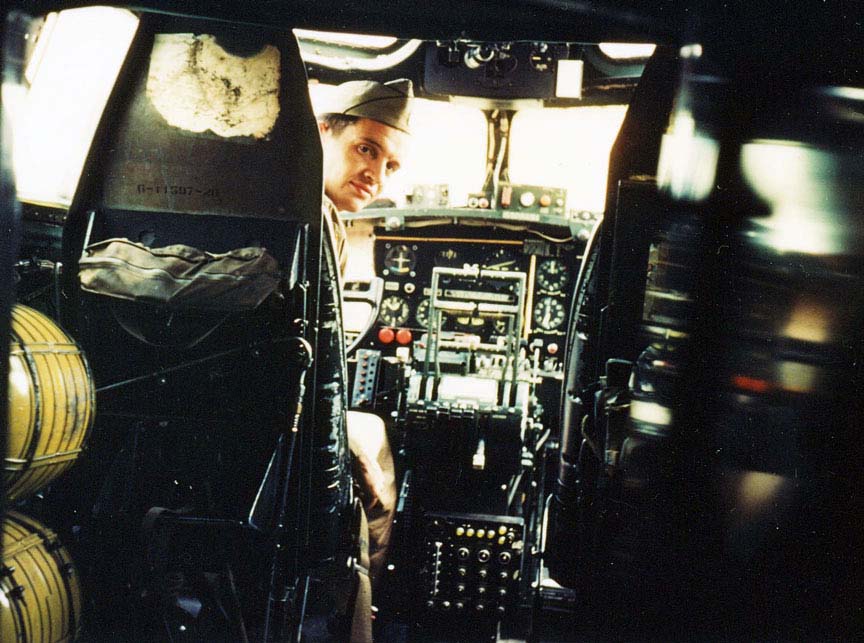
1LT Bob M. Welty of the 398BG peers over the armor plate on his seat.
Note the Type G-1 Oxygen Tanks on the far left. Upwards of eight tanks were kept in the cockpit on either side of the upper turret.
Note the large black knob just forward of the throttle levers – this is the control knob for the electric type turbocharger system.
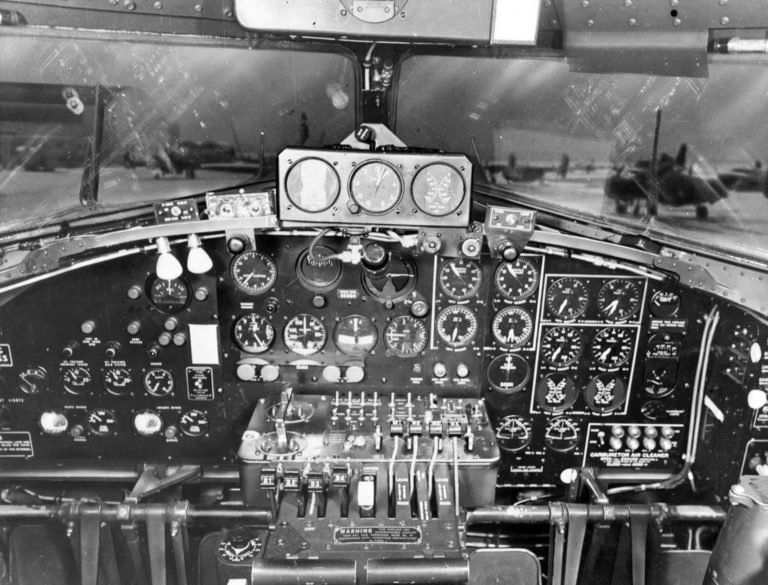
The cockpit to an F-model B-17, slightly older than Lucky Thirteen.
Note the four levers on the left side of the center column. This is the older, manual turbocharger system.
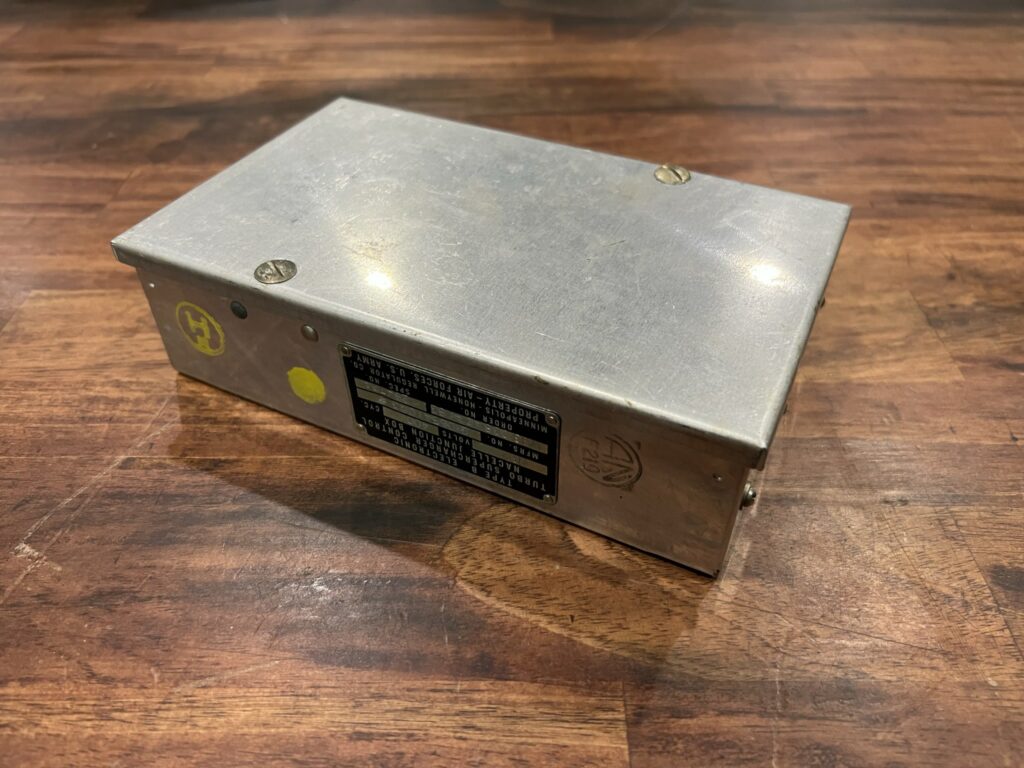
The Nacelle Junction Box for a Type B Electronic Turbocharger System donated by Alan Stanczik. This piece is NOS.
Photo taken 11 September 2022.
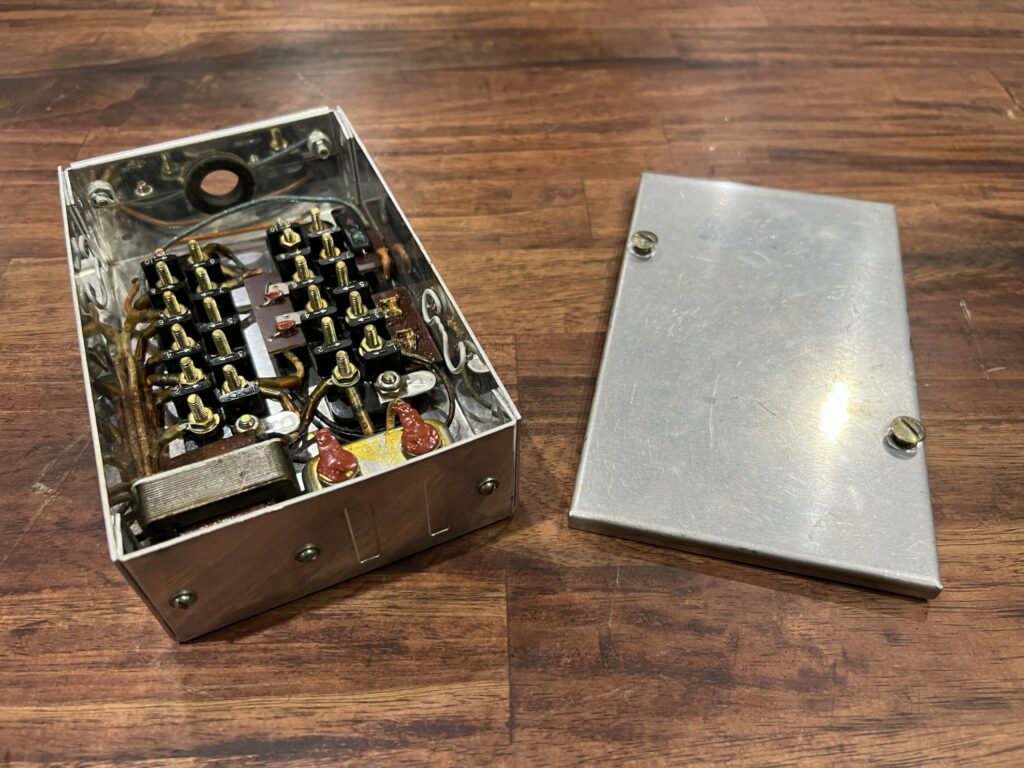
The newly donated Nacelle Junction Box for a Type B Electronic Turbocharger System opened for review.
Smells like history.
Photo taken 11 September 2022.
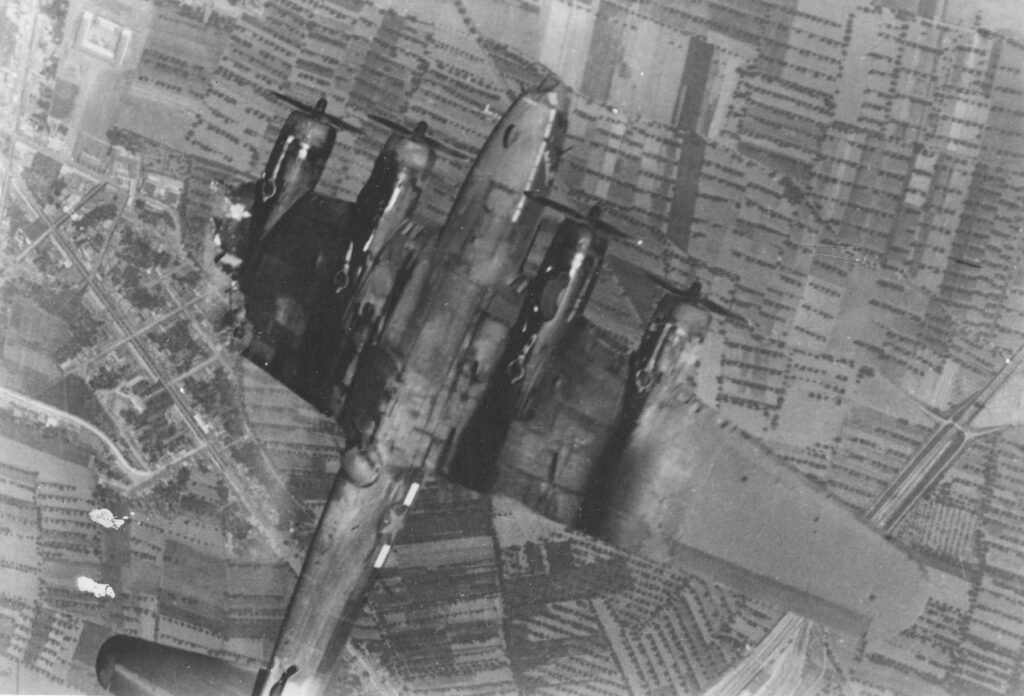
Nutcracker (42-2985, 97BG) is shot down by AAA fire over Naples, Italy. There were five survivors: the bombardier, navigator, pilots, and flight engineer. The pilot, Robert Last, was a local, coming from Columbia, South Carolina.
The turbochargers under each engine are clearly visible here.
Photo taken 1 August 1943.

The newly finished replica dataplates made by Tom Morley.
Photo taken 7 September 2022.
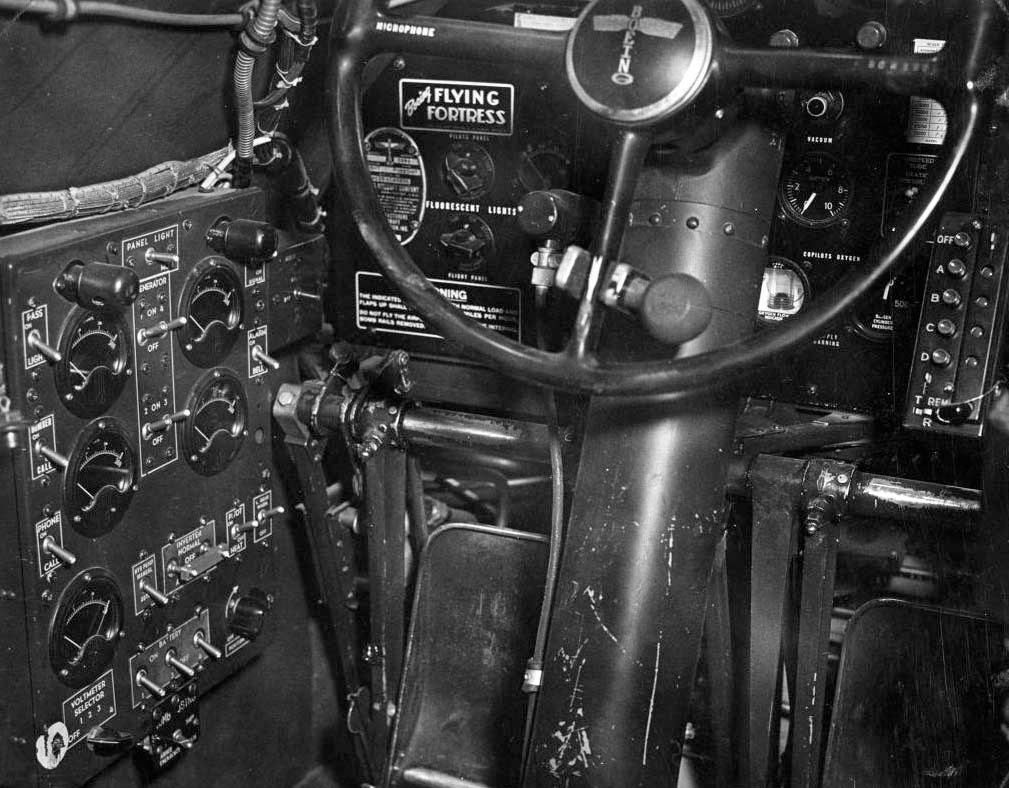
The factory dataplate on the B-17 was mounted to the far left of the cockpit instrument panel, as is the case on this Boeing built B-17F.
The Army dataplate, a simple square piece, was mounted in the back by the waist entrance.
Note the Type A-1 Oxygen Flow and Type K-1 Oxygen Pressure Gauges.
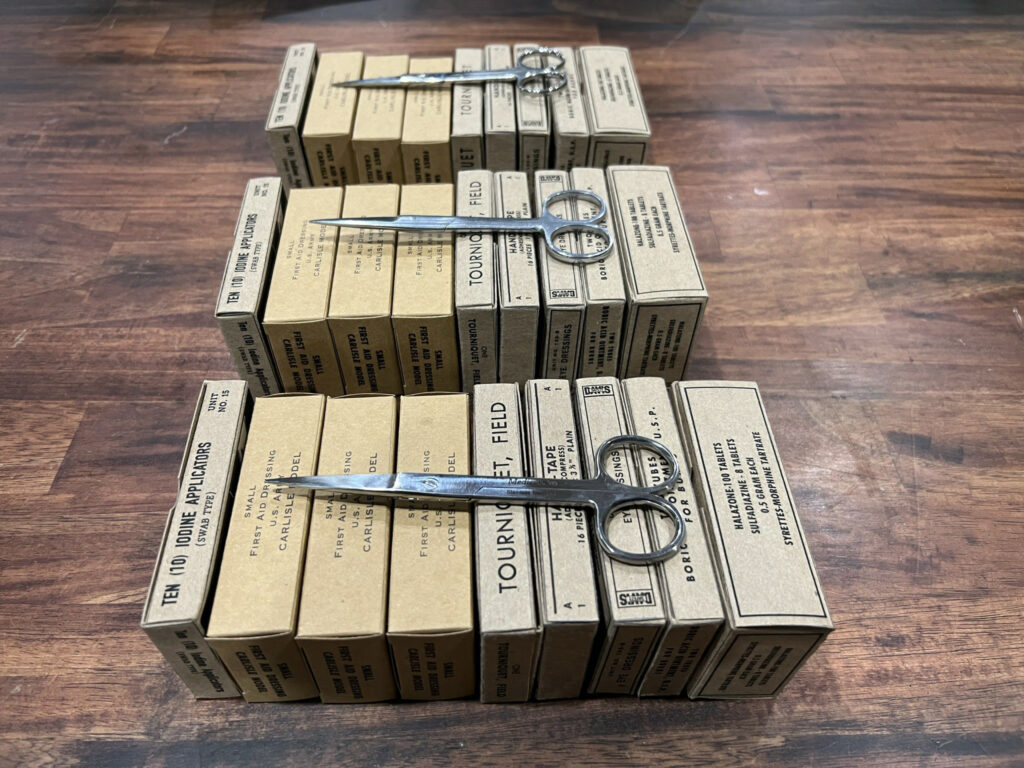
Something not mentioned in the main write-up – refills for the bomber’s three first aid kit pouches.
Photo taken 11 September 2022.

The nose, cockpit, and radio compartment were each equipped with a First Aid Kit (Aeronautic) Pouch. The waist was equipped with a Bullard First Aid Kit Can.
These pouches varied in design, but judging from photos, it appears that the most common was the type shown here.
An original was purchased by Hangar Thirteen and loaned to TheRiggerDepot for replication. Joshua recreated these pouches for Lucky Thirteen, Memphis Belle and the Douglas C-47 Night Fright.

The First Aid Kits for Lucky Thirteen are refilled.
